by Leon Reed Special Correspondent to Civil War News

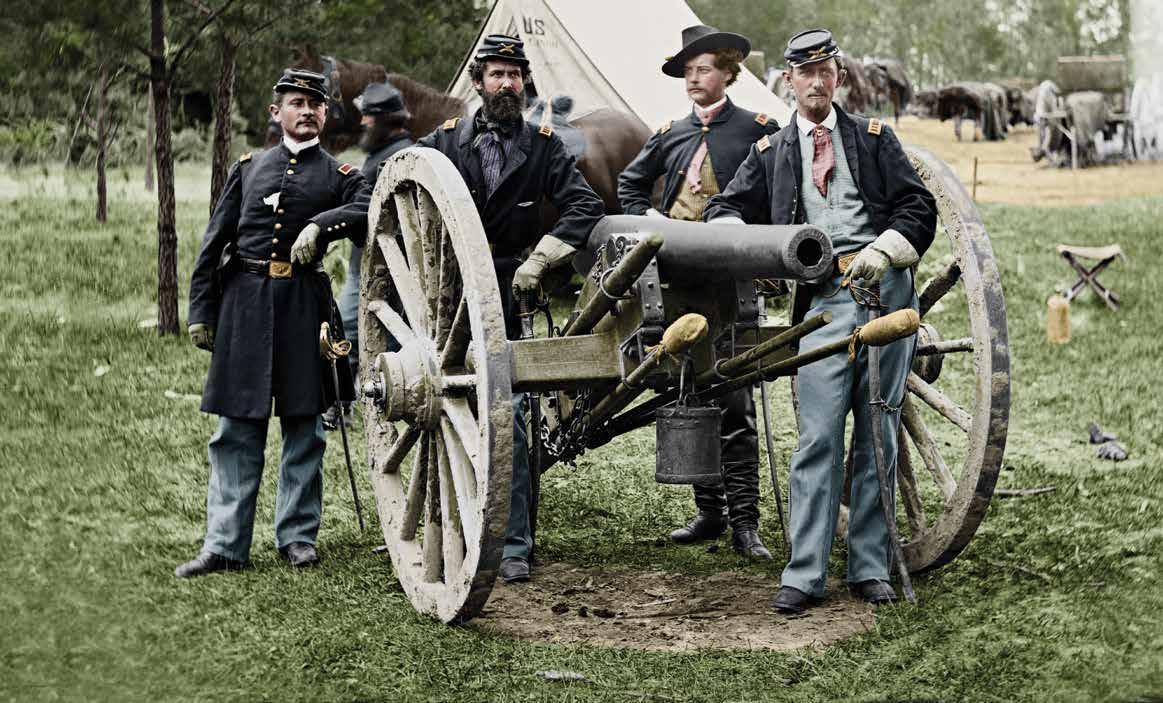
Nearly 300 Lincoln scholars and enthusiasts gathered in the days preceding Dedication Day at Gettysburg’s Wyndham Hotel for the 26th Annual Lincoln Forum Symposium, “Abraham Lincoln and the New Birth of Freedom.”
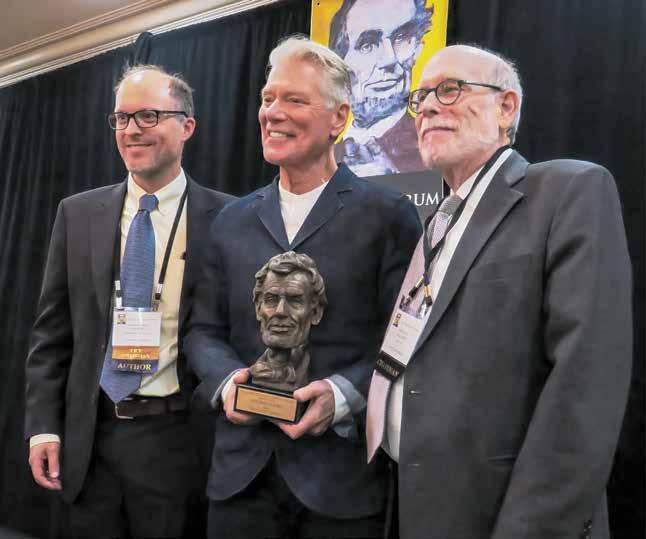

Forum chair Harold Holzer, Director of the Roosevelt House Public Policy Institute at Hunter College, was excited to be able to meet live after a year’s absence. “Although we tried our best to stay connected last year over
Zoom, there is still nothing like a live symposium that includes shared meals, experiences, lectures, small-group discussions, and opportunities for Q&A. The Forum is more than a meeting; we like to describe ourselves as a ‘family,’ “so it was really thrilling to see all those people in the ballroom.”
Vice chair Jonathan White, Associate Professor of American Studies at Christopher Newport University, echoed the benefits of meeting live. “We really value the idea of the Forum as a family, and you can see that in how our speakers interact with each other and with symposium attendees. I think our speakers really enjoy talking with Forum members. Our members are very knowledgeable about Abraham Lincoln and the Civil War and that leads to great conversations with the speakers, not only during the sessions, but also in the hallways and at meals.”
The conference was organized as separate panels and presentations, but there were many interesting overlaps between some presentations. The broad topics addressed by multiple speakers and panelists included: events and places that impacted Lincoln’s beliefs and

his attitudes about slavery, and the path to emancipation.
Special presentations departing slightly from the Lincoln theme were “How Should Americans Understand Gettysburg in 2021?” by Gary Gallagher, a presentation
on Juneteenth by Annette Gordon-Reed, and the process of finalizing the surrender after Lincoln’s assassination, by Caroline E. Janney.
Influences on Lincoln’s Development
A panel discussed the influence of Springfield on Lincoln’s development. Participants were Erin Carlson Mast, CEO of the Abraham Lincoln Presidential Library Foundation; Sam Wheeler, Illinois state historian; Kathryn Harris, retired head of the Library Division of the Abraham Lincoln Presidential Library; and Christian McWhirter, a historian at the Lincoln Presidential Library.
Vol. 48, No. 1 48 Pages, January 2022 $3.50 America’s Monthly Newspaper For Civil War Enthusiasts 10 – American Battlefield Trust 40 – Book Reviews 32 – Central Virginia Battlefield Trust 36 – Emerging Civil War 45 – Events 28 – The Graphic War 22 – The Source 12 – Through the Lens 16 – This And That 29 – Trivia 8 – The Unfinished Fight H Lincoln Forum . . . . . . . . . . . see page 4
Springfield panel: Erin Carlson Mast, Sam Wheeler, Kathryn Harris, and Christian McWhirter. All photos by Leon Reed.
Richard Nelson Current Award of Achievement presented to Stephen Lang (center), by Vice Chair Jonathan White (left) and Forum Chair Harold Holzer (right). his growth as a statesman and politician; Lincoln’s leadership and statesmanship; Lincoln’s understanding of the Constitution,
“Ending the War” presenter Caroline E. Janney.
Civil War News
Published by Historical Publications LLC



520 Folly Road, Suite 25 PMB 379, Charleston, SC 29412 800-777-1862 • Facebook.com/CivilWarNews mail@civilwarnews.com • civilwarnews.com
Advertising: 800-777-1862 • ads@civilwarnews.com

Jack W. Melton Jr. C. Peter & Kathryn Jorgensen
Publisher Founding Publishers

Editor: Lawrence E. Babits, Ph.D.
Advertising, Marketing & Assistant Editor: Peggy Melton
Columnists: Craig Barry, Salvatore Cilella, Stephanie Hagiwara, Gould Hagler, Tim Prince, John Sexton, and Michael K. Shaffer
Editorial & Photography Staff: Greg Biggs, Michael Kent, Bob Ruegsegger, Gregory L. Wade, Shannon Pritchard, Carl Sell Jr., Joan Wenner, J.D.
Civil War News (ISSN: 1053-1181) Copyright © 2021 by Historical Publications LLC is published 12 times per year by Historical Publications LLC, 520 Folly Road, Suite 25 PMB 379, Charleston, SC 29412. Monthly. Business and Editorial Offices: 520 Folly Road, Suite 25 PMB 379, Charleston, SC 29412, Accounting and Circulation

Offices: Historical Publications LLC, 520 Folly Road, Suite 25 PMB 379, Charleston, SC 29412. Call 800-777-1862 to subscribe.
Periodicals postage paid at U.S.P.S. 131 W. High St., Jefferson City, MO 65101.
POSTMASTER: Send address changes to: Historical Publications LLC 520 Folly Road Suite 25 PMB 379 Charleston, SC 29412
Display advertising rates and media kit on request. The Civil War News is for your reading enjoyment. The views and opinions expressed herein are those of its authors, readers and advertisers and they do not necessarily reflect the official policy or position of Historical Publications, LLC, its owners and/or employees.
P
UBLISHERS :
Please send your book(s) for review to: Civil War News
520 Folly Road, Suite 25 PMB 379 Charleston, SC 29412
Email cover image to bookreviews@civilwarnews.com. Civil War News cannot assure that unsolicited books will be assigned for review. Email bookreviews@civilwarnews. com for eligibility before mailing.

ADVERTISING INFO:
Email us at ads@civilwarnews.com Call 800-777-1862
MOVING?
Contact us to change your address so you don’t miss a single issue. mail@civilwarnews.com • 800-777-1862
SUBSCRIPTION RATES
U.S. Subscription rates are $41/year, $71/2 years, digital only $29.95/year, add digital to paper subscription for only $10/year more. Subscribe securely at CivilWarNews.com
Announcement
Coming Soon! A brand new fullcolor 80-page, glossy magazine for the Military Antique Collector. The publication will spotlight rare and unusual military objects, beautiful craftsmanship works, and historical figures dating from early American and European history to limited coverage of the post-1898 artifact. This magazine will not be focused on relic hunting or artifact digging. The
By Jack Melton
sample layout below is only one of the page formats. Stay tuned for a launch date. Email us at: mail@militaryantiquecollector.com to signup for the email blast and post notifications.
We have known Tim Prince for at least two decades. He is one of the most knowledge people on antique firearms in the country. This knowledge led him to a spot on the TV show Antiques
Roadshow as an appraiser. Civil War News has been blessed to publish Tim’s columns. We couldn’t have asked for a more upstanding historian, author, and dealer, than Tim. If you ever attend one of the 25+ shows he sets up at stop by and visit with him. Tim will continue to work with us in our new magazine, Military Antique Collector. In the February Civil War News we will have more information on the new magazine.
Moving On and Thank You
I would like to thank everyone who has read the articles I have written for Civil War News over the last few years. I have enjoyed the writing opportunity Jack Melton offered me with this publication, and I hope that most of you have enjoyed reading what I wrote. However, after 63 articles, it is time to move on.


Jack has a new publication project that will be launching in the spring; Military Antique Collector magazine, and I am honored that he has asked me to be a part of this new magazine. As most of you know, I am a fulltime dealer in antique arms, and also a “one man” business. I do everything myself, from finding the items I sell, photographing them, researching them, describing them, putting them on the website, and then shipping
them to the buyer. As a result, between maintaining my website, traveling to the many shows that I attend, doing the appraising and consulting that I do, attending Antiques Roadshow tapings, it has been hard to find time to write the quality articles for Civil War News that you have come to expect from me. This new publication will be a bi-monthly magazine, helping reduce my work load a little and will better fit with my available time to write. By the same token, the new magazine will allow me to branch out and write about arms that are not specifically related to the Civil War. I am really looking
forward to exploring some new fields with the readers.
I am not leaving the team of writers at Civil War News completely, but I will probably only be contributing a couple of articles a year in the future. For those of you who want to continue reading about the various arms that I find interesting, I hope you will subscribe to Jack’s new periodical. Based upon the sample issue that I have seen; it will be a very high-quality publication. So, this is not so much a “goodbye,” but more of an, “until we meet again.” I hope you will be reading my new work very soon.

2 CivilWarNews.com January 2022 2 January 2022 CivilWarNews.com
CIVIL WAR AUTOGRAPHS LETTERS • DIARIES • STAMPS • CURRENCY Price List Online • Top Price Paid for Quality Material B. M. GREEN P.O. Box 1816N Kernersville, NC 27285-1816 (336)993-5100 • (336)993-1801 www.shop.bmgcivilwar.net bmgcivilwar@triad.rr.com Letters to the Editor: Please email: mail@civilwarnews.com
WNC Ag




1301 Fanning Bridge Road
Fletcher, NC
Jan. 8 & 9, 2022
Dalton Convention Center 2211 Dug Gap Battle Rd
Dalton, GA 30720





Jan. 29 & 30, 2022
Myrtle

Myrtle Beach, SC 29579
Feb. 5 & 6, 2022
Mike Kent & Associates, LLC • PO Box 685 • Monroe, GA 30655 770-630-7296 • Mike@MKShows.com • www.MKShows.com Military Collectible & Gun & Knife Shows Presents The Finest Williamson County Ag Expo Park 4215 Long Lane Franklin, TN 37064 Dec. 3 & 4, 2022 Middle TN (Franklin) Civil War Show Promoters of Quality Shows for Shooters, Collectors, Civil War and Militaria Enthusiasts
Exchange Park Fairgrounds 9850 Highway 78 Ladson, SC 29456
2022
Show
Feb. 19 & 20,
Charleston Gun & Knife
Myrtle Beach Convention Center 2101 North Oak Street
Beach Gun & Knife Show
Center
Asheville Gun & Knife Show
Scan for all events
Dalton Civil War Show
H Lincoln Forum
from page 1
Wheeler noted that moving to Springfield “introduced Lincoln to a very diverse community,” first settled by people from the Upper South, “then the middle states, then New England. You didn’t have the extreme stratification you had in the East.” The panel also discussed Lincoln’s marriage. Harris stated that, “The marriage was rough around the edges. But I believe they genuinely loved each other.” McWhirter added that “There was absolutely a connection between the two. Their letters indicate a very close relationship.” Wheeler added, “It was also a very close and important political alliance.” They all agreed that the marriage was critical in Lincoln becoming president.
In a panel discussing Lincoln’s and FDR’s leadership styles, Holzer noted that “Mary had an extraordinary influence on Lincoln. Both the Lincoln and FDR marriages were extraordinary, though also troubled.”
In his presentation on “Lincoln, the Founding, and an America
Worth Saving,” Washington and Lee University’s John K. Boardman Professor of Politics

Lucas Morel commented that there was “no greater influence on Lincoln than the ideas of the Founders, frequently stating that he never had an idea politically that did not come from the Declaration of Independence.”
Lincoln’s Leadership
Several panels specifically addressed Lincoln’s leadership and other speakers referred to presidential leadership as well. Forum Chairman Emeritus Hon.





Frank J. Williams led a panel consisting of Judge Dennis Curran, retired Massachusetts superior court justice and professor at Tufts University; Joseph Fornieri, professor of political science at Rochester Institute of Technology; and Ed Steers, author of several books on Lincoln’s assassination. When asked for examples of statesmanship, Ed Steers listed Lincoln’s advocacy of the Land Grant College Act and the Homestead Act, “which continue to affect us to this day.”
Joe Fornieri noted “his tenacity in defending the core principles
S. Grant Presidential Library at Mississippi State University, made note of the brutally critical letter President Lincoln wrote General Meade expressing his disappointment about Meade’s handling of the Gettysburg campaign, and then didn’t send. No matter how frustrated Lincoln was, he understood that blowing up at Meade wasn’t going to help win the war.
Constitution, Slavery and Emancipation
book prize for his book Lincoln’s Anti-Slavery Constitution, James Oakes, Distinguished Professor of History and Humanities Chair at the CUNY Graduate Center, agreed that President Lincoln considered the Constitution an anti-slavery document. Following up on Morel’s point, he stated Lincoln believed that “fencing slavery in would lead to ‘its natural demise’ while expansion would allow the enslavement of millions.”
of the Republican Party; he was willing to compromise but he wouldn’t give on the issue of expansion of Slavery.” Judge Curran add, “On the important principles, a leader must remain inflexible.”
A second panel, consisting of Forum Chair Harold Holzer and Craig Symonds, Professor of History Emeritus at the United States Naval Academy, contrasted “Lincoln and FDR: Lessons in Leadership.” The panelists pointed out both wartime presidents were excellent communicators. Although Lincoln made few public appearances, particularly when compared to the gregarious Roosevelt, he was a very effective communicator. Symonds added another characteristic the two men shared in common: “Patience.”
In a breakout session on military leadership, John F. Marszalek, Executive Director of the Ulysses
There was lively discussion among many speakers and panelists about Lincoln’s views on the Constitution, Slavery, and Emancipation. In a talk entitled “Lincoln, the Founding, and an America Worth Saving,” Lucas Morel pointed out Lincoln’s view that even enslaved people had natural rights was unusual at the time: “Both [William] Yancey [a
leading southern proponent of secession] and [Stephen] Douglas [the leading northern advocate for compromise and Union] believed the Declaration of Independence applied only to white men.” The issue of the status of slavery in the Constitution and whether the Constitution is a pro-slavery or anti-slavery document was controversial at the time and still is today. Speaking after being presented the 2021 Lincoln Forum
Oakes continued that “His view was that the Constitution generally favored freedom and that pro-slavery clauses were deplorable exceptions to ensure passage of the Constitution.” Constitutional provisions that can be considered as opposed to slavery, included the right to ban the slave trade, authority to create “all needful rules and regulations” for the territories, the 4th and 5th amendments, and reference to enslaved people as persons. “Beyond the text, the spirit of the document was clear, such as the purpose to “secure the blessings of liberty to ourselves and our posterity” Oakes concluded, “The Constitution made freedom the rule, slavery the exception.” Forum vice chair Jonathan
4 CivilWarNews.com January 2022 4 January 2022 CivilWarNews.com
. . . .
. . . . .
.
James Oakes, winner of the Lincoln Book Prize.
Panelist Kathryn Harris with first time attendee and teacher Robert Buccheri, dressed as a member of Duryee’s Zouaves (5th NY).
Lincoln’s Statesmanship: Judge Dennis Curran, Joseph Fornieri, and Edward Steers Jr.
Panel on Lincoln and FDR presenter Craig Symonds.
Military leadership session with John Marszalek (left), Craig Symonds.
“Lincoln and the Founding Fathers” presenter Lucas Morel.
White moderated a panel discussion on “Lincoln and African Americans,” with Michelle Krowl, Civil War and Reconstruction specialist in the Manuscript Division of the Library of Congress; Edna Greene Medford, Professor of History at Howard University; and Lucas Morel. White observed that Lincoln made remarks in the 1850s about black equality and other topics that are criticized today. Morel conceded that these remarks are troubling but also argued that modern analysts must consider the nature of the audiences he was addressing.
Gettysburg. “In the Lost Cause narrative, the #1 reason they lost is resources, and the second reason is that Longstreet sabotaged Lee at Gettysburg.”
A panel moderated by Gallagher and consisting of Ty Seidule, Professor of History Emeritus at the United States Military Academy, and Peter Carmichael, Robert C. Fluhrer Professor of Civil War Studies, addressed the issue at length. After the war, Seidule said, “Confederates realized they needed to isolate themselves from slavery.” It swept the country and affected Northern attitudes. “If you go to Grant’s Tomb, the painting makes Lee and Grant equal; you
don’t see much of Grant in the Lee Chapel at Washington and Lee.”
The panel discussed the iconic image of Lee. Gallagher conceded that Lee was on record decrying slavery as an evil institution, but Seidule pointed out that Lee engaged in hiring his slaves out, “the cruelest system.” Gallagher was asked if Lee had much to do with promoting the Lost Cause and answered “Actually, he slows it down.”
Gettysburg
Gallagher spoke on “How Should Americans Understand Gettysburg in 2021?” He first
addressed the “Turning Point” question, stating that many events in the war changed things.
“Ball’s Bluff was a major turning point; Vicksburg, of course, the 1864 Atlanta and Shenandoah Valley campaigns had important consequences. I think no battle had more impact on the war than the Seven Days. It showed Federal leadership that it was going to be a long war and made leadership understand that we’re not going to win this war without upping the ante. The Second Confiscation Act followed the collapse of McClellan’s campaign by only a few days and the campaign decided Lincoln on moving forward with the Emancipation Proclamation.”
invested with so much meaning by so many. … Few places offer so many opportunities to study terrain and leadership.” People on the field can understand in a way not possible in the classroom. The ground at Gettysburg is the best classroom. “Lincoln prophesied the world would never forget what happened at Gettysburg. I hope he’s right.”
Speaking during the Military Leadership breakout session, Symonds commented that he brought every class from Annapolis to Gettysburg. “It’s a marvelous teaching tool; nothing compares to being on the battlefield and seeing what they saw.”
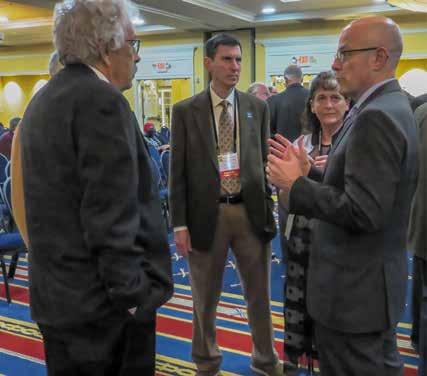

Medford noted Lincoln considered the inferiority he perceived “was a consequence of slavery. He believed it degraded them.” In his presentation on “Gettysburg,” Gallagher observed that Lincoln supported Emancipation “not as a moral crusade to win the war, but to punish slaveowners who brought on the war, and to deal with the only cause that could tear the country apart in the future.” Medford also noticed Lincoln’s pragmatic streak. She pointed out that at first Lincoln didn’t favor use of black soldiers but came around when he realized it was essential to winning the war. Later he was impressed with the bravery and discipline of black soldiers. “Lincoln originally didn’t expect this to happen; he changed his views.”
Lee and the Lost Cause
Many speakers addressed the Lost Cause and other aspects of Southern reaction to the war and their losses. In his talk about the meaning of Gettysburg, Gary Gallagher pointed out that even the Lost Cause is focused on
Gallagher commented, “I readily admit that very few places resonate more evocatively than this place … Where else have so many mundane pieces of ground; the Peach Orchard, Devil’s Den, the Wheatfield, been
Juneteenth
Best-selling author Annette Gordon-Reed, Carl M. Loeb University Professor at Harvard, gave a personal account of her experiences growing up in a


5 January 2022 5 January 2022 CivilWarNews.com CivilWarNews.com
Lincoln and African Americans Panel, Edna Greene Medford.
Lee panel with Peter Carmichael (left) and Ty Seidule.
Ty Seidule talking with Paul Ellis Graham, Chris Burn, Elaine Henderson.
largely segregated Texas and with local Juneteenth celebrations. “I was born and raised in Texas and I’m still a Texan. I was in New York during the pandemic, and this project gave me a chance to write something more personal.” She noted that the image of Texas, largely derived from TV and movies is that “Texas is a western state, not a southern state,” but that when she was growing up it retained many Southern elements. “Our celebrations of Juneteenth were partly about what happened that day and partly what happened later, after Reconstruction, and the creation of Jim Crow.” She







28th
also mentioned a group of four black men who in 1876 bought land in Houston to celebrate Juneteenth. “It’s still there, Emancipation Park. People who were in terrible circumstances kept moving forward.”

Post-Assassination



Caroline E. Janney, John L. Nau III Professor of the American Civil War at the University of Virginia, discussed ending the War after Lincoln’s assassination. She noted that Appomattox is often regarded for all practical purposes as the end of the war but that it really began a process. The Union high command recognized that “even with the surrender of main armies, the war might never end.” Paroling was considered a deterrent. “They believed men would be honor bound by the

6 CivilWarNews.com January 2022 6 January 2022 CivilWarNews.com Battle of Aiken 157th Anniversary of Sherman’s March Feb. 25-27, 2022 Union and CSA Infantry, Artillery, Cavalry, Medical, Musician and Civilian Impressions are needed. Preregister by Jan. 30 and the Barnard E. Bee Camp, SCV, will pay all registration fees! • Come to Sunny South Carolina and Participate in the 157th Anniversary Of Sherman’s March! • Three Scripted Battles: Two on Saturday, and One on Sunday! There is also a Saturday Dance and a 1865 Sunday Church Service! • See the Largest Selection of Sutlers in the Carolinas! Thousands of Spectators Annually Attend! Bounties will be Paid to the First 20 Artillery Guns and the First 50 Cavalrymen with horses that preregister! • You may Register as a Unit or Individual. Preregister by Jan. 30th All Colonial, Native American, & US Military Impressions, from all Historical Periods, are needed for the Military Time Line Program. • Participants are also Needed for Friday’s 8:30 am School Day Program. Spend the Week: Early Camping Opens on Feb. 13th! RV Hookups are Available on a Limited Basis. • The Battle Park has Quick & Easy Access off of I-20, Sc Exit 18. Spectator Admission Under 5 FREE 5-12 $5.00 13-18 $10.00 19 and up $15.00
Don’tMissIt! Go to BattleOfAiken.com For Registration Forms battleofaiken@aol.com
“Juneteenth” presenter Annette Gordon-Reed.
Lincoln Artifacts Roadshow session with Stuart Schneider and Daniel Weinberg.
Harold Holzer and Jonathan White cut 25th anniversary cake.
Gary Gallagher (center) was awarded the 2021 Richard Nelson Current Award of Achievement by Jonathan White (left) with Harold Holzer (right).
Jonathan White and Harold Holzer present Edna Greene Medford with a 2021 Richard Nelson Current Award of Achievement.
Dr. Stephen Herr accepts the Wendy Allen Award on behalf of Lincoln Fellowship.
parole. Rather than seeing the surrender as the end to the war, it’s better to view it as facilitating the end of the war.”
Awards
Several awards were presented. As noted, James Oakes won the 2021 Lincoln Forum Book Prize for his book Lincoln’s AntiSlavery Constitution. The Lincoln

Fellowship won the 2021 Wendy Allen Award for Institutional Excellence.
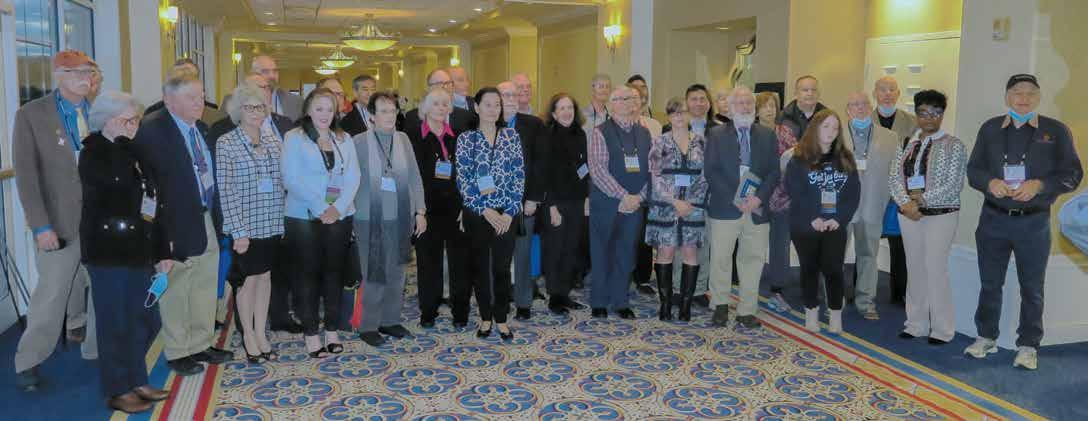
Gary Gallagher was awarded the 2021 Richard Nelson Current Award of Achievement, and Edna Greene Medford, John Marszalek, and Craig Symonds earned honorary awards. Finally, actor and writer Stephen Lang (who played General Pickett in the Gettysburg movie and

Stonewall Jackson in Gods and Generals) was the delayed recipient of the 2020 prize. The conference also included memorable performances. On the first night, visitors were treated to a performance by Jay Ungar and Molly Mason, a husband-wife folk music team best known for performing Jay’s original composition, “Ashokan Farewell,” the theme music for the Ken Burns special. On the final night of the conference,
actor Stephen Lang performed “Beyond Glory: Lt. James Jackson Purman,” then completed the evening and conference with a stirring performance of the Gettysburg Address. When the Forum ended, White reflected, “The speakers were phenomenal. Not only were they engaging in their presentation styles, but they hit on subjects that are of vital importance as we reckon with the legacy of slavery in this nation.”
Holzer, in turn, commented about the informal conversations. “We always tell our speakers that Forum audiences love to engage, both with formal questions at each session and with ongoing conversations at our breakfasts, lunches, dinners, and cocktail hours. Fortunately, our lecturers are always up for the social part of the Forum. I think our scholars also love the book-signing opportunities we provide, and our attendees love to buy books and get them inscribed.”
He concluded by praising the work of their great leadership and administrative team. We could not have pulled off such a huge event without the work of Administrator Pat Dougal and her predecessor Elaine Henderson, who managed our website. Thanks extend to Treasurer Paul Ward and Vice Chairman Jonathan White. We are very grateful to everyone both on our team and the hotel’s.
Leon Reed is a former U.S. Senate aide and U.S. history teacher. He lives in Gettysburg and is the author of No Greater Calamity for the Country: NorthSouth Conflict, Secession, and the Onset of Civil War (2019).
7 January 2022 7 January 2022 CivilWarNews.com CivilWarNews.com
First-time Lincoln Forum attendees.
Actor Stephen Lang performed “Beyond Glory: Lt. James Jackson Purman.”
Outgoing administrator Pat Dougal with Harold Holzer.
Subscribe or Renew Online at CivilWarNews.com
A Few Thoughts on Colt Revolvers
I have spoken of the rapid improvements made in arms... Revolvers were no exception and Colt’s revolver which monopolized the field for some time … Thousands were sold monthly and the newly fledged soldier who did not possess a revolver, either by his own purchase or as a present from solicitous relatives was something of a curiosity.” Josh Billings (Hardtack & Coffee or the Unwritten Story of Army Life)
Colt produced their pre-Civil War revolvers in three distinct categories based on how they were meant to be carried, which seems an odd way to categorize firearms. The smallest model was the .31 caliber, 5 shot revolver that Colt termed a “pocket pistol.” The cylinder was engraved with
a stage coach robbery scene, of all things. These small revolvers had at least some Confederate provenance and one belonging to 4th Sgt. James R. Hughes of the 1st Tennessee is on display in the Carnton Plantation museum, Franklin, Tenn.
The more common 1851 .36 Navy and 1860 .44 Army revolvers were “belt models” and both had the same naval battle scene engraved on the cylinder, a nod to the 1843 Republic of Texas and Yucatan victory over a Mexican flotilla at Campeche prior to the Mexican War. An odd choice (again) with the Navy battle also being engraved on the so-called “Army” model.
The newly designed 1860 Colt Army model was a slimmed down version of their earlier .44 “holster revolver,” a category including the largest models like the Dragoon, Walker, and Paterson, in other words the large frame four and a half pound
“horse pistols.” The cylinders of the large “holster revolvers” are engraved with a commemoration of ‘Hays big fight’ on the Pedernales against a Comanche raiding party that took place in 1844. The reason for the odd and elaborate cylinder engraving was an attempt by Colt to protect his patents. Even antebellum, Colt “clones” were already being produced.
In Civil War terminology, the terms pistol and revolver are used interchangeably but in modern nomenclature they have distinct meanings. A ‘pistol’ is a handheld single shot muzzle-loader and a ‘revolver’ is a multiple shot repeater with a rotating chamber loaded cylinder. The long-hinged apparatus under the barrel, called a loading lever, was used to seat the ball on top of the powder charge in each chamber during the time-consuming re-loading process.
It seems that many infantry soldiers started out with at least one pistol or revolver in their waist belt. How long they may have kept them is another matter. This is because there are very few instances of an infantryman making any reference to use of his revolver during an actual battle. There are several reasons why revolvers may have played a diminished role in full scale infantry encounters in the U.S. Civil War. First, the black powder handgun was primarily a shortrange defensive weapon. Colt stated that their belt revolvers
were “as effective as a common rifle at 200 yards,” but this is perhaps a bit exaggerated.
Claud E. Fuller noted in the appendix of The Rifled Musket, (1959 Stackpole Publishing Co, Harrisburg, Penn.) that at 200 yards the rifle-musket hit rate ranged from 64% to 82% at fixed targets on a firing range. Such marksmanship was not in wide evidence on the battlefield if period accounts are to be trusted. A reasonable conclusion is that at a distance of 200 yards the effectiveness of the rifle-musket is about 2 out of 3 at hitting a mansized target on a practice firing range. Battlefield hit rates were much lower since the “targets” fire back. Hence, one has trouble imaging any revolver with its much shorter barrel hitting four of six shots fired at 200 yards in



any infantry battle situation. So, what was the reasonable effective range of a revolver?
The limit of the actual effective range of the Colt revolver in the hands of someone well-schooled in its use is probably closer to 75 yards. The best evidence is from a duel between “Wild Bill” Hickok and a gambler named David Tutt Jr. on July 21, 1865. Hickok killed Tutt with a single shot from one of his Colt 1851 .36 Navy revolvers. The fight was noteworthy because of the “great distance” involved, estimated at 75 yards. Hickok was (of course) considered a very capable marksman when not inebriated, so the 75-yard figure is probably a realistic upper limit of the effective range of a Civil War-era cap and ball revolver in the hands of a professional gun fighter.
This extraordinary U.S. contract Colt Model 1860 .44 caliber Army revolver was manufactured in 1861 and is the benchmark example for approximately 129,000 Model 1860’s purchased by the U.S. government as the primary handgun issued to the Federal cavalry from 1860–1863. This Model 1860 Army revolver has the four-screw frame with shoulder stock cut-outs. Courtesy Rock Island Auctions.

8 CivilWarNews.com January 2022 8 January 2022 CivilWarNews.com
Private William B. Todd of Company E, 9th Virginia Cavalry Regiment with Colt Model 1860 .44 caliber Army revolver. He is wearing a jacket with epaulets and left chest exterior pocket and smoking a cigar. Liljenquist Family Collection of Civil War Photographs. (Library of Congress)
However, for anyone not named Wild Bill Hickok, probably 25 to 50 yards is the upper limit to hit the intended target with four out of six shots. Most infantry engagements were contested at a considerably greater distance.






Further, in some instances soldiers were forbidden from carrying revolvers. In the Civil War Diary of Confederate Pvt. Jacob D. Smith, (Company D, Camps and Campaigns) he noted that “Many soldiers had revolvers; and as many regiments were forbidden by their Colonels to wear them, so a large number were sent back home. Revolvers were probably cheaper in Virginia in those years than in any other state in America.” So, if we are to conclude that revolver use among infantry rank and file was more or less the exception to the rule, where were all the revolvers going and who used them?
Well, most assuredly revolvers were very widely used by Confederate horsemen where engagements between forces were at much closer range. The overwhelming favorite was initially the 1851 Colt .36 Navy model based both on pre-war availability and its reputation for reliability, followed closely by the newer 1860 .44 Colt Army model as these became more widely available (mostly) through capture. It is easier to name the Confederate generals who did not carry a Colt revolver than to list all of those who did, a compilation that would begin with Robert E. Lee and Nathan Bedford Forrest. In contrast, the

Union purchased very few Navy revolvers, but ordered close to two hundred thousand of the newer .44 caliber 1860 Army version, which was essentially a larger diameter barrel on the lighter Colt Navy frame. It was a winning combination in the right hands, but it needed to be drawn out of its holster to be effective. A major from the 2nd Michigan Cavalry noted: “Pistols are useless. I have known regiments that have been in the field over two years that have never used their pistols in action.” This shows the limited grasp of cavalry tactics by some Union soldiers on horseback. Hence, the Union cavalry began the Civil War perhaps better equipped with larger caliber Colt Army revolvers, but on orders from their commanders, most often began their charge (foolishly) with nothing but sabers drawn. As an obvious result, “…the rebels shot their saber wielding adversaries out of their saddles.” One wonders how exactly the saber beats any six-shot revolver in close quarters?
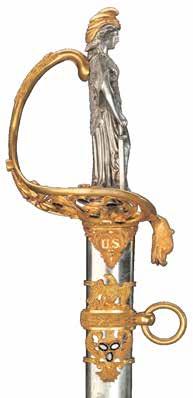
No less an authority on cavalry tactics than Nathan Bedford Forrest preferred the Colt Navy revolvers. He purchased five hundred “Navy Sixes” during October 1861, in Louisville, Ky., then smuggled them to Memphis, Tenn., in potato sacks. Once back in Tennessee, they were issued to the men in his command. Forrest recommended each man carry a ‘brace’ meaning two revolvers, rather than a revolver and a saber. He carried at least two
Colts himself and was known to “shoot his adversaries out of their saddles” with them as often as the opportunity arose. In one instance, at Bogler’s Creek, Ala., the 17th Indiana Cavalry attacked in the traditional fashion with sabers drawn. Forrest was engaged by an Indiana cavalry officer who was enthusiastically hacking at him with his saber. As soon as Forrest managed to get a few yards removed, he turned around, drew his revolver and shot his attacker. Six or seven others were found nearby killed in similar fashion. It must have been like shooting fish in a barrel.
The popular (newer) Colt revolvers were often taken through capture. While a wellknown user of the J.E.B. Stuart, a well known user of the LeMat, captured a wagon full of new Colt Army revolvers during his ride around McClellan during the Seven Days battles. Southern production of the Colt knockoffs never quite met the demand, so most Colt revolvers that saw Confederate service were either pre-war private purchases or captured arms. Except for the Nathan Bedford Forrest transaction in 1861, which was likely through intermediaries with Confederate sympathies, there are no records of Colt factory sales direct to the Confederacy during the Civil War-era. Concerning revolvers that were commonly captured, Bell Wiley, noted in The Life of Johnny Reb: A Common Soldier of the Confederacy, that besides the Colt 1860 Army and the “new” updated 1861 Navy design, included those manufactured by Remington, Starr, Whitney, Beal, and Joslyn were popular, “ but Colt six-shooters were by far the most common.”
Craig L. Barry was born in Charlottesville, Va. He holds his BA and Masters degrees from UNC (Charlotte). Craig served The Watchdog Civil War Quarterly as Associate Editor and Editor from 2003–2017. The Watchdog published books and columns on 19th-century material and donated all funds from publications to battlefield preservation. He is the author of several books including The Civil War Musket: A Handbook for Historical Accuracy (2006, 2011), The Unfinished Fight: Essays on Confederate Material Culture Vol. I and II (2012, 2013). He has also published four books in the Suppliers to the Confederacy series on English Arms & Accoutrements, Quartermaster stores and other European imports.
9 January 2022 9 January 2022 CivilWarNews.com CivilWarNews.com Buying and Selling The Finest in Americana 11311 S. Indian River Dr. • Fort Pierce, Florida 34982 770-329-4985 • gwjuno@aol.com George Weller Juno
Unidentified soldier in Confederate frock coat with Model 1842 musket and two Colt revolvers. Liljenquist Family Collection of Civil War Photographs. (Library of Congress)
www.CollegeHillArsenal.com Tim Prince College Hill Arsenal PO Box 178204 Nashville, TN 37217 615-972-2418 Deadlines for Advertising or Editorial Submissions is the 20th of each month. Email to ads@civilwarnews.com
Trust Seeks to Save 239 Virginia Acres Connected to Two Civil War “Taverns”
The American Battlefield Trust is currently working to preserve 239 acres at two Virginia battlefields, 141 acres in Spotsylvania County and 98 acres south of Petersburg. What ties these locations together are two inns, Todd’s Tavern and the Globe Tavern, where Union and Confederate forces rested and engaged one another nearby for control of a route toward Richmond and the supply chain needed to win the war.
Starting with a transaction value of $1,725,500, the Trust acquired federal and state grants, funding from partner organizations, and a large contribution from a generous donor to complete 92.2% of the funding. Now, the organization looks to its members to raise the remaining $137,500, with each donation met with a $1to-$12.50 match. Of even greater value is the history that unfolded on these properties.
In May 1864, west of the Brock and Catharpin Roads intersection stood Todd’s Tavern; it briefly hosted Grant and Meade as they rode south along Spotsylvania’s Brock Road. A week later, it hosted Confederate cavalry Brig. Gen. Thomas Rosser’s Brigade the night before they marched east on the Catharpin Road to engage the 2nd Ohio Cavalry and 23rd Regiment, U.S. Colored Troops, in a skirmish outside Chancellorsville.
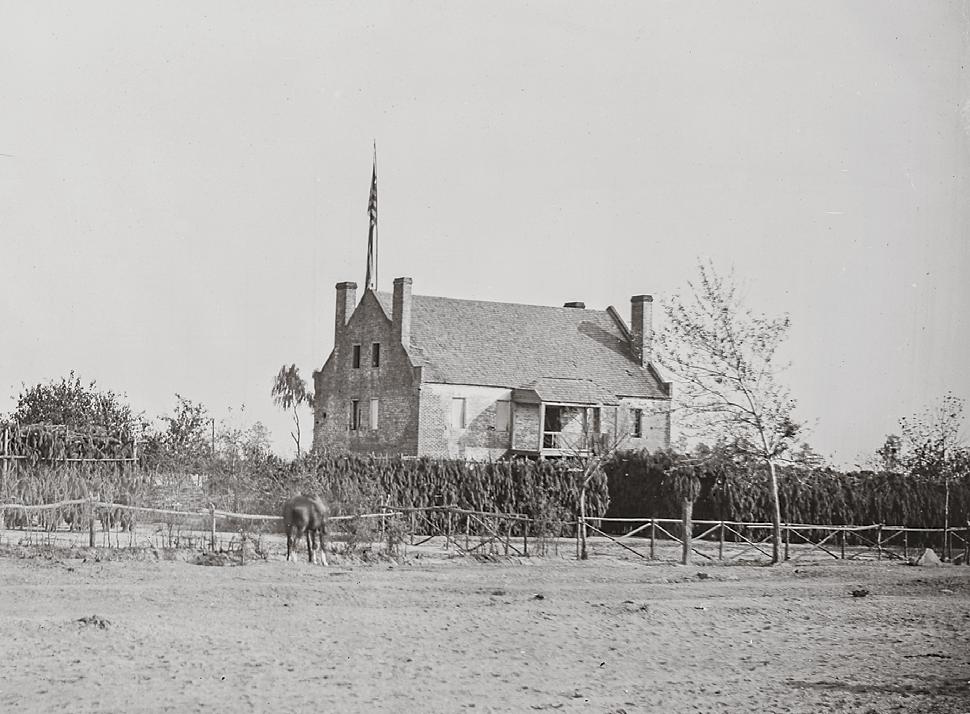
South of Petersburg, Va., sits an additional 98 acres of hallowed ground across two tracts, near the location where the Globe Tavern once stood. Both tracts played an imperative role in two 1864 battles fought for control of the strategic Weldon Railroad.
To help the Trust save these critical sites, visit www. battlefields.org/239acres.
Trust Supports Veteran Archaeologists

Continuing a long-standing partnership, the Trust has pledged
$10,000 to support an American Veterans Archaeological Recovery (AVAR)-led project aimed at answering lingering questions about historical battles on American soil. The investigation outside San Antonio, Texas, will begin in February in an effort to determine the location of the Battle of Medina.
“Archaeology projects the historical record onto a physical space and can deepen, or even reshape, our understanding of past events,” said Trust President David Duncan. Transitional programs like AVAR help veterans reacclimate to civilian culture by putting former military personnel in pursuit of a common cause. With archaeology, veterans actively use the skills gained in the military and bring a level of understanding and connection to the battlefield that no civilian can hope to possess.
The August 18, 1813, Battle of Medina was a critical moment in the Mexican War of Independence. The diverse Republican Army was crushed by the Spanish Army and those
who surrendered were offered no quarter. At Medina, AVAR will collaborate with experts across disciplines and with support from the County of Atascosa and the Texas Historical Commission, plus technical supervision provided by Dr. Raymond Mauldin of the Center for Archaeological Research at the University of Texas at San Antonio.
Previously, Trust contributions placed AVAR volunteers alongside NPS archaeologists on an award-winning cultural resources team at Saratoga National Historical Park.

Donations in support of the Trust’s archaeology work, alongside AVAR and more broadly on other battlefields, may be made at www.battlefields.org/ supportarchaeology
New Federal Matching Grant Program to Fuel Battlefield Interpretation
The National Park Service’s American Battlefield Protection Program (ABPP), which has helped aid preservationists with matching funds to facilitate the protection and study of battlefields, has expanded by

awarding a first round of grants toward interpretation projects. The new program has awarded $917,173 to projects that utilize technology to bring stories of armed conflicts alive for modern audiences, with the American Battlefield Trust receiving five of the 11 grants awarded.
Trust-led projects that rose to ABPP’s exacting standards included: the development of virtual field trips that allow students nationwide to digitally explore Revolutionary War, War of 1812, and Civil War sites; an animated video series covering 16 battlefields in seven states telling stories with diverse firstperson narratives and artifacts; an interdisciplinary drive to tell the stories of African American combatants who took up arms for a nation that did not yet consider them free or full citizens; a vision to work alongside Princeton Battlefield State Park to transform visitor experience at the site of the Revolutionary War’s Ten Crucial Days, and an augmented reality undertaking allowing visitors to downtown Charleston, S.C., as well as other transformative experiences along the Liberty Trail.
ABPP’s Battlefield Interpretation Grants empower partners nationwide to modernize and enhance battlefield interpretation,
10 CivilWarNews.com January 2022 10 January 2022 CivilWarNews.com
Globe Tavern, formerly Gen. George Meade’s Headquarters, once stood near Petersburg, Va. Photo by Matthew Brady, provided by the National Archives and Records Administration.
American Veterans Archaeological Recovery (AVAR) volunteers sift excavated soil at Saratoga Battlefield.
Photo by Glenn Riegel.
American Veterans Archaeological Recovery (AVAR) Dig – Saratoga, NY.
ultimately inspiring wonder and understanding at the places our nation witnessed incredibly challenging events.
Let Trust Historians Escort You Around Gettysburg from the Privacy of Home with Two-Hour Video Tour


To celebrate the 158th anniversary of Gettysburg’s second most famous event, the dedication of the Soldiers National Cemetery, the Trust debuted a two-hour online video tour of the Gettysburg Battlefield, approximating what it is like to drive past distinct landmarks like Little Round Top and the Bloody Angle. The free tour, created with the consent of the National Park Service, is now available on the Trust’s YouTube channel at www.youtube.com/ AmericanBattlefieldTrust.
With GoPro cameras affixed to his car and a wealth of stories stashed in his mind, the American Battlefield Trust’s Chief Historian and licensed Gettysburg Battlefield guide Garry Adelman escorts viewers through the historic town and national military park. Whether it be through small details or big picture ideas, the expert storyteller weaves together an exciting arrangement of Gettysburg wisdom but also emphasizes there is no substitute for an in-person visit with a licensed guide.
“Gettysburg is a place where stories live, and at the Trust we’re always looking for new and dynamic ways to bring stories to life,” said Adelman.
The debut came days after the Trust’s first-ever Fall Virtual
Teacher Institute, a free event where educators and museum professionals gathered online to attend sessions on the topic of “Technology In and Out of the Classroom” that included a session with keynote speaker and New York Times bestselling author Jeff Shaara.
Honoring the Longtime Leadership of O. James Lighthizer
After serving as the president of the Trust for over 20 years, O. James Lighthizer was honored
at the Gettysburg Battlefield on November 6. The former Trust president was completely surprised by monument erected on Seminary Ridge to commemorate his commitment to battlefield preservation. Lauding his mentor and predecessor, current Trust President David Duncan spoke to the crowd and was later joined by Gloria Lighthizer in unveiling the monument. A testament to the more than 53,000 acres of battlefield land that were preserved by way of Lighthizer’s vision and efforts, the structure sits upon Trust-saved land.

McCormick Civil War Institute
2022 Spring Conference
“Beyond the Mere Routine of Everyday Life” Encounters & Experiences during the Civil War
Saturday April 2, 2022
9 a.m. – 4 p.m.
Featuring Presentations by:
Jonathan A. Noyalas (Shenandoah University)
Lauren K. Thompson (McKendree University)
Kathryn J. Shively (Virginia Commonwealth University)
Jonathan W. White (Christopher Newport University)
Registration fee: $30 includes all sessions & lunch
Additional Questions: Contact MCWI's director Jonathan Noyalas, jnoyalas01@su.edu or 540-665-4501
To register: su.edu/MCWI
Slaughter on the Mountain
160th Anniversary Reenactment of the Battle of Cedar Mountain
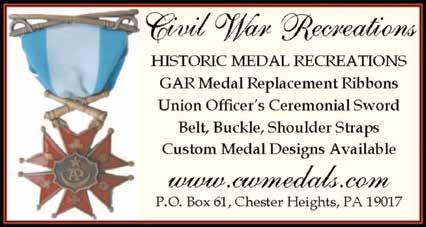



August 5-7, 2022
Culpeper,
Virginia
US and CS troops are wanted for a reenactment of the first battle of the Second Manassas campaign on the actual battlefield!

Recreations of battle actions on Saturday, Aug. 6 and Sunday Aug. 7.
Event limited to 1,500 troops (artillery, cavalry, and civilians by invitation only)
Public talks & demonstrations both days
Sutlers and food vendors

visit friendsofcedarmountain.org
(registration opens November 1, 2021)
11 January 2022 11 January 2022 CivilWarNews.com CivilWarNews.com
Garry Adelman drives in the direction of the Trostle Farm, unleashing extensive knowledge within the Trust’s new Gettysburg video tour.
Former Trust President Jim Lighthizer looks at monument erected in his honor on Gettysburg’s Seminary Ridge.
Photos by Noel Kline.
information,
For
Crossing Hell On Ice
“By pondering our plans and maps, Great General George has got the gaps, But we, who watched this sleepy war, We got the gaps long, long, before.” –U.S. Gen. Fredrick W. Lander

Fighting the 1862 Shenandoah Valley, Va., winter campaign was as frustrating on the field as it was off. The Shenandoah Valley is located south of the Potomac River southwest of Washington, D.C., and supplied the Confederate capital of Richmond, Va.
Both U.S. Gen. Fredrick W. Lander and C.S. Gen. Thomas “Stonewall” Jackson wanted to seize control of the lower (northern) Shenandoah by holding the village of Romney, 40 miles via the Northwest Turnpike from the commerce center of Winchester, Va. The town also overlooked sixty miles of the B&O Railroad in the South Branch Valley.
On Dec. 27, 1861, Lander was the first witness to testify regarding the Battle of Ball’s Bluff, Va. before the Congressional Joint Committee on the Conduct of the War. Lander was nationally known for participating in five transcontinental surveys; he had fought Indians and grizzlies, and distinguished himself in the Battles of Philippi, W.Va., and Rich Mountain, Va. Lander had been shot in his left leg during the battle; the bullet bored through the bootstrap into his calf. The strap had been pulled out and the remaining fragments were later removed, leaving him with an infected wound.

When asked if a winter season was practical, Lander said that the Army of the Potomac, “who are housed and buttered up about Washington and taught to believe that if they make a march of three miles it will get into the papers,” may not be capable of a winter campaign but with “the Ohio and Indiana boys on duty in western
Virginia, he could whip Jackson at Winchester, [Va.] in any season, as could [Gen. Nathaniel] Banks, if properly supported.”

Lander had planned to spend the New Year with his wife while resting his leg for at least five more days as per his doctor’s instructions. On his return home after testifying, Lander found orders to assume command at Romney, which had been captured by U.S. Gen. Benjamin F. Kelley on Oct. 22, 1861. Kelley was ailing from a wound received during the Battle of Philippi. Lander sent a request to McClellan for men to capture towns three miles from Winchester and a note to Lincoln.
“We need fighting men,” he told the president. “Up to the present time [I] have seen so many shaking nerves in this war that I sometimes doubt my eyesight.”
C.S. Gen. William W. Loring’s Army of the Northwest was sent to reinforce Jackson at Winchester. Starting at 14, Loring served in the Florida militia fighting Seminole Indians for five years, fought and lost his arm fighting in the MexicanAmerican War, and spent decades on the frontier, chasing Indians, protecting settlers, gold diggers, and more.
On Christmas Eve, Loring arrived and discussed with Jackson the terms of their cooperation. Jackson considered his force of 7,500 volunteers, 2,234 militia, and 664 cavalry inadequate to hold the lower Shenandoah. He wrote Gen. Joseph Johnston that he would need, “… to attack the enemy in his present position before he receives additional reinforcements … at the earliest practicable moment.”
Jackson launched his Romney Expedition on Jan. 1, 1862. He ignored what was locally known as a “weather breather,” an unseasonably warm spell that signaled a sudden freeze. Loring wasn’t informed that Jackson planned to attack Romney and, to protect his right flank and rear; he would first capture the villages of Bath and Hancock. Lack of clear marching directions resulted in delays. A chill wind came up in the afternoon and the temperature
plummeted into the twenties. Men were struggling to keep warm, especially those who had thrown their coats into the lagging supply wagons.
Loring was livid, “Owing to the mismanagement, for which none of my command was responsible, the baggage wagons, with food, tents, and bedding, did not reach camp that night.” On January 3, not realizing his men were waiting to attack as other units were getting into position, Loring declared, “By God, sir, this is the damnedest outrage ever perpetrated in the annals of history, keeping my men out here in the cold without food!”
On January 4, the Federals, realizing they lacked adequate ammunition to fight, decided to withdraw from Bath while they could. After a few delays, C.S. Col. William Gilham’s Brigade arrived to see the last remnants of the enemy depart.
On January 5, Jackson sent a message by Col. Turner Ashby ordering Hancock to surrender, or he would shell the town. Lander told Ashby, “… give my regards to General Jackson and tell him to bombard and be damned! If he opens his batteries on this town he will injure more of his friends than he will of the enemy, for this is a damned secesh place
anyhow!”


At 2 p.m. the combatants sporadically exchanged fire. The Confederate gunners adopted the code word “Brown Church” to escape the accurate 10-pounder Parrott rifle shells and code “Red Church” to not bother moving for inaccurate smoothbore shells. At nightfall, snow replaced the shells. The Federals sheltered in the abandoned homes. The Confederates struggled to stay warm without camp equipage, buried in snow.
On January 6, while the Confederates tried to avoid freezing, Lander was wiring Banks for men to cross the Potomac and take Jackson from behind or send him “five regiments by forced march and I will cross here and beat them.”
On January 7, Jackson abandoned Hancock, headed for Romney. As the temperature lowered, Jackson’s doctor insisted that he drink some alcohol for warmth. To the amusement of his men, Jackson rode drunk. Somehow, it had been overlooked that the horses were lacking rough shoes capable of coping with the icy roads.. “There were many times when the horses would fall as they began to descend a hill, and the weight of the gun, or caisson, would push
12 CivilWarNews.com January 2022 12 January 2022 CivilWarNews.com
Fredrick West Lander, 1821–1862, Colorization © 2020 civilwarincolor.com. Courtesy civilwarincolor.com/cwn. (National Portrait Gallery)
Gen. William W. Loring, Colorization © 2021 civilwarincolor.com. Courtesy civilwarincolor.com/cwn. (Public Domain)
them in a heap to the foot. Then came the necessity of raising the poor horses to their feet again and of assisting them to pull their loads up the next hill.”
On January 8, Lander arrived at Romney. McClellan had ordered the town evacuated. Every available wagon was assigned to remove Federal stores. On January 10, the Federals left as “… everything that could not be taken was hastily committed to the flames. Many tents were destroyed together with blankets, trunks, clothing, provisions, accoutrements, and articles of camp equipage, –flames lightening up a scene of

destruction that I hope never to witness again.”
Both sides grappled moving their army through the frigid weather. As he watched his men’s efforts to cross a creek Landers asserted, “The next time I undertake to move an army, and God Almighty sends such a rain, I will go around and cross Hell on the ice.”
On January 14, the Confederates entered Romney. By local accounts, Romney would change hands 56 times. The conflict between Jackson and Loring ended with Loring being promoted to major general and transferred.
On March 2, 1862, Lander died from his infected wound.
During the Expedition, Loring complained to his staff about Jackson’s secretive nature. He stated that if Jackson should be killed, he would find himself “in command of an army of the object of whose movements he knew nothing.”
Sources:

• Cozzens, Peter. Shenandoah 1862: Stonewall Jackson’s Valley Campaign: The University of North Carolina Press, 2009.
• Ecelbarger, Gary L. Fredrick W. Lander: The Great Natural American Soldier: Louisiana State University Press, 2000.

• Tanner, Robert G. Stonewall in the Valley: Thomas J. “Stonewall” Jackson’s Shenandoah Valley Campaign, Spring 1862: Stackpole Books, 2002.
A U.S. 10-pounder Parrott rifle had a bore diameter of 2.9-inches, the tube weighed around 900 pounds, and when fired at 6 degrees elevation, with a shell that weighed 9 3/4 pounds, it had a range of 2,250 yards. Courtesy Gettysburg National Military Park.
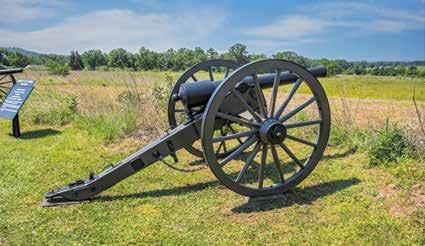

Stephanie Hagiwara is the editor for Civil War in Color.com and Civil War in 3D.com. She also writes a weekly column for History in Full Color.com that covers stories of photographs of historical interest from the 1850’s to the present. Her articles can be found on Facebook, Tumblr, and Pinterest.
– Post-1898 and Modern Handguns are Prohibited –Complete information on web site: www.baltimoreshow.com Or Call 443-497-9253




Known as the “CROWN JEWEL” of Collector’s Shows!

13 January 2022 13 January 2022 CivilWarNews.com CivilWarNews.com Contact Mike at: 910-617-0333 • mike@admci.com Fort Fisher Items Wanted! Provenance a Must! Fort Fisher
Cliff Sophia | Proprietor CSArms.com 9150 John S. Mosby Hwy. (Rt. 50) Upperville, Va 20185 for US Mail: PO BOX 602 (540) 592-7273 • SophiaCSArms@aol.com
1700-1945 Militaria Specializing in Civil War-World War II The Maryland Arms Collectors Assoc., Inc. presents The “Original Baltimore” Antique Arms Show
1955 Maryland State Fairgrounds Timonium, MD
of Baltimore, York Road, MD. – Rt. 45
Tables
Collector’s Arms
Since
North
1,000 8-Foot
March 19-20, 2022
Public Hours: Sat. 9 A.M. to 5 P.M., Sun. 9 A.M. to 3 P.M. Admission: $10.00
Quincy (Illinois) Civil War Symposium III
by Professor Earnest Veritas Special Correspondent to Civil War News -Western Theater-

The third annual Quincy Civil War Symposium was heldon October 8-9, 2021, at the Salvation Army Kroc Center in Quincy, Ill. The event was a success by any standard and was most informative to the 129 who came to enjoy Civil War history. It was sponsored as a joint effort by the Historical Society of Quincy and Adams County with the TriStates Civil War Round Table (in Quincy, Ill.). Attendance was good for both the Friday evening kick-off and the all-day Saturday presentations.
A picnic on the grounds of the John Wood Mansion was held for presenters and guests as they ate dinner and pleasantly passed the time of day during a beautiful fall afternoon in Quincy. After dinner all proceeded to the Kroc center in downtown Quincy for presentations by Dr. Timothy B. Smith and Brian “Fox” Ellis.
Walt Whitman during the Civil War. His performance included anecdotes of Whitman’s life as a nurse in Washington City during the war and reading several of the poet’s works. His heartfelt portrayal brought Whitman to life and gave insight into the soul of a gentle man in a violent war.
Saturday morning, October 9, saw an early start to a historypacked day with a complimentary breakfast for the early risers. They sipped coffee and munched pastries while being entertained with several vignettes about Quincy folks in Civil War history.
Rob Mellon described the campaigns of the 50th Illinois Infantry, known as the “Blind Half-Hundred.” The 50th was organized in Quincy and fought at Shiloh, Fort Donelson,

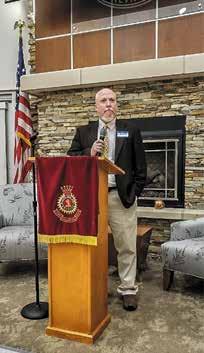
Vicksburg, Atlanta, Allatoona, and made the March to the Sea; Rich Keppner, in first-person, told the story of Sterling Delano; Beth Young regaled the audience with the adventures of Louise Maertz; Dr. Tim Jacobs brought up the rear with a first-person presentation as Dr. Samuel Everett; a Quincy native killed at Shiloh; the first army doctor to be killed in combat during the Civil War. Dr. Everett is buried in the National Cemetery at Shiloh National Military Park and has a cenotaph in Woodland cemetery in Quincy.
The main portion of the day’s presentations began at 9:15 a.m., with Dr. Samuel Wheeler, talking about “Robert Todd Lincoln’s War.” Dr. Wheeler is an expert on Lincoln and the Civil War Era and is the Director of History Programs for the Illinois Supreme Court Historic Preservation Commission. He gave some interesting aspects of Robert Lincoln’s life, emphasizing that he was only 21 when his father was killed; living by far, most of his life in distinguished service.
Timothy S. Goode, current superintendent at the Abraham Lincoln Home in Springfield, Ill., gave substantial insight about the Lincoln-Douglas Debates. Tim used his book, “The LincolnDouglas Debates” as the basis for his talk. His talk looked deeply into what was really happening with the debates both locally and nationally.
The Symposium opened with a talk about the Grierson raid and its relationship to Grant crossing the Mississippi; a fitting end to a weekend of outstanding history the Symposium came to an end
of 2022. For more information about this year’s Quincy Civil War Symposium III or next year’s Quincy Civil War Symposium IV, contact the Historical Society of Quincy and Adams County at: 217-222-1835 or email: susid@ hsqc.org
Contact information for this year’s Symposium speakers is:
• Dr. Timothy Smith: tims@ utm.edu

• Brian “Fox” Ellis: foxtales@ foxtalesint.com
• Dr. Samuel Wheeler: samuel. wheeler@ illinoiscourthistory.org
• Timothy S. Goode: Lincoln Home on social media
• Dr. Curt Fields: curtfields@ generalgrantbyhimself.com

Simply put: tell the simple truth, simply.”
Professor E. Veritas
Dr. Smith opened the Symposium to an enthusiastic crowd and gave a most informative presentation on “The Real Horse Soldiers-Grierson’s Raid.” The raid diverted Confederate resources between April 17 and May 2, 1863. It was a diversion of Confederate resources from Grant’s crossing of the Mississippi River. Dr. Smith has recently published a wellresearched and most readable book on the raid, titled: The Real Horse Soldiers. The second part of the Friday evening opening program was a presentation by storyteller and author, Brian “Fox” Ellis. His program was titled: “Walt Whitman’s Lincoln” and he portrayed, in first-person,
with General Ulysses S. Grant (portrayed by living historian Dr. Curt Fields.) The General talked about the siege of Vicksburg and just how and why he did what he did to bring Pemberton to bay and the siege to an end.

Plans are already underway for Symposium IV in the Spring
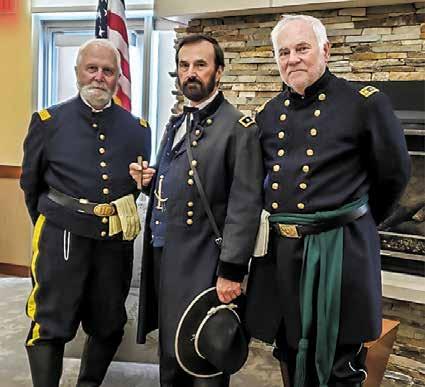
14 CivilWarNews.com January 2022 14 January 2022 CivilWarNews.com
Dr. Timothy B. Smith.
Brian “Fox” Ellis.
Rich Keppner as Sterling Delano, Dr. Curt Fields as General Grant, and Dr. Tim Jacobs as Dr. Samuel Everett.
Dr. Samuel Wheeler. Timothy S. Goode.
Dr. Curt Fields.
Subscribe online at CivilWarNews.com








15 January 2022 15 January 2022 CivilWarNews.com CivilWarNews.com 48 E. Patrick St., Frederick, MD. 301-695-1864 / civilwarmed.org Divided by Conflict. United by Compassion. THE FINEST HISTORICAL ANTIQUE MILITARIA Wallace Markert csacquisitions@gmail.com 16905 Nash Road • Dewitt, Virginia 23840 804-536-6413 www.csacquisitions.com 19th CENTURY LIVING HISTORY! James Country MERCANTILE 111 N. Main Liberty, MO 64068 816-781-9473 • FAX 816-781-1470 www.jamescountry.com Ladies – Gentlemen Civilian – Military • Books • Buttons • Fabrics • Music • Patterns • Weapons Mens, Ladies and Children’s • Civilian Clothing • Military Clothing • Military Accessories • Accoutrements Everything needed by the Living Historian! Our Clothing is 100% American Made! The home of HOMESPUN PATTERNS© Digital Issues of CWN are available by subscription alone or with print plus CWN archives at CivilWarNews.com
A Prequel, or Grant vs. Grant
In 2019 I wrote a column in Civil War News about the October 1862 Battle of Corinth. My focus was on Maj. Gen. Ulysses S. Grant and the statements he made in his after-action report and his memoirs regarding the battle and its aftermath, when Federal forces under Brig. Gen. William S. Rosecrans pursued the retreating Confederates. Grant’s 1862 report was mildly critical of Rosecrans for not mounting his pursuit promptly, but otherwise found no fault on Rosecrans’s part. Grant’s memoirs, however, were utterly condemnatory, and much of what he wrote is demonstrably untrue.

The Battle of Iuka was fought two weeks before Corinth. There are some interesting parallels between these two battles and the controversies they spawned. In both cases it is interesting to read the relevant portions of Grant’s memoirs and compare what Grant wrote just before his death in 1885 with his own 1862 reports and other primary sources. In this column I will discuss two controversial issues related to Iuka, as a prequel to the 2019 column on Corinth; but first a summary of the battle.
In the summer of 1862 Grant
commanded the District of West Tennessee, with forces spread in various locations in northern Mississippi and western Tennessee. Grant’s troops and the Confederate forces in the area moved about, watching each other and clashing occasionally in small engagements. Grant’s aims were to protect his territory, with Corinth and its railroad junction being of special importance, and prevent the Confederates from reinforcing Gen. Braxton Bragg, who was embarking on his Kentucky Campaign. Grant had about 50,000 men after sending reinforcements to Maj. Gen. Don Carlos Buell, whose army was moving to intercept Bragg. There were two major Confederate forces in the area, one under Maj. Gen. Earl Van Dorn and the other under Maj. Gen. Sterling Price.
In September Grant determined to attack Price at Iuka. One column, under Maj. Gen. Edward O.C. Ord, was to approach Iuka from the west along the Memphis and Charleston Railroad. Rosecrans was to march on a parallel line further to the south, then swing north into Iuka, covering two roads that converged near the town. If successful, this pincer movement would defeat Price and bag his entire force. The initial plan was for Ord to open the attack,

GEORGIA’S CONFEDERATE MONUMENTS
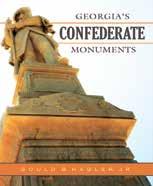
In Honor of a Fallen Nation
Gould B. Hagler, Jr.

This unique work contains a complete photographic record of Georgia’s memorials to the Confederacy, a full transcription of the words engraved upon them, and carefully-researched information about the monuments and the organizations which built them. These works of art and their eloquent inscriptions express a nation’s profound grief, praise the soldiers’ bravery and patriotism, and pay homage to the cause for which they fought.
www.mupress.org
866-895-1472
with Rosecrans moving in after hearing the sound of Ord’s guns. That was the plan. As events unfolded, however, only Rosecrans’s men were heavily engaged. In a meeting engagement south of Iuka on the Jacinto Road, they fought a brief but fierce battle late in the afternoon of Sept. 19. In the meanwhile, Ord remained a few miles west of Iuka and was not engaged. Darkness ended the battle. During the night Price evacuated Iuka using the Fulton Road. This road lay east of the Jacinto Road, was not covered by Rosecrans as initially planned.
The first issue to be examined is this: why did Rosecrans not cover the Fulton Road?
In 1885 the answer to this question was, in Grant’s view, a simple one. In his memoirs
Grant wrote that “Rosecrans… had put no troops upon the Fulton road, and the enemy had taken advantage of this neglect and retreated by that road during the night.” There is no discussion beyond this concise accusation of “neglect.”
Two decades earlier Grant’s opinion was different. His October 1862 report stated that he was riding east to Iuka from Burnsville, eight miles to the west, the morning of Sept. 20 when he learned that Price was gone and Rosecrans had entered the abandoned town. On his arrival he learned that the Fulton Road, Price’s only means of escape, was left open. However, Grant’s report contains this explanatory comment: “A partial examination of the country afterward convinced me… that troops moving in separate columns by the routes suggested could not support each other until they arrived near Iuka.”
It is odd, perhaps, that Rosecrans’s own 1862 report does not include this explanation. However, he went into some detail when testifying to the Joint Committee on the Conduct of the War in April 1865. Rosecrans stated that when he arrived at the point where one division was to
16 CivilWarNews.com January 2022 16 January 2022 CivilWarNews.com
toll-free
Maj. Gen. William S. Rosecrans. (Library of Congress)
General Grant in 1861, the year before Iuka. (Library of Congress)
turn north from the Tuscumbia Road onto the Jacinto Road, the Tuscumbia Road’s intersection with the Fulton Road was four and a half miles further east. The roads were not parallel but diverged as they led south from Iuka.

Rosecrans explained that “there were no cross-roads between [the two roads] by which columns advancing on them separately could certainly and safely communicate with each other….” He deemed it “unsafe” to divide his command “into two columns, not within supporting distance of each other….” He further stated that he sent a message to Grant “advising him of this my determination, with the reasons therefor.”
There is no dispatch in the Official Records in which Rosecrans notifies Grant of this decision to march toward Iuka on a single road. As stated above, Grant wrote that he was unaware of the fact until he entered Iuka the next morning.
The fact that Rosecrans gave this explanation in 1865 but did not mention it in his report would be cause for some suspicion if not for the fact that Grant clearly made reference to Rosecrans’s determination in his own report. He wrote explicitly that he was “convinced” of the soundness of Rosecrans’s decision.
The second controversy to explore is the pursuit of the Confederate force after it retreated to the southeast. Let’s
start with Grant’s memoirs.
“Word was soon brought to me that our troops were in Iuka,” Grant wrote. “I immediately rode into town and found that the enemy was not being pursued even by the cavalry. I ordered pursuit by the whole of Rosecrans’ command and went with him a few miles in person. He followed only a few miles after I left him, and then went into camp, and the pursuit was continued no further.”
So, per Grant in 1885, Rosecrans negligently left open the Confederates’ only avenue of escape and had not moved in pursuit by time the boss showed up. Grant himself ordered the pursuit. Rosecrans kept it up only as long as Grant watched over him, then went into camp. Not a very flattering portrait.
Contemporary records paint a different picture. At 9:45 a.m. on the 20th, after arriving in Iuka, Rosecrans sent a dispatch to Grant. “Stanley follows [the retreating Confederates] directly and Hamilton endeavors to cut them off from the Bay Springs Road” (Brig. Gen. David S. Stanley and Brig. Gen. Charles Hamilton commanded Rosecran’s two divisions). In his report to Grant written nine days later, Rosecrans wrote that “Taking possession of the town and the stores left there General Stanley’s column pushed on in pursuit. The cavalry advanced by the intermediate road between the Fulton and Jacinto roads.
Hamilton’s division faced about and marched by Barnett’s, following the enemy until night….”
The reports of Stanley and one of his brigade commanders, Col. John Fuller, stated that they pursued the Confederates; Hamilton’s report is silent on this question. Stanley and Fuller did not indicate with precision how prompt their pursuit was, but the reports do read as if Federal troops entered the town and then started the pursuit, with no indication of a delay until Grant arrived on the scene.
For information on that point, we can rely on Grant himself, whose report stated that when he arrived in Iuka “Generals Stanley and Hamilton were in pursuit.”
In accounts of both controversies, the open Fulton Road and the pursuit of Price, we find stark contrasts between the 1885 version written by the terminally ill former president and the report penned by the general two decades earlier. Other primary sources agree with the general, not the dying president.

Iuka was not a large-scale battle by Civil War standards. Only about 7,500 men on both sides fought that afternoon. Casualties were high for the numbers engaged, perhaps 2,000 on both sides, but the losses pale in comparison with Antietam, Gettysburg, Chickamauga, and other major battles. Still, the campaign in northern Mississippi and the contest to control its
railroads had a significant effect on the course of the war, and Iuka was a major part of that contest. The two controversies discussed in this column are not the only ones associated with this battle, and the detective work to dissect discrepancies in the various accounts pays off in a better understanding of the war and the commanders who fought it.
Future columns may examine some other controversies related to Iuka. There are several more.
Further reading: The reports and dispatches referenced—and much else that is relevant to the topic—are in the Official Records, Series I, Vol. XVII, Parts I and II. Rosecrans’s testimony on the battle is found on pages 18-20 of “Rosecrans’s Campaigns” in Joint Committee on the Conduct of the War at the Second Session Thirty-Eighth Congress. Personal Memoirs of U.S. Grant was first published in 1885. There are two biographies of Rosecrans: The Edge of Glory: A Biography of General William S. Rosecrans, U.S.A. by William M. Lamers (Louisiana University Press, 1999) and William S. Rosecrans and the Union Victory: A Civil War Biography by David G. Moore, (McFarland & Company, 2014). General Grant and the Rewriting of History, by Frank P. Varney (Savas Beatie, 2013) was reviewed in the February 2019 issue of Civil War News
I looked at several maps of the battle and period maps of northern Mississippi. No two were alike. I read a dozen or so accounts of the battle, written by officers in the battle and by modern historians. The descriptions of the roads are confusing, partly because some roads are assigned different names by different officers. I did some comparisons and devised a schematic diagram that will help the reader follow the discussion in this column. The scale is very approximate. – GH
Gould Hagler is a retired lobbyist living in Dunwoody, Ga. He is a past president of the Atlanta Civil War Round Table and the author of Georgia’s Confederate Monuments: In Honor of a Fallen Nation, published by Mercer University Press in 2014. Hagler speaks frequently on this topic and others related to different aspects of the Civil War and has been a regular contributor to CWN since 2016. He can be reached at gould.hagler@gmail. com. Hagler is a distant cousin of General Grant’s (sixth cousin five generations removed).
17 January 2022 17 January 2022 CivilWarNews.com CivilWarNews.com
Grant writing his memoirs, 1885. Colorized by myheritage.com. (Library of Congress)
40th Annual Central Virginia Military Antique Show


HENRICO COUNTY, Virginia—The



40th annual Central Virginia Military Antique Show was held on November 13, 2021, at the Richmond Raceway Complex. This is one of the largest and longest running shows in the country, and once again it didn’t disappoint.


The show picked up where it left off after a COVID gap year with well over 200 dealer and display tables. Hundreds of people came out to this one-day show; many guests also attended the gun show being held next door in the other facility building.

Long-time collectors Carl Sitherwood and Mike Ward inherited this show from Mike Kent earlier this year. Kent said, “Carl and Mike are perfect stewards for carrying the tradition forward. As collectors who aren’t viewing the show merely as a business, Mike and Carl care about the experience first and foremost from the collector’s standpoint.”
Unfortunately, a date conflict with the Tulsa gun show resulted in the loss of three long-time dealers, but their spots were filled by collecting buddies of Mike and Carl who brought a large range of fresh-to-the-market items that were quickly scooped up. Among the highlights were the liquidation of Peter George’s lifetime artillery collection, a fantastic old-time dug group of Shiloh area relics that had never been to market, and a large estate
CHARLESTON IN THE WAR
CHARLESTON IN THE WAR

collection of 70 plus Confederate belt plates and swords which completely sold out.
John Sexton offered free appraisals that were incredibly well received. A lot of great pieces walked into the show; this was understandable given its location and 40-year track record. To say that buying was brisk would be an understatement.

Without doubt, this was the leading show for Civil War artillery. Noted Civil War artillery projectile authors Col. John Biemeck (Ret.), Jack Melton, Jack Bell, and Peter George all set up; the four have not attended the same show together in many years, along with several top collectors in the field. Jim Thomas, another Civil War projectile book author was helping man The Horse Soldier’s tables and donated copies of his book as door prizes as did Ransom Hundley.
There were more display tables than at the previous show, making the show award judges work challenging. When the scorecards were in there were only three show prizes to give and they went to:
✪ Historical Significance to Mike Wright for the display

“My Father’s Relics”
✪ Most Educational to Mike Singer for his “Military Insignia”


✪ Best of Show to Bill Thompson for “Presentation Pistols”
Attendees were enormously appreciative of the displays and nonprofit informational booths. Several commented as to how these have fallen off in recent years and how nice it was to have them back in healthy numbers. There was great appreciation from the show promoters, dealers, and attendees alike for the hard work put into displaying and the sharing of the fantastic relics. In addition, a special memorial table for David Pearsall was manned by several of his friends. David passed away on September 28 while doing what he loved, diving for relics.
A dead battery in one collector’s vehicle was the only excitement on the otherwise perfect safety and security record during the show. The two uniformed Henrico County policemen acting as round-the-clock security were left with so little to do that one of them bought a half section of an artillery shell for himself!
The remarkable turnout speaks loudly in support of the hobby, especially in these times of negativity and disinformation. Saving the best news for last, it was announced there that the show will go on for its 41st year at the same time next year.
For more information visit https://militaryantiqueshow.com/ or email Carl Sitherwood at carl@bulletandshell.com, or Mike Ward at mike@ bulletandshell.com.
18 CivilWarNews.com January 2022 18 January 2022 CivilWarNews.com cant Civil War Photographs: Charleston in the War features newly images of scenes in the famed city, taken 1860–1865. cameramen include the better-known, such as George N. Barnard and S. Cook, as well as some lesser-known ones: Samuel Cooley, Charles the partners Haas & Peale, Osborn & Durbec. Stephen Davis and Jack Melton accompanies each featured photograph, describing the pictured scenes and the history surrounding them. e selected depict a variety of settings: that portion of Charleston known as e the “Burnt District” (the area of the city destroyed by the Great Fire December 1861), the Charleston Arsenal, and the many churches that allow Charlestonians to call theirs “the Holy City.” Special sections of this book are to the huge Blakely guns imported from England by the Confederates close-ups of Barnard’s views. history of Civil War Charleston goes back to e Defense of Charleston Harbor John Johnson, Confederate major of engineers, and to Reminiscences of Sumter and Moultrie in 1860-’61 (1876) by Capt. Abner Doubleday, Federal second-in-command. Since then Charlestonians have contributed to the history city, notably Robert N. Rosen and Richard W. Hatcher III. e historical surrounding 100 Signi cant Photographs draws on these and other works. feature is its reliance upon the writings of actual participants, such as Augustine T. Smythe (1842–1914) and Emma Edwards Holmes (1838–1910). contribution to this literature, 100 Signi cant Civil War Photographs: Charleston in the War o ers rewards for all readers, casual novice to the serious student.
DAVIS & MELTON 100 SIGNIFICANT CIVIL WAR PHOTOGRAPHS CHARLESTON IN THE WAR 100 Signi cant Civil War Photographs: Charleston in the War features newly restored images of scenes in the famed city, taken 1860–1865. The cameramen include the better-known, such as George N. Barnard and George S. Cook, as well as some lesser-known ones: Samuel Cooley, Charles Quinby, the partners Haas & Peale, Osborn & Durbec. Text by Stephen Davis and Jack Melton accompanies each featured photograph, describing the pictured scenes and the history surrounding them. The selected images depict a variety of settings: that portion of Charleston known as The Battery, the “Burnt District” (the area of the city destroyed by the Great Fire of December 1861), the Charleston Arsenal, and the many churches that allow Charlestonians to call theirs “the Holy City.” Special sections of this book are devoted to the huge Blakely guns imported from England by the Confederates and close-ups of Barnard’s views. The history of Civil War Charleston goes back to The Defense of Charleston Harbor (1890) by John Johnson, Confederate major of engineers, and to Reminiscences of Forts Sumter and Moultrie in 1860-’61 (1876) by Capt. Abner Doubleday, Federal second-in-command. Since then Charlestonians have contributed to the history of their city, notably Robert N. Rosen and Richard W. Hatcher III. The historical text surrounding 100 Signi cant Photographs draws on these and other works. A unique feature is its reliance upon the writings of actual participants, such as Augustine T. Smythe (1842–1914) and Emma Edwards Holmes (1838–1910). As a contribution to this literature, 100 Signi cant Civil War Photographs: Charleston in the War o ers rewards for all readers, from the casual novice to the serious student. Stephen Davis JACK W. MELTON JR.
160 pages, Over 100 Photos, Maps, Index, Bibliography, Softcover. ISBN: 978-1-61850-167-7 $19.95 + 3.50 S&H Order online at www.HistoricalPubs.com or call 800-777-1862
Horse Soldier proprietor Wes Small with a wide variety of relics for sale. All photos by Carl Sitherwood.
Wes Small and Jim Thomas talking about relics.
North Carolinian David Kornely (center) with artillery, guns, swords and interesting items for sale.
Subscribe online at CivilWarNews.com
Col. John Biemeck (Ret.) and his wife Debbie, were selling his artillery books and documented relics from Virginia.



















19 January 2022 19 January 2022 CivilWarNews.com CivilWarNews.com Greg Ton • P.O. Box 9 • Franklin, TN 37065 901-487-5944 • GTon1@aol.com Greg Ton Buying and Selling the Finest Confederate, Obsolete and Southern States Currency Since 1978 GregTonCurrency.com
Co-host Mike Ward presenting the Most Educational Award to Mike Singer.
The award winning displays: (left to right) Bill Thompson (Best Of Show), Mike Singer (Most Educational), and Mike Wright (Historical Significance).
Bill Thompson showing his Best of Show plaque for his "Revolvers Identified to Civil War Soldiers Killed or Wounded in Action" display.
Mike Wright showing his Historical Significance plaque for continuing on the legacy of his fathers relics in “The Jerry Wright Collection.”
Mike Singer shows his Most Educational award for his incredible display of badges and insignia.
Admiral Stephen B. Luce – from Civil War to Naval War College
 by Joan Wenner, J.D.
by Joan Wenner, J.D.
Recent inductions into the National Sailing Hall of Fame in Newport, R.I., included a man with Civil War service. Stephen B. Luce navigated the war and politics to achieve distinction throughout his long career. It is an interesting story we only summarize it here.
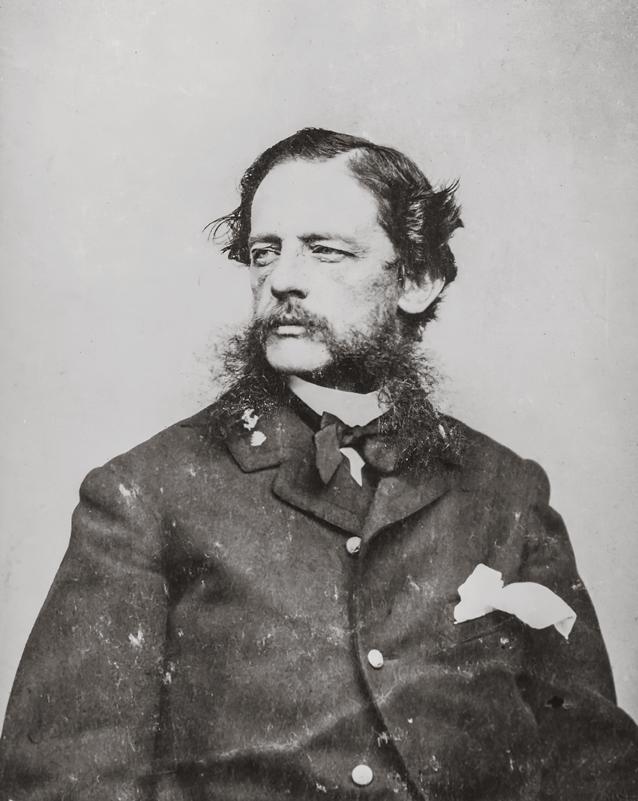
The first naval laboratory,

the Naval Torpedo Station, was established in 1869 on Goat Island off Newport, R.I., following transfer of the Naval Academy to the city during the Civil War. The city came close to being the Academy’s permanent home but for various reasons was not to be.

With the founding of the Naval War College in 1884, recruit
training quickly expanded which historian and author Anthony S. Nicolosi expertly relates in his Navy, Newport and Stephen B. Luce, Navy War College Review Sept.-Oct. 1984, Vol. 37, No. 5. Stephen Luce was born in 1827 in Albany, N.Y., but spent his early years in Washington, D.C., where his father was a civil servant. He began his naval career “at age 14 as a midshipman aboard the receiving ship North Carolina commanded by Rhode Islander Matthew C. Perry.” For the next almost two decades Luce served in a variety of shipboard assignments perfecting his skills and reading extensively about history, likely cultivating a “keen interest in naval professionalism” says Nicolosi, “and the need for its advancement chiefly through formal education and training.”
In an 1843 letter Luce wrote, “Our Navy is in a very imperfect state.” Luce ‘heartily endorsed’ the establishment of a Naval Academy in 1845 and attended briefly in 1848–1849. His attributes were noticed, and Luce was placed on the Academy’s staff at the advent of the Civil War. A May 21, 1864, act of Congress directed relocation from Newport to Annapolis with the Academy leaving Rhode Island permanently soon after Lee’s surrender in April 1865.
Federal Mandate?
Naval Secretary Gideon Welles had argued in Cabinet, according
to author Jay Simson in his Naval Strategies of the Civil War: Confederate Innovations and Federal Opportunism, against a “blockade” and had
simply advocated a closure of the Southern ports by federal mandate. Welles pointed out that a blockade was bound by a set of legal definitions, primarily that
20 CivilWarNews.com January 2022 20 January 2022 CivilWarNews.com
Stephen B. Luce, circa 1865. (NHHC) U.S. Navy frigate, USS Macedonian during the Civil War. (Library of Congress)
Join the Crew! civilwarnavy.com 1 Year—4 Issues: $37.95 Subscribe Now at civilwarnavy.com Or send a check to: CSA Media, 29 Edenham Court, Brunswick, GA 31523 International subscriptions subject to postage surcharge.
Stephen B. Luce, Rear Admiral, 1888.
a country could not blockade itself. In technical terms it was a weapon of war between two sovereign nations or belligerents, and by granting the South ‘belligerent’ status as recognized internationally, the Confederacy was, in effect, given the power to raise foreign loans and purchase supplies from foreign nations.






Nevertheless, Secretary of State Henry Seward convinced President Lincoln to declare a blockade. When Lincoln proclaimed the blockade on April 19, 1861, the main strategic problem...was how the U.S. Navy would enact its part of the strategy. “In 1861 the U.S. Navy was woefully unprepared for the task that faced it. Out of a total of just 90 only half, 42 ships, were in commission; of those only 24 were steam-powered and 18 of those were scattered on foreign stations from the East Indies to Brazil,” according to Simson. In 1860 just three steampowered wooden warships were on station in Northern waters; Mohawk, Crusader, and Pawnee Naval forces became ever more critically important, and the Union Navy’s peak strength rose to 670 ships.
Within days of Lincoln’s announcement, it was said to have proved ineffectual, “when

a Union vessel lying off Havre de Grace, Maryland, gave chase to a vessel loaded with arms and ammunition evaded it and ran safely into port.” On April 28th by a second proclamation the blockade was extended to cover North Carolina and Virginia. Less than a week later three British ships arrived in Charleston prompting a resident who spoke to one of the captains about the cargo and the high profits to be made, to write a friend in England, “Don’t you wish you had a hundred ships for one voyage?”
On May 3, 1861, Lincoln called for 18,000 sailors. Naval forces were needed to attempt covering more than 3,500 miles of coastline containing nearly 200 harbors and inlets, though after all was said and done, blockade runners could not slip through the eventual ‘federal ring’ to “bolster the sagging Confederate economy.”
Luce’s Civil War Service –



USS Carolina (renamed from USS South Carolina), an 1860 Boston-built 217-foot screw steamer purchased by the U.S. Navy in May 1861; outfitted with four 8-inch guns plus one
32-pounder, she was loaded with ordnance and ammunition bound for Pensacola, Fla., to join the Gulf Blockading Squadron at Berwick Bay, La. In June 1861 she took station off Galveston, Texas.
After seeing significant action and taking prizes she was repaired and reassigned to the South Atlantic Blockading Squadron. Luce continued performing his duties with precision and care, from 1863 until the closing week of the war while the Carolina served as a part of the blockading squadron off the Southern coast. Luce compiled the first text on seamanship, published in Newport in 1862, with several updated editions thereafter.
In 1863 Luce received his first independent command, the USS Macedonian Naval academy library records show that over most of the next two years Luce also conducted a Midshipman’s cruise to Europe gathering information on recruit training systems; and later spent time on training ships in Narraganset Bay. By 1866, and now with his own young family, he returned to the Academy as Commandant of Midshipmen, under Superintendent Admiral David Porter, and helped to develop torpedoes. The English
developed a successful propellerdriven torpedo in 1860 and offered them for sale to foreign navies, but the U.S. Navy opted to build its own. In the post-Civil War years Luce recognized the need for professional expertise in the Navy and is credited with many innovations. He died in 1917 at the age of 90.
Join us in the ongoing preservation of Culp’s Hill. Improved sightlines, more visitor access and additional interpretive signage as part of the 2021 rehabilitation of Culp's Hill have helped provide visitors with insights into this key battle site, July 2-3, 1863. Visit the Gettysburg National Military Park Museum & Visitor Center to view the Culp's Hill diorama on display in the Group Lobby before touring the Culp's Hill area of the Gettysburg battlefield. To learn more and support the Gettysburg Foundation's Bream/St. John Culp’s Hill Endowment to ensure this important work is maintained in perpetuity so that future generations can learn from and enjoy a rehabilitated Culp's Hill, visit GettysburgFoundation.org/Culps.
Joan Wenner, J.D. is a longtime contributor and book reviewer for Civil War News and published writer with special interest in Civil War maritime and courts martial topics. Comments are welcomed at joan_writer@ yahoo.com.
866-889-1243
GettysburgFoundation.org
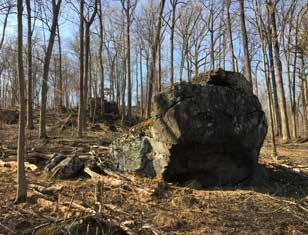


21 January 2022 21 January 2022 CivilWarNews.com CivilWarNews.com
hese rocks and trees offered good cover for marksmen. The surface was ver y steep on our left, diminishing to a gentle slope on our right.
— U NION B RIGADIER G ENERAL G EORGE S EARS G REENE ON C ULP ’ S H ILL
” “
Cliff Sophia | Proprietor CSArms.com 9150 John S. Mosby Hwy. (Rt. 50) Upperville, Va 20185 for US Mail: PO BOX 602 (540) 592-7273 • SophiaCSArms@aol.com Collector’s Arms 1700-1945 Militaria Specializing in Civil War-World War II
Want to Advertise in Civil War News? Email us at: ads@civilwarnews.com
Logbooks of U.S. Navy Ships

NARA
log web page.
Ahoy researchers! Last month, this column featured The Civil War Diary of Gideon Welles, President Lincoln’s Secretary of the Navy. Now, let us take an overview of U.S. Navy’s bluewater ship logbooks. The National Archives—https://catalog. archives.gov—provides these logs online and in a searchable manner. Visit the site listed above and search ‘Logbooks of U.S. Navy Ships.’ Upon entering this section, the user will initially see 1,966 available records. Select ‘1860-1869’ in the ‘Refine By Date’ section to narrow the focus more closely to the American Civil War. Next, select ‘Available Online’ to search through 1,187 Civil War records. See the image above.

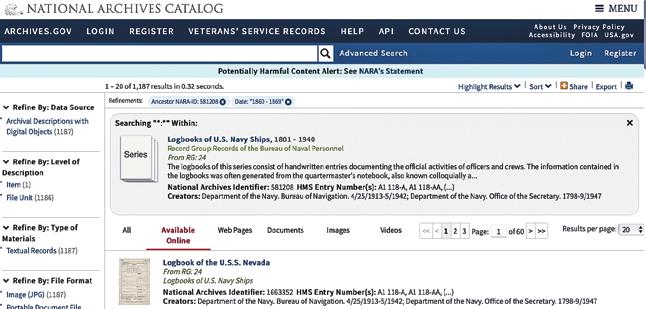
Before initiating a search, a brief review of the history of logbooks reveals naval officers kept logs before the American Civil War, which typically consisted of notes written on individual sheets of paper. A standardized format, and binding of ships’ logs, did not occur until around 1860. These records disclose, on any given day, a ship’s location, the performance of the vessel, weather conditions, supplies received, and observations of various activities, including engaging with Confederate ships.
For example, this writer selected the USS Pembina, a ship assigned to the South Atlantic Blockading
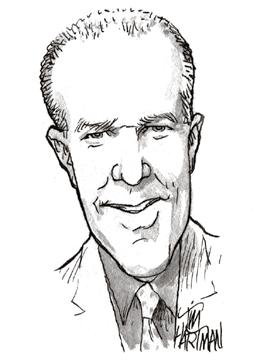
Squadron. As an illustration of early Federal naval attempts to take Savannah, Ga., the “Log of U.S.S. Pembina: 10/16/1861 –9/2/1862” will serve as a model. Note to researchers: utilize other source materials, like the Official Records of the Union and Confederate Navies, to determine dates for specific activities. Users will need to ‘flip’ through each page of the logbook to locate sought-after information. The digitized records appear as a two-page (or a two-day) spread. Researchers can view the logs on the National Archives website or download a PDF file of the entire journal. The latter method typically results in a user-friendly experience, especially if one
wishes to print specific pages.
December 24, 1861: All handson deck as an officer onboard the Pembina, stationed outside Wassaw Sound, observed, on “a clear and very cold day,” he could “see the rebels at work on their fort. The 3 Rebel steamers left.” This Pembina account offers a brief example of the information found within these naval records. The following resources will prove helpful to those researchers seeking additional material on these logbooks. First, the National Archives Special List 44 (shown), available through various online booksellers, or visit WorldCat http://www. worldcat.org/ to locate a copy in a local library. This guide, which
covers 1801–1947, lists warships in alphabetical order and serves as a source for using the website. A second tool resides at the website of Civil War Navy – The Magazine: https://bit.ly/3npITtl. Select this link and download a finding aid recently developed as a collaborative effort between Gary McQuarrie, Managing Editor of the magazine, and Karen Needles, Founder and Head of the Lincoln Archives Digital Project. Continued good luck in researching the American Civil War!
K. Shaffer is a Civil War historian, author, lecturer, and instructor, who remains a member of the Society of Civil War Historians, Historians of the Civil War Western Theater, and the Georgia Association of Historians. Readers may contact him at mkscdr11@ gmail.com or request speaking engagements via his website www.civilwarhistorian.net. Follow Michael on Facebook www.facebook.com/ michael.k.shaffer, and Twitter @ michaelkshaffer.

22 CivilWarNews.com January 2022 22 January 2022 CivilWarNews.com
List of Logbooks of U.S. Navy Ships, Stations, and Miscellaneous Units, 1801–1947.
Navy
Page from the Pembina log.
Michael
Colonel Edward Prince Marker Dedication Woodland Cemetery, Quincy, Illinois
by Professor Earnest Veritas Special Correspondent to Civil War News -Western Theater-
QUINCY, Illinois—A solemn dedication ceremony was held in Woodland Cemetery in Quincy, Ill., Saturday afternoon, October 9, to dedicate a memorial plaque at the grave of Quincy native son, Colonel Edward Prince. A crowd of approximately 25 attended the ceremony to celebrate placing the new gravesite historical plaque.
General Grant (portrayed by living historian Dr. Curt Fields) was on hand to participate with a two-man Honor Guard. The General said a few words about the success and importance of the April 17 to May 2, 1863, Grierson’s Raid. He noted the raid diverted many Confederate resources in the Vicksburg area away from his crossing the Mississippi river; allowing him to cross without a shot being fired in the largest amphibious effort of the war. Colonel Prince of the
7th Illinois Cavalry was second in command of Grierson’s Raid.


Colonel Prince was a Quincy lawyer when the war started. He offered his services to the state of Illinois and Governor Richard Yates accepted, placing him as cavalry drillmaster at Camp Butler in Springfield, Ill., then commissioned Prince as Lieutenant Colonel of the 7th Illinois Cavalry. He became the regiment’s Colonel in September 1861.
After his term of service expired in October 1864, Colonel Prince chose to leave army service, return to Quincy, and resume his law practice. He later became instrumental in the development and provision of the Quincy water supply.

The ceremony included the actual sword carried during the war by Colonel Prince. The sword rested on the grave. The brief ceremony included removing Colonel Prince’s sword and unveiling the new historical marker by the honor guard. The


two young soldiers took the veil off the marker and gave Colonel Prince’s sword to the commander of the American Legion Post no. 37 Honor Guard. After presenting the Colonel’s sword, a 21-gun salute, and “Taps” played by Beth Young, they returned to General Grant, who relieved them of duty.
The new marker reads:
“Colonel Edward Prince was an attorney in Quincy. At the beginning of the Civil War, he offered his services to the Union cause, and Governor Richard Yates appointed him cavalry drillmaster at Camp Butler, near Springfield. In June 1862, Prince was appointed Colonel in command of the 7th Illinois volunteer cavalry. As part of Grant’s siege of Vicksburg, Prince’s regiment took part in Grierson’s raid through
Mississippi in spring 1863.
Colonel Prince retired from the Army in October 1864 and returned to Quincy to continue his law practice and to pursue other enterprises as well.”
Tim Jacobs, Commander of the Tri-States Civil War Round Table, gave a good talk on the life and contributions of Colonel Prince. He expressed how proud Quincy was, and is, of their own Colonel Edward Prince.
General Grant made a few comments on the service of Colonel Prince and emphasized how honored he was to be a small part of such a ceremony. He stressed that this new marker demonstrates that the Quincy heroes of the war will, indeed, never be forgotten.
After Dr. Jacobs and General Grant’s remarks, the ceremony concluded. Solemnity ruled as all
made their quiet ways through the hallowed ground of Woodland Cemetery.
Simply put: tell the simple truth, simply.”
23 January 2022 23 January 2022 CivilWarNews.com CivilWarNews.com
Colonel Prince’s gravesite.
Honor Guard at the gravesite.
Colonel Edward Prince.
Drawings of Colonel Prince, wartime and later in life, courtesy of the Historical Society of Quincy and Adams County.
Dr. Curt Fields is shown with Dr. Tim Jacobs at the ceremony.
Subscribe online at CivilWarNews.com
Professor E. Veritas
Battle of Stones River Reenactment a Success
 by Gregory L. Wade
by Gregory L. Wade
Approximately 2,000 reenactors from across the country gathered outside Lebanon, Tenn., for a reenactment of the New Year’s Eve 1862, and January 1-2, 1863, Battle of Stones River. The event, held on private property near Lebanon just north of Murfreesboro, was organized by members of the Atlanta Campaign, a nonprofit that puts on similar events around the country. Mike Johnson of Christiana, Tenn., visited the camps with son Tuck, age four, who especially liked the artillery and cavalry. Referring to a large Newfoundland dog running among the cannon to the delight

of the crowd, Tuck said, “the dog was fun to!”
After Major General William Rosecrans assumed command of the Federal Army of the Cumberland in 1862, he and his army of 40,000 men marched on Murfreesboro, just thirty miles south of Nashville, to challenge Confederate General Braxton Bragg’s Army of Tennessee. The two forces collided in one of the largest battles of the Civil War that ensured misery for the town and soldiers at the end of 1862.
Technically a Federal victory since the Confederates abandoned the field, both sides were severely depleted with 24,000 casualties.
On Saturday, the reenactors
Historical Reproduction Tents
We make the best tents in history!

The best selection of historical reenactment items from Medieval era to Civil War era. Print catalog is only $2 and includes over 60 pages of our famous tents with a full-color section. Digital catalog is free to download by visiting PantherPrimitives.com.
SEND for your copy TODAY. 304-462-7718

participated in a dawn morning fight in a heavy fog as well as a Sunday morning surprise attack by the Federals on the Confederate camps. Participants from all over the country attended with several from New York, Wisconsin, and Florida. Organizer Earl Zeckman commented to the Lebanon Democrat there were soldiers from as far away as Alaska. There was a period Saturday night dance and a well-attended Sunday morning church service. Since covid began, this is one of the first major events held for the reenacting community; by all accounts it was a success. “The battles were well thought out and lasted a long time,” said Mike Hoover of the Williamson (Tennessee) Grays. “It was one of the better events in quite a while,” he added. Crisp autumn nights and warm, dry days helped make a successful weekend and participants are optimistic the landowner will consider future events. “Maybe there will be another battle scenario here in the future. If there is, sign me up,” said Tim Phillips of Nashville.

The reenactment was visited by school groups viewing the battles as well as visiting camps and
sutler’s row.

Gregory L. Wade is a longtime preservationist and writer from Franklin, Tenn. He has been involved in reclaiming
ground around the core Franklin battlefield and has written numerous articles and columns related to the war in Middle Tennessee.
24 CivilWarNews.com January 2022 24 January 2022 CivilWarNews.com
Panther Primitives • P.O. Box 32 • Normantown, WV 25267
Left to right: Jonathan Yonce, Ocala, Fla., Will Evans, Tampa, and Patrick Adkins Edgewater, Fla.
– MAKER –LEATHER WORKS (845) 339-4916 or email sales@dellsleatherworks.com WWW. DELLSLEATHERWORKS.COM
Quinn Morgan Bellevue, Tenn. (Williamson Grays).
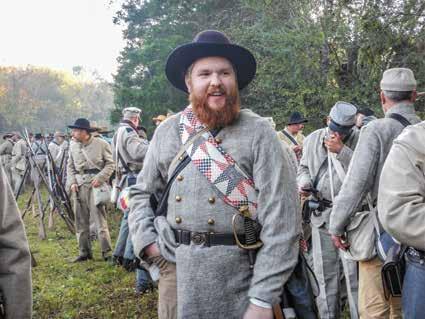






25 January 2022 25 January 2022 CivilWarNews.com CivilWarNews.com
Jeff Williams, Murfreesboro, Tenn. (Tennessee Valley Battalion).
Mike Hoover, Franklin Tenn. (Williamson Grays).
Saturday dawn fighting. All photos by Greg L. Wade.
Confederates on the move.
Chris Hawkins and horse “Dollar.”
Neal Rudy, Peoria, Ill., and dog Cassie 1st Federal Division.



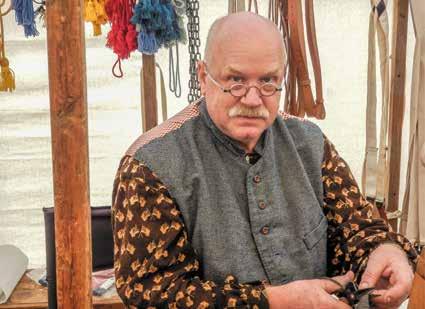


26 CivilWarNews.com January 2022 26 January 2022 CivilWarNews.com DIXIE GUN WORKS, INC. 1412 W. Reelfoot Avenue PO Box 130 Dept. 17 Union City, TN 38281 INFO PHONE: (731) 885-0700 FAX: (731) 885-0440 EMAIL: info@dixiegunworks.com
Works, Inc.
“Hard-to-Find” becomes easy.
have
GUN WORKS’
VIEW ITEMS AND ORDER ONLINE! www.dixiegunworks.com Major credit cards accepted FOR ORDERS ONLY (800) 238-6785 PROFESSIONAL SERVICE AND EXPERTISE GUARANTEED ORDER TODAY! STILL ONLY $5.00
Gun
Where
For generations, re-enactors, modern hunters and competitive shooters
looked to the DIXIE
catalog for the hardest to find blackpowder items. Our all new 2021 catalog continues the tradition with the world’s largest selection of blackpowder replica arms, accessories, antique parts, muzzleloader hunting and sport shooting equipment.
Jack Mason Dixon, Desoto County Miss., 1st Miss Cavalry.
Austin Vick and horse “Merrel” from Lyles, Tenn.
Andy Fulks Fall Creek Sutlery.
First Kentucky, USA. Publishers/Authors
your book(s) for review to: Civil War News
Folly Road, Suite 25 PMB 379 Charleston, SC 29412
Sharon Drake, Piney Flats, Tenn.
Send
520
PLOWSHARES TO SWORDS: ARMING 19TH CENTURY SC
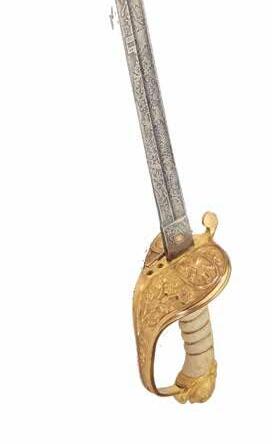
The Confederate secretary of war, Judah P. Benjamin, said, “Laws cannot suddenly convert farmers into gunsmiths.” Consequently, most martial hardware the South used in the Civil War was imported from England. But some weapons were made right here in South Carolina in the 19th century, and some of those were carried into battle.


Our new exhibit has a significant collection of firearms and edged weapons to tell the story of how an agrarian state managed to arm itself while struggling to manufacture independently of industrialized regions. Come see how gunsmiths, silversmiths, and retailers were arming the Palmetto State!



27 January 2022 27 January 2022 CivilWarNews.com CivilWarNews.com
301 Gervais Street Columbia, SC 803 737.8095 crr.sc.gov
during final battle
Federals attacking
scenario.
Deadlines for Advertising or Editorial Submissions is the 20th of each month. Email to: ads@civilwarnews.com
Stacked arms in Confederate camp.
Glorious Victories April 3 and 9, 1865
The Graphic War highlights prints and printmakers from the Civil War discussing their meaning and the print maker or artist’s goals.
We have featured the lithographer, Charles Magnus in previous articles. Remembered largely for his ephemera and books, and his extensive Civil War imprints, Magnus’ output included maps, letterhead or letter sheets with views of many American cities, games, and children’s toys (think lithographic depictions on toy blocks.)
His thoughts and opinions on the war are unknown, but as author E. Richard McKinstry has written, Magnus realized early on that his customers would be northerners. As a result, “he did all he could through the printed word and imagery to promote the Union” to potential customers: soldiers and their families. According to McKinstry, Magnus insured that whatever he was producing, it had a patriotic flavor. “In order to be competitive with his fellow printers, Magnus was opportune in what he produced.”1 Much of his output was generic and “copied from other printmakers. He often altered or combined design elements from several sources, rarely crediting the original artist. Many of his works after 1865 were based on photographs, which he often altered, drawing in figures or re-drawing lines for clearer reproduction.”2
During the war, he “produced around 700 patriotic envelopes and over 300 illustrated song sheets. He produced images of allegorical figures, battle scenes, political cartoons, portraits and state emblems, frequently using the same images in different combinations.”3 Maps, detailing the progress of Union troops,
were a common item.
One particular type he favored was Union encampments. Who wouldn’t want a memento of their time in camp with comrades?
“With a branch office in Washington, D.C., Magnus could create individualized pictures as soon as a new regiment arrived and camped in nearby Virginia or Maryland, then sell them to soldiers eager to send reassuring pictures home to worried families.” They were always “clean-looking camps.”4
His advertising circular is revealing. He boasted products such as “Glorious Union Packet” of songs and decorated letterheads and envelopes for 25cts. The “Army Guides” bundle contained views of all the major battles and “21 Views of Camps and Hospitals in and around Washington and Baltimore at 25 Cts. Each.”5
With Appomattox, the steady stream of battle maps and encampments came to an abrupt end. Then Magnus created the
mother of all prints to celebrate the war’s end. Magnus not only included the events of April 9, Lee’s surrender, but also April 3, the fall of Richmond. The print commemorates the end of the war by showing a central view of Federal troops entering Richmond. It is surrounded by 30 vignette maps of major war battles. Center top is the “piece de resistance” showing Magnus’ jubilation with the words: “The Ever Memorable April 9, 1865 Surrender of Gen. Lee and his Army of Northern Virginia. End of the Rebellion. End of the War.

And Sure Beginning of Peace.”
At bottom center is a portrait of US Grant. Generals Sherman and Sheridan are at top left and lower left respectively. Facing them on the right are Generals Thomas and Kilpatrick. It is unclear why Magnus chose to depict Kilpatrick in the company of the other stellar players in the war. His choice of battles is curious also. In the upper right of the image Magnus depicts the Battle of Fort Morgan, Ala., Aug. 22, 1864, sandwiched between Sherman’s battles at Dallas, Kennesaw, and Atlanta, Georgia. Close examination reveals that
Magnus chose to show miniature battle maps of only those engagements that were fought in the final two years of the war. The earliest shown is the cavalry battle at Yellow Tavern, May 11, 1864, progressing up to Lee’s surrender. He did not cover the Battle of the Wilderness, but depicted the fall of Columbia and Charleston. Clearly, although he produced a large folio print, he had no room for the entire war. Magnus passed away in May 1900, still clinging to the old methods of lithography when the rest of the printing fraternity had moved on to photography, chromolithography, or photolithography. He and the 19th century went out together.
Endnotes:
1. E. Richard McKinstry, Charles Magnus, Lithographer: Illustrating America’s Past, 1850–1900. Winterthur Museum, Oak Knoll Press, 2013, 117.
2. New York State Library from a biographical statement created for the finding aid to the Charles Magnus Collection at the Winterthur Libraryexternal link.
3. Ibid.
4. Harold Holzer, Mark E. Neely,

28 CivilWarNews.com January 2022 28 January 2022 CivilWarNews.com
“In Commemoration of the glorious victories of April 3rd and 9th of April 1865.” Richmond Va. Charles Magnus, NY, 1865. (Library of Congress)
Sales advertisement for Magnus Prints. (Library

Congress)
Jr. The Union Image: Popular Prints of the Civil War North, Chapel Hill: The University of North Carolina Press, 2000, 57.
5. Raymond Marsh, “Who Was Charles Magnus?, Stamps Magazine, February 12, 1949.
After 43 years in the museum field, Salvatore Cilella devotes his time collecting American prints and maps and writing. His last professional position was President and CEO of the Atlanta History Center. His most recent books are Upton’s Regulars: A History of the 121st New York Volunteers in the Civil War (U. Press Kansas, 2009). His two-volume Correspondence of Major General Emory Upton, (U. of Tennessee Press, 2017), received the 2017–2018 American Civil War Museum’s Founders Award for outstanding editing of primary source materials. His latest book “Till Death Do Us Part,” an edit of Upton’s letters to his wife 186870, was published in 2020 by the Oklahoma University Press.
By Lawrence E. Babits
Civil War Alphabet Quiz – T as in...



January
1. US General from Virginia known as “Old Slow Trot” and Rock of “Chickamauga”
2. CS ironclad captured at Mobile Bay
3. US monitor sunk at Mobile Bay
4. CS general WIA at Second Manassas, he lost a leg and was captured in Pickett’s Charge
5. Rosecrans’ successful Tennessee campaign focused on this town


6. John B. Hood was first commander of this famous brigade
7. CSN “aircraft carrier” captured by USN 1862
8. The pursuing train engine in the Great Locomotive Chase
9. What was damned at Mobile Bay
10. Supreme Court Justice who wrote Dred Scott decision
Answers found on page 47.
29 January 2022 29 January 2022 CivilWarNews.com CivilWarNews.com Subscribe online at CivilWarNews.com
of
Florence’s Civil War Legacy and National Cemetery
by Bob Ruegsegger
Florence National Cemetery in Florence, S.C., embraces the remains of more than 2,700 Civil War era soldiers, almost exclusively Union prisoners of war, who were buried in 16 rows of trenches not far from the Florence Stockade.

During the Civil War three rail lines converged at the railroad terminal in Florence; the Wilmington and Manchester, North Eastern, and Cheraw and Darlington. Throughout the conflict, the tracks were actively engaged in transporting troops, artillery, ammunition, and supplies to Richmond, Savannah, Wilmington, and Charleston.
Southern officers feared that the forty-one thousand Union prisoners of war at Andersonville might be liberated and returned to the fighting by General Sherman’s forces as his armies
began their now infamous march through Georgia.
Union prisoners able to travel were removed from Andersonville via rail to keep them out Sherman’s projected march. The town of Florence was selected for its rail transportation connections and its relative remoteness from the mainstream fighting.
Major Frederick F. Warley was ordered to build the Florence Stockade. With the labor of 1,000 enslaved field hands loaned by local planters, Warley began constructing the prisoner of war camp in the early fall of 1864. He hoped to have the camp completed before the 6,500 federal prisoners he was expecting arrived.
The stockade site was about a mile southeast of Florence on a fifteen-to-twenty-acre tract bordering an unhealthy swamp. The prison stockade

was constructed with the only available materials, local timber, and earth. The completed prison compound measured 725 by 1,400 feet. Impressed field hands cut trees eight to twelve inches in diameter and roughly twenty feet in length. The logs were placed in the trench and used to create a solid un-hewn timber wall fifteen feet tall around the perimeter. The enclosed area embraced 1,015,000 square feet. A stream of clear, cold water ran through the entire prison.
A deep ditch surrounded the stockade wall. The dirt from the ditch was heaped high against the timber wall and provided a platform for the guards to walk
on and supervise the prisoners. A cannon was located on each stockade corner to discourage escape attempts.
When the first prisoners arrived by train in September, the stockade had not been completed. Sick prisoners were off-loaded and positioned under the shade of neighboring trees. Other early arriving prisoners were held in the center of a large cornfield.
Inside the stockade, boards about two inches wide and two feet high marked the “dead line.”
Crossing the dead line meant certain death for any prisoner who stepped beyond the line. Sentinels had orders to shoot at the very moment the prisoner entered the forbidden boundary.
The prisoners of war held at Florence Stockade eventually included men from every Northern state. Soldiers from United States Colored Troops, sailors from the Union Navy, and civilians from captured merchant vessels were included among the prisoners.
The South Carolina Reserves performed most guard duties. When thousands of Union prisoners arrived by rail in Florence, General James Chestnut assigned his reserves, old men, and young boys as the prison guards. They arrived for guard duty with the clothes on their backs and armed with an array of obsolete weapons.
During the first six weeks of their service in Florence, the South Carolina Reserves endured the same living conditions forced on their captives, including meager rations, and sleeping in pits for shelter.
On October 2, 1864, the prisoners in Florence were driven into the hastily completed compound where they were soon joined by other Federal prisoners who had been held in the Charleston Fairgrounds.
Eventually, over 16,000 men were imprisoned in the Florence Stockade.
Prisoners were divided, assigned to groups, and allocated portions of the stockade where they could construct huts. Normally, prisoners would dig a square pit in which a number of men would sleep. Above the pit they would erect a series of poles that met on a ridge in the middle. Scraps of tents were draped across the poles and covered with a layer of pine straw and a thin coating of clay. While the improvised roofs would shed light rain, heavy rain would wash away the clay and the attached clay chimneys, requiring the hut roof to be rebuilt.
Rations for prisoners consisted of a pint of corn meal and a tablespoon of dried beans daily. Prisoners had to pool their rations and cook the aggregate over small pine fires.
Florence Stockade was no better than Andersonville. Food and medical supplies were scarce. Even after hospital sheds for the sick soldiers were built, living conditions at the camp were terrible.
Suffering from his own unhealed wounds, Major Warley requested to be relieved of duty. He was replaced by Colonel G. P. Harrison on September 20, 1864. Harrison proved to be ineffectual and was replaced by Lt. Colonel John F. Iverson, the final commandant.

While the hospital sheds offered limited protection from the sun, the pine boughs that initially served as roofs were replaced by wooden shakes that provided better defense from the elements.
Inevitably, the Union prisoners were victims of overcrowding, malnutrition, gangrene, respiratory contagion, and a host of debilitating diseases, as well as

30 CivilWarNews.com January 2022 30 January 2022 CivilWarNews.com
Diorama of the Florence Stockade on exhibit at the War Between the States Museum at 107 S. Guerry Street in Florence, South Carolina. All photos by Bob Ruegsegger.
This figure of a Confederate soldier at the War Between the States Museum illustrates how an adequately equipped prison guard would have appeared to prisoners.
This Civil War Union Burials Historical marker in Florence National Cemetery offers visitors details on the Union burials during the Civil War.
Florence Stockade Visitor Center This unattended visitor center in an open field offers visitors information related to the Florence Stockade and National Cemetery.
cruel punishments for various infractions. Yellow fever, malaria, scurvy, and diarrhea posed serious issues for the prisoners and the hospital stewards.
Limited medical supplies came from Columbia and were kept in the hospital dispensary. Goods received from the U.S. Sanitary Commission, shirts, stockings, and blankets were stored in the dispensary as well. Shipments of milk, coffee, and beef were occasionally received for the benefit of the prisoners.
Overcrowded hospital facilities and shortages of medication intensified the number of prisoner deaths. Prisoners were left lying where they died until their deaths were discovered. Prisoners regularly scavenged corpses to secure needed clothing and other items that could be traded. Fights broke out when prisoners laid claim to the same clothing.
Daily, the bodies of prisoners who died in the hospital were removed from the compound and stacked outside the stockade gate. The bodies were loaded onto army wagons and driven to a nearby plantation owned by Dr. James Howard Jarrott for interment.
In early 1865, one thousand prisoners were paroled and sent to Wilmington and Goldsboro. Others remained behind in the stockade. The prisoners who stayed in the stockade burnt the shelters of those who had been paroled to keep from freezing.
News arrived toward the end February that Wilmington had fallen and the Confederacy was coming apart. When the stockade’s officers “disappeared,” prisoners who remained were permitted to go free. The remaining prisoners were loaded onto trains and sent to North Carolina. The stockade was left empty.

Today, the stockade wall and the dead line have vanished. There are no traces of the prisoners or
Florena Budwin disguised herself as a soldier so she could accompany her husband, an army captain, during the Civil War. She was captured by Confederates and imprisoned in the Florence Stockade. After she fell ill and her gender was discovered, she served as a hospital nurse. She died of pneumonia and was interred in the cemetery.
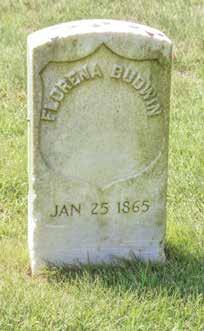
their shelters. The only remnant of the stockade is a portion of the earthen embankment where guards walked. One half the stockade site is an empty field. The rest of the site has been retaken by nature, overgrown and inaccessible.
One-third of the site, where the hospital and main gate stood, is owned by the City of Florence. The other two-thirds of the property are privately owned. Through efforts of the Florence County Historical Society and the Friends of the Florence Stockade, the site has been designated by the Palmetto Trust as one of the most endangered historical sites in South Carolina.
The original burials were

carried out at two separate sites; one contains the remains of 416 prisoners. At the other location, approximately 2,322 soldiers were interred. The interments at the larger site were made in trenches.
Originally, the land for the burials was appropriated. It was later purchased from Dr. Jarrott’s estate. The site was designated a national cemetery in 1865, and the remains of Union soldiers from the smaller initial site were reinterred on the cemetery grounds.


The remains of soldiers from the surrounding area, Darlington, Marion, and Cheraw, were removed and relocated to Florence National Cemetery. Wooden headboards that indicated the original burial trenches were supplanted by sixby-six-inch square marble blocks that marked the graves of over 2,000 unknown soldiers. In 1955,
the marble blocks were replaced by 32 vertical headstones at each burial trench end.
While Civil War era monuments on battlefields and courthouse grounds commemorate duty, heroism, and gallantry, Florence National Cemetery, and other national cemeteries, serve a different purpose. Lined by countless rows of white marble headstones, they serve as grim reminders of the human cost of war and the tragedy of man’s inhumanity to man.
Note: Florence National Cemetery was established in 1865. The cemetery serves over 20,000 veterans in South

Carolina. It is situated on 24 acres and accommodates casketed and cremated remains. Over 300 burials are conducted annually.
Bob Ruegsegger is an American by birth and a Virginian. His assignments frequently take him to historic sites throughout Virginia, the Mid-Atlantic, and the Southeast. His favorite haunts include sites within Virginia’s Historic Triangle— Jamestown, Yorktown, and Williamsburg. Bob served briefly in the U.S. Navy. He is a retired educator and has been an active newspaper journalist for the last twenty years.
Almon Jolls enlisted in the 5th Michigan Cavalry. He died as a POW on November 25, 1864, and was interred in the cemetery. This memorial headstone was erected in his memory.


31 January 2022 31 January 2022 CivilWarNews.com CivilWarNews.com Deadlines for Advertising or Editorial Submissions is the 20th of each month. Email to ads@civilwarnews.com Interment record for Florena Budwin, War Department, Dec. 13, 1954.
Sgt. Jacob Kiester served with the 103rd Pennsylvania Regiment. He died in November 1864 as a prisoner of war at the Florence Stockade.
This marble stone marks the end of one trench in which 137 unknown U.S. soldiers were interred.
“The STORIES BEHIND THE PICTURES” 100 Significant Civil War Photographs CHARLESTON IN WAR
Davis
JACK W. MELTON JR Name Shipping Address City State Zip 160 pages • OVER 100 PHOTOS • MAPS INDEX • BIBLIOGRAPHY • ISBN: 978-1-61850-167-7 Paperback: $19.95 (+$3.50 S & H) • Released Jan. 2020 3 ways to order YOUR COPY! CALL US 800-777-1862 ORDER ONLINE www.historicalpubs.com fill out this form BELOW & mail with a check for $23.45 to: Historical Publications LLC 520 Folly Road, Suite 25 PMB 379, Charleston, SC 29412 (S.C. residents include 9% sales tax of $1.80) 100 Signi cant Civil War Photographs: Charleston in the War features newly restored images of scenes in the famed city, taken 1860–1865. e cameramen include the better-known, such as George N. Barnard and George S. Cook, as well as some lesser-known ones: Samuel Cooley, Charles Quinby, the partners Haas & Peale, Osborn & Durbec. Text by Stephen Davis and Jack Melton accompanies each featured photograph, describing the pictured scenes and the history surrounding them. e selected images depict a variety of settings: that portion of Charleston known as e Battery, the “Burnt District” (the area of the city destroyed by the Great Fire of December 1861), the Charleston Arsenal, and the many churches that allow Charlestonians to call theirs “the Holy City.” Special sections of this book are devoted to the huge Blakely guns imported from England by the Confederates and close-ups of Barnard’s views. e history of Civil War Charleston goes back to e Defense of Charleston Harbor (1890) by John Johnson, Confederate major of engineers, and to Reminiscences of Forts Sumter and Moultrie in 1860-’61 (1876) by Capt. Abner Doubleday, Federal second-in-command. Since then Charlestonians have contributed to the history of their city, notably Robert N. Rosen and Richard W. Hatcher III. e historical text surrounding 100 Signi cant Photographs draws on these and other works. A unique feature is its reliance upon the writings of actual participants, such as Augustine T. Smythe (1842–1914) and Emma Edwards Holmes (1838–1910). As a contribution to this literature, 100 Signi cant Civil War Photographs: Charleston in the War o ers rewards for all readers, from the casual novice to the serious student. CHARLESTON IN THE WAR DAVIS & MELTON 100 SIGNIFICANT CIVIL WAR PHOTOGRAPHS CHARLESTON IN THE WAR
By Stephen
&
Corps counterattack. Lastly an additional seventeen acres were added to the current seventy-two acres CVBT preserved at Myers Hill on the Spotsylvania Court House battlefield.
Central Virginia Battlefield Trust 25th Anniversary Celebration


September 2021 marked CVBT’s 25th year of preserving endangered battlefields in central Virginia. “To date we have saved over 1,520 acres of battlefields that would have been lost forever, and we are proud of this accomplishment,” stated CVBT President Tom Van Winkle. “This is a testament to our founders, successive leadership, and board members.”
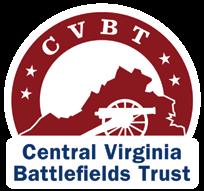
In celebration of the last quarter century CVBT presented a special three-day conference, October 8 through the 10. The event kicked off Friday evening at the CVBT office with the Presidents Reception. The event included complimentary beer
and wine and a full array of hot and cold hors d’oeuvres created by Lisa Van Winkle. Indoor and outdoor tables were provided to allow attendees to be comfortable in a group. Guests were able to catch up with each other after postponement of many gatherings due to the pandemic as well as visit the CVBT base of operations.
Saturday was tour day. Remaining vigilant of the COVID situation, transportation to the two tour stops were by guests’ individual vehicles. Starting the day at 9:00 a.m. the group assembled at Salem Church, part of the May 1863 Chancellorsville campaign. Known in the preservation community as the “lost battlefield,” this site helped
to start the local preservation movement in Central Virginia.
Historian Kris White, Coauthor with Chris Mackowski of Chancellorsville’s Forgotten Front The Battles of Second Fredericksburg and Salem Church, May 3, 1863, served as tour guide. One attendee stated, “Kris’s energy and passion was palatable as he painted a picture of the battle that took place here.” Standing on the grounds, while enveloped by noisy Route 3 traffic and surrounded by modern buildings, brought home the reason this battlefield is commonly used to show what will happen when preservation efforts fall short.
After enjoying lunch at historic Alum Springs Park in Fredericksburg, the tour group pushed on to the day’s second stop, Sunken Road and Willis Hill on the Fredericksburg battlefield. Willis Hill was CVBT’s first-ever preservation victory in 1997. The property was sold to the then Civil War Trust (CWT) for $1.65 million with CVBT contributing as well. The CWT then sold the property to the NPS for $1.52 million absorbing the difference the NPS was not allowed to pay. National Park Service Historian and author Frank O’Reilly, who penned The Fredericksburg Campaign, a lauded in-depth work on the 1862 battle, presented a riveting account of the action that took place in December. In Frank’s usual manner he had the group hanging on his every word. The battle allowed Confederates to choose well-fortified positions including posting the Washington Artillery atop Willis Hill. Captain Charles W. Squires posted two 3-inch rifled cannon in gunpits in front of the Willis Cemetery and beside one of the several brick structures on the crest. An excited tour guest said, “Frank painted a picture so vivid you could see it on your mind’s eye.”
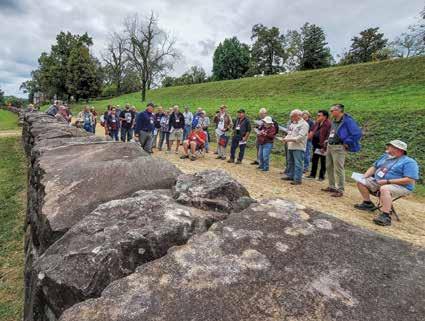
Saturday culminated with the CVBT Banquet and Annual Meeting. Taking a page from CVBT history, the event took place on one of the organizations previously saved battlefields,
in this case the “Stonewall Brigade” tract, part of the famous flank attack during the battle of Chancellorsville. “This was the first on site outdoor conference event in more than ten years,” CVBT President Tom Van Winkle recollected.
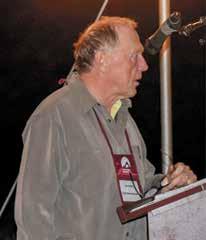

The evening event began with a social hour, then another tradition from CVBT’s past, a barbeque dinner with all the fixings. In the spirit of the celebration a special cake was created complete with the CVBT logo and notation of “25 Years Saving Hallowed Ground.” Opening the evening’s meeting President Van Winkle remarked how exciting it was to see, in person, all the guests. It had been 18 months since the last CVBT event due to COVID.
Van Winkle went on to review the preservation successes of 2020 and 2021.
First up was the newly purchased and preserved 1.1 acres on the Chancellorsville battlefield now known as the “Beckham Tract.” This acquisition was the last piece of the entire historic corner of Orange Plank and Plank roads. On the Wilderness battlefield, CVBT has acquired 30.2 acres of May 6, 1864, James Longstreet’s Confederate First
Three awards were presented to recognize those who have significantly influenced Civil War battlefield preservation. The coveted CVBT Ralph A. Happel Preservation Award was bestowed upon Donald C. Pfanz for penning the letter to several colleagues expressing concern over destruction of battlefield lands in Chantilly, located in northern Virginia. This letter began the modern Civil War battlefield preservation movement and led to creating the Association for the Preservation of Civil War Sites, the precursor to the current American Battlefield Trust, and groups such as the CVBT.
The Dr. Michael P. Stevens Preservation Award was given to Glenn Trimmer. Nestled in the woods of Stafford County, Va., are forty-one acres where the Union Army of the Potomac camped with their new commander General Joseph Hooker. During the winter of 1862-63, more than one hundred thirty-five thousand Union soldiers constructed huts, fortifications, and roads while General Hooker rebuilt his army. Glenn, the director of the nonprofit group The Friends of Stafford Civil War Sites at the time, proposed that a new park should be built on the forty-two acres of land owned jointly by Stafford County and Fredericksburg to honor the Union soldiers who camped there. Glenn, and the Friends of Stafford Civil War Sites, solicited support and materials estimated at over two million dollars. There was no taxpayer money used to
32 CivilWarNews.com January 2022 32 January 2022 CivilWarNews.com
CVBT 25th anniversary cake. All photos by CVBT
ABT President David Duncan (far right) CVBT President Tom Van Winkle (center) CVBT Executive Director Terry Rensel (left) ABT presentation to CVBT.
NPS Historian Frank O’Reilly leads CVBT tour group at Fredericksburg Battlefield’s Sunken Road.
CVBT Founding member James Pates reviews CVBT history.
Musician John Tole plays at dinner.
build this park. The park opened on April 27, 2013.
Recently retired Fredericksburg and Spotsylvania National Military Park Supervisory
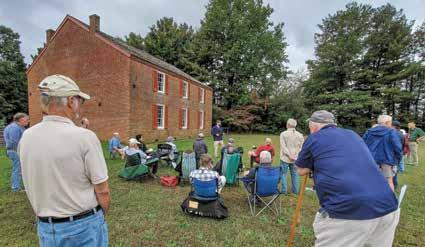
Historian Greg Mertz was recognized with a proclamation from the CVBT for his career spanning over thirty-five years. Greg has been a friend and supporter of the CVBT, as well as many other battlefield groups for years, many times lending his expertise and guiding CVBT programs. Greg is the founding president of the Rappahannock Valley Civil War Round Table and a past vice-president of the Brandy Station Foundation.

Also attending this special anniversary event were many special guests. Under the tent, with a light rain falling, several stories regarding their experience with CVBT over the years were shared. Founding CVBT Board of Directors member Jim Pates recounted the history behind the organization’s creation based on the need for an association to preserve battlefields the NPS was not authorized to purchase.
Kristen Talking Spalding, the Superintendent of Fredericksburg and Spotsylvania National Military Park, spoke about the relationship the CVBT enjoys with the NPS. Kirsten went on to state how important it is that endangered battlefield land outside NPS boundaries and those inside that they are not able to yet purchase is protected.
Chris Mackowski, CVBT Vice President, Editor in Chief of Emerging Civil War, historian, and author excitedly expounded on the importance of the battlefield preservation cause. As a former NPS historian, Chris conveyed the critical need to physically walk on the battlefield and recount what happened where you stand.
Mark Perrault, long time CVBT partner and supporter, stepped up to the podium and declared why he and his wife are supporters. Mark stated “CVBT is preserving endangered battlefields in one of the most difficult areas in Virginia.”


Two CVBT friends, unable to attend the evening, forwarded some comments that were read to all. Author and historian Gordon C. Rhea wrote, “I have deep affection for Central Virginia’s Civil War battlefields. Back in late 1970’s when I was working as an Assistant United States Attorney in Washington, I began visiting the battlefields around Fredericksburg in my scarce down-time.” “It is both a blessing and a curse, however, that those fields occupy beautiful country and are easily accessible from
heavily populated urban centers such as Washington, Richmond, and burgeoning metropolises like Fredericksburg.” “I am eternally grateful to organizations such as the Central Virginia Battlefield Trust that many of the battlefields in the Wilderness and scores of other historic sites have retained their historic luster instead of evolving into golf courses, resorts, and housing developments.”
“I have been a friend of CVBT almost since its inception, and I consider it among the top preservation organizations in the country.”
Recently retired NPS Chief Historian and author John Hennessy offered a note stating, “The biggest mistake any community can make is to assume that the National Park Service can do it alone—protect these priceless historic pieces of hallowed ground by itself. This community, and most notably the founders of the CVBT, recognized this long before most. Through the CVBT, the ethic of land preservation that the NPS had preached for two decades found its way into the fabric of this community.” “The mobilization of the CVBT in the late 1990s was astonishing to watch— one of the great experiences of my career. Non-profits form every day, of course. But this one had an energy and panache unlike anything I had ever seen.” “Vision, determination, endurance, and personal commitment have translated into a great gift of heritage and perpetual open space to both this region and this nation.”
Rounding out the evening a special guest, David Duncan, President of the American Battlefield Trust, was in attendance and surprised CVBT with a presentation and gift. David spoke to the audience and touted the relationship both the CVBT and the ABT has realized

for years. How each organization compliments each other and lends support when the other requires it. David agreed with Tom Van Winkle’s mantra of “It does not matter who gets the credit, just get the job done.” David presented CVBT with a beautiful, framed map of all the CVBT preserved properties on the four battlefields and included those that both the ABT and CVBT partnered in saving.
The three-day conference and celebration concluded Sunday morning with a breakfast on historic Stevenson Ridge on the Spotsylvania battlefield. This beautiful event site sits adjacent to Spotsylvania National Battlefield and has trenches running through the back of the privately owned property. Along with a terrific buffet breakfast, the group was treated to a talk given by keynote speaker A. Wilson Greene, retired from a forty-four-year career as a battlefield preservationist, National Park Service historian, and museum director. Will served as an historian and manager at five national historic sites, and then led the development and operation of Pamplin Historical Park and the National Museum of the Civil War Soldier. His presentation, reflecting on battlefield preservation’s past and future, included the fascinating story regarding the creation of the nation’s first large Civil War battlefield preservation organization, the Association for the Preservation of Civil War Sites (APCWS) for which Will was the first President. Many parallels were drawn with the founding of CVBT.
CVBT President Tom Van Winkle rendered closing remarks emphatically thanking all the CVBT partners for their support through the years. “None of what we have accomplished in this last twenty-five years could have been done without you.” he stated.
33 January 2022 33 January 2022 CivilWarNews.com CivilWarNews.com
Retired NPS Supervisory Historian Gregg Mertz (center) receives proclamation. CVBT President Tom Van Winkle (left) CVBT Vice President Chris Makowski (right).
Donald Pfanz (center) receives CVBT’s Ralph Happel award. CVBT president Tom Van Winkle (left) CVBT Vice President Chris Makowski (right).
CVBT president Tom Van Winkle giving Conference closing remarks Sunday at Stevenson Ridge.
Kris White addresses tour guests at Salem Church battlefield.
A. Wilson Greene addresses CVBT guests at Stevenson Ridge.
100 Significant Civil War Photographs:





Atlanta Campaign collection of George Barnard’s camera work. Most of the photographs are from Barnard’s time in Atlanta, mid-September to mid-November 1864, during the Federal occupation of the city. With this volume, Stephen Davis advances the scholarly literature of Barnardiana.

Civil War Artillery Book


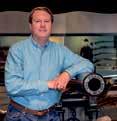



392 page, full-color book, Civil War Artillery Projectiles –The Half Shell Book. For more information and how to order visit the website www.ArtillerymanMagazine. com or call 800-777-1862. $89.95 + $8 media mail for the standard edition.



34 CivilWarNews.com January 2022 34 January 2022 CivilWarNews.com
100 Signi cant Civil War Photographs: Charleston in the War features newly restored images of scenes in the famed city, taken 1860–1865. e cameramen include the better-known, such as George N. Barnard and George S. Cook, as well as some lesser-known ones: Samuel Cooley, Charles Quinby, the partners Haas & Peale, Osborn & Durbec. Text by Stephen Davis and Jack Melton accompanies each featured photograph, describing the pictured scenes and the history surrounding them. e selected images depict a variety of settings: that portion of Charleston known as e Battery, the “Burnt District” (the area of the city destroyed by the Great Fire of December 1861), the Charleston Arsenal, and the many churches that allow Charlestonians to call theirs “the Holy City.” Special sections of this book are devoted to the huge Blakely guns imported from England by the Confederates and close-ups of Barnard’s views. e history of Civil War Charleston goes back to e Defense of Charleston Harbor (1890) by John Johnson, Confederate major of engineers, and to Reminiscences of Forts Sumter and Moultrie in 1860-’61 (1876) by Capt. Abner Doubleday, Federal second-in-command. Since then Charlestonians have contributed to the history of their city, notably Robert N. Rosen and Richard W. Hatcher III. e historical text surrounding 100 Signi cant Photographs draws on these and other works. A unique feature is its reliance upon the writings of actual participants, such as Augustine T. Smythe (1842–1914) and Emma Edwards Holmes (1838–1910). As a contribution to this literature, 100 Signi cant Civil War Photographs: Charleston in the War o ers rewards for all readers, from the casual novice to the serious student. CHARLESTON
WAR DAVIS & MELTON 100 SIGNIFICANT CIVIL WAR PHOTOGRAPHS CHARLESTON IN THE WAR 100 Signi cant Civil War Photographs: Charleston in the War features newly restored images of scenes in the famed city, taken 1860–1865. The cameramen include the better-known, such as George N. Barnard and George S. Cook, as well as some lesser-known ones: Samuel Cooley, Charles Quinby, the partners Haas & Peale, Osborn & Durbec. Text by Stephen Davis and Jack Melton accompanies each featured photograph, describing the pictured scenes and the history surrounding them. The selected images depict a variety of settings: that portion of Charleston known as The Battery, the “Burnt District” (the area of the city destroyed by the Great Fire of December 1861), the Charleston Arsenal, and the many churches that allow Charlestonians to call theirs “the Holy City.” Special sections of this book are devoted to the huge Blakely guns imported from England by the Confederates and close-ups of Barnard’s views. The history of Civil War Charleston goes back to The Defense of Charleston Harbor (1890) by John Johnson, Confederate major of engineers, and to Reminiscences of Forts Sumter and Moultrie in 1860-’61 (1876) by Capt. Abner Doubleday, Federal second-in-command. Since then Charlestonians have contributed to the history of their city, notably Robert N. Rosen and Richard W. Hatcher III. The historical text surrounding 100 Signi cant Photographs draws on these and other works. A unique feature is its reliance upon the writings of actual participants, such as Augustine T. Smythe (1842–1914) and Emma Edwards Holmes (1838–1910). As a contribution to this literature, 100 Signi cant Civil War Photographs: Charleston in the War o ers rewards for all readers, from the casual novice to the serious student. Stephen Davis JACK W. MELTON JR. CHARLESTON IN THE WAR 160 pages, Over 100 Photos, Maps, Index, Bibliography, Softcover. ISBN: 978-1-61850-167-7 $19.95 + 3.50 S&H Order online at www.HistoricalPubs.com or call 800-777-1862
IN THE
The American Civil War was the first war in which both sides widely used entrenchments, repeating rifles, ironclad warships, and telegraphed communications. It was also the first American War to be extensively photographed. Mathew Brady, Alexander Gardner and Timothy O’Sullivan are famous for having made iconic photographs in the Civil War’s eastern theater. George N. Barnard deserves to be ranked in this top tier for his photographic A civilian photographer hired by Gen. William T. Sherman’s chief engineer to take pictures of fortifications around Atlanta, Barnard took several hundred of them in and around the city in the fall of 1864. His most famous is the site of Union Maj. Gen. James B. McPherson’s death in the battle of Atlanta, July 22, Thus far, no comprehensive, definitive listing has been made of the photographer’s work. The Library of Congress has 130 images; the U. S. Military Academy at West Point, New York, has at least 98 photographs, donated by Captain Poe’s widow. Other repositories, such as the Gilder Lehrman Institute of American History in New York City, have smaller collections. For this book we have chosen a hundred images we deem “significant,” though other students may wonder at some of our selections. We hope that this work will stimulate further interest in Barnardiana, and that other scholarly volumes are yet to come. The Atlanta Campaign STEPHEN DAVIS 100 SIGNIFICANT CIVIL WAR PHOTOGRAPHS ATLANTA CAMPAIGN $19.95 + $3.50 shipping 128 pages, photographs, maps, bibliography. $19.95 + $3.50 shipping. Softbound. ISBN: 978-1-61850-151-6. www.HistoricalPubs.com. Order online at www.HistoricalPubs.com or call 800-777-1862 Publishers/Authors Send your book(s) for review to: Civil War News 520 Folly Road, Suite 25 PMB 379 Charleston, SC 29412 Flatbed Artillery Trailer Call Sgt. George Southwick for details. CUSTOM BUILT Built to specs for Pete Jorgensen. Designed to carry two full size guns & a limber, $3300. 802-456-8156 Want To Advertise In Civil War News? Email us at ads@civilwarnews.com Call 800-777-1862 Mike@MKShows.com • www.MKShows.com Admission Coupon To Any MKShows Event $1 Off 770-630-7296
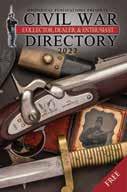

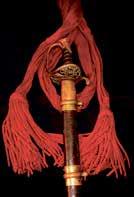















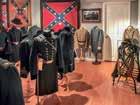








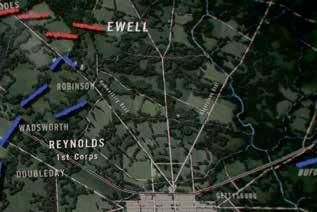







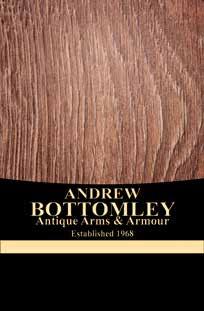



























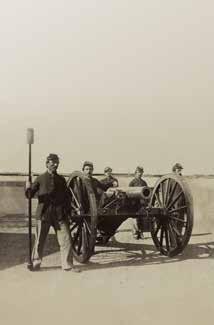







THE FINEST HISTORICAL ANTIQUE MILITARIA Wallace Markert csacquisitions@gmail.com 16905 Nash Road • Dewitt, Virginia 23840 804-536-6413 www.csacquisitions.com JJ Military Antiques Buying and Selling Original Rev War – WWII Guns, Swords, Bayonets, Molds, Flasks, Tools and Accoutrements. Specializing in all Civil War Union & Confederate Artifacts. www.jjmilitaryantiques.com PO Box 18 • Mt. Bethel, PA 18343 • Phone: 610-599-0766 Email: info@jjmilitaryantiques.com Promoters of Quality Shows for Shooters, Collectors, Civil War and Militaria Enthusiasts Military Collectible & Gun & Knife Shows Presents The Finest Mike Kent and Associates, LLC • PO Box 685 • Monroe, GA 30655 (770) 630-7296 • Mike@MKShows.com • www.MKShows.com Northwest Georgia Trade Center 2211 Dug Gap Battle Road Dalton, GA 30720 January 30 & 31, 2021 Chickamauga (Dalton) Civil War Show Williamson County Ag Expo Park 4215 Long Lane Franklin, TN 37064 December 4 & 5, 2021 Middle TN (Franklin) Civil War Show l Shiloh Buying & Selling Authentic Civil War Artifacts 2405 Oak Grove Road Savannah, TN 38372 731-438-3541 ShilohRelics.com History@shilohrelics.com owner Rafael Eledge .com Dealing in the Finest Authentic Militaria Since 1995 with an Emphasis on the American Civil War Pistols, Muskets, Carbines, Rifles, Bayonets, Swords, Uniforms, Headgear, Belt Buckles, Cannon, Buttons, Bullets, Artillery Implements Etc. Mid West Civil War Relics MidWestCivilWarRelics.com Allen Wandling Phone: 618-789-5751 Email: awandling1@gmail.com Museum Quality Civil War Union & Confederate Artifacts! We handle the Best Antique Bowie Knifes, Civil War Swords, Confederate D-guards, Antique Firearms, Dug Relics, Buckles & Belts, Identified Relics, Letters, Documents, Images, Currency, Uniforms, Head Gear & Flags. CONSIGN TODAY Contact our Acquisitions Department by calling Email: guns@rockislandauction.com WWW.ROCKISLANDAUCTION.COM 2022 AUCTION SCHEDULE: Premier: May 13-15 Sporting & Collector: Feb. 16-18 (DATES SUBJECT TO CHANGE) Visit our website ROCK ISLAND AUCTION COMPANY REAL ART REAL HISTORY #1 FIREARMS AUCTION COMPANY IN THE WORLD! REAL IRON Documented Historic “National Treasure” Archive of Items Owned by Medal of Honor Recipient Colonel Jacob G. Frick, Including an Extraordinary Inscribed Tiffany & Co. Civil War Non-Regulation Infantry Officer’s Sword, Inscribed Walking Stick Made from a Flag Staff Shot from Frick’s Hands, and a Second Officer’s Sword SOLD $184,000 Military Contract E Company No. 120 Revolver: The Last Martial Colt Walker Manufactured and One of the Finest Martial Examples Extant SOLD $1.035 Million Undisputed World Leader for Quality Collectable and Antique Firearms ® 297 Steinwehr Avenue • Gettysburg, PA 17325 717-334-6245 • GettysburgMuseum.com @GettysburgHeritageCenter Operated by the non-profit Gettysburg Nature Alliance Award-Winning MUSEUM Orientation MAP EVENTS... Licensed Battlefield Guided & Other TOURS Gift SHOP BookSTORE Visitor INFORMATION Accoutrements www.csarms.com PO Box 602 9150 John S. Mosby Hwy. Upperville, Virginia 20185 Shop Phone: 540-592-7273 Email: sophiacsarms@aol.com weaves the history behind Civil War flags of Tennessee: the stories of the women who stitched them, the regiments that bore them, and those who served under them and carried them. THE UNIVERSITY OF TENNESSEE PRESS GET YOUR BOOKS DELIVERED UTPress.org or 800-621-2736 This book Please see our website www.AndrewBottomley.com Mail Order Only • Worldwide Shipping Calling the UK from overseas: +44 1484 685 234 Calling our UK cellphone from outside the UK: +44 7770 398 270 email: sales@andrewbottomley.com The Coach House • Huddersfield Rd. HOLMFIRTH West Yorkshire United Kingdom HD9 3JJ £1,650 £1,850 £6,500 £3,850 £2,850 £1,850 Ref. 3123 Ref. 3046 Ref. 3156 Ref. 2919 Ref. 3112 Ref. 3394 Valuable Colts Attributed To Rembrandt Peale. 34 York St • Gettysburg, PA 17325 717-334-2350 • CIVILWAR@UNIONDB.com uniondb .com All Hands on Deck! Support Our Mission to Bring You the Naval History “This is the magazine for all things Civil War Navy. From ‘Uncle Sam’s web-feet’ to the ‘grey jacket navy’ raised by Jeff Davis! It is all here thoroughly researched and illustrated by beautiful contemporary navy images.” Ron Field, military historian and author of over 45 books, including Bluejackets: Uniforms of the United States Navy in the Civil War Period, 1852-1865. 1 Year—4 Issues: $37.95 Subscribe Now at civilwarnavy.com Or send a check to: CSA Media, 808 Drayton St., Savannah, GA 31401 International subscriptions subject to postage surcharge. Sailors and Marines on the deck of the U.S. gunboat Mendota, 1864. National Archives (Identifier 524548). P.O. Box 342 Thompsons Station, TN 37179 615-585-0115 Email: brubon2@bellsouth.net Franklin Relics Specializing in Accoutrements, Edged Weapons, Firearms and Uniforms FranklinRelics.com Bruce Hohler Proprietor www.AmericanRelics.net Allen Phillips 1014 Reservoir St., Suite B Harrisonburg, VA 22801 Phone: 540-476-1969 Email: americanrelicsnet@gmail.com American Relics Specializing in Buttons, Buckles, Currency, Hat Devices and other Military Artifacts. www.CivilWarBadges.com Everitt Bowles, Owner • 770.926.1132 1036 Washington Avenue Woodstock, Georgia 30188 The Largest Selection of GAR & UCV Hundreds of Memorabilia Items from Rev War through Vietnam Secure & Easy Guaranteed Authenticity of Every Item Vin Caponi Historic Antiques Vin Caponi, Jr. 18 Broadway Malverne, NY 11565 Store: 516-593-3516 Cell: 516-353-3250 rampantcolt@aol.com http://www.vincaponi.com We carry a very large inventory of Colt and Civil War firearms including muskets, carbines, rifles and accoutrements. Our inventory of historic antiques and firearms begin at the early collectors level and range all the way up to the advanced collector and investors level. 8895 Town and Country Circle • Knoxville, TN 37923 Phone: 865-693-3007 info@armyoftennesseerelics.com Civil War Artifacts Nick Periut Proprietor ArmyofTennesseeRelics.com Buying and Selling High Quality Images, Belt Buckles and Plates, Artillery Shells, rare Bullets and Buttons! Contact Glenn Dutton at: glennjdutton@aol.com or 770-351-7565 BUYING & SELLING Field & Heavy Artillery Cannon, Shells, Fuses & Etc. The 2022 Civil War Dealers Directory is out. To view or download a free copy visit: civilwardealers.com/dealers.htm The 2021 Civil War Dealers Directory is out. To view or download a free copy visit: www.civilwardealers.com/dealers.htm The 2022 Civil War Dealers Directory is out. To view or download a free copy visit: civilwardealers.com/dealers.htm The 2022 Civil War Dealers Directory is out. To view or download a free copy visit: civilwardealers.com/dealers.htm
www.emergingcivilwar.com
From the Editor

Most of us, I know, tend to think of summer as “campaign season” for Civil War battles. The roads finally dried up enough for the armies to move after long, restless winters hunkered down in camp life. Summer is also the time when most of us, today, are able to visit battlefields and explore the Civil War history we love so much. The weather is generally warmer and more cooperative, that’s for sure! Conversely, November does NOT usually spring immediately to mind as prime campaign season. Yet, because of my proximity to the Mine Run battlefield, I’m always reminded of just how much activity took place in this second-to-last month of the year.
The 1863 Mine Run Campaign kicked off on Thanksgiving Day
and wrapped up in bitter killing cold during the first two days of December.
Set against that depressing anticlimax in the east was Ulysses S. Grant’s splashy victory in Chattanooga, Tenn. “Grant has undoubtedly shown very superior abilities,” Army of the Potomac commander George Gordon Meade wrote on December 20, 1863, after Mine Run and Chattanooga, “and is I think justly entitled to all the honors they propose to bestow upon him.” One of those honors would be a promotion that put Grant in command of Meade.

While all of that was unfolding, James Longstreet was trying to knock his way into Knoxville, Tennessee.
Look at other Novembers during the war. In 1861, there was the battle of Belmont. In 1862, George McClellan got canned. In 1864, Sherman began his March to the Sea and John Bell Hood began his fateful march toward Spring Hill and Franklin. We could also call up smaller engagements and events over those first four Novembers, too. By November 1865, of course, most soldiers on both sides were back home to enjoy Thanksgiving with their families.
All of us at Emerging Civil War wish you and your families the very best this Thanksgiving season.
— Chris Mackowski, Ph.D. Editor-in-Chief
The 8th Annual Emerging Civil War Symposium at Stevenson Ridge
Early-bird tickets are still on sale through December 31 for the 8th Annual Emerging Civil War Symposium at Stevenson Ridge, August 5-7, 2022. We’ll be tackling “The Great What Ifs of the Civil War,’ and have we got a fantastic line-up of speakers:
Keynote Speaker Garry Adelman, “The What Ifs of Gettysburg and More”
• Sarah Kay Bierle
• Neil Chatelain
• Sean Chick
• Phill Greenwalt
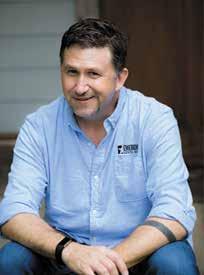
• Brian Matthew Jordan
• Jon Tracey
• Kris White
We’ll also have a panel discussion on the What Ifs of the Maryland Campaign and a panel discussion “What Ifs of the Civil War.” On Sunday, Kristopher D. White & Chris Mackowski will offer a tour of the Slaughter Pen Farm and talk about some of the What Ifs of the battle of Fredericksburg. For more information, or to order tickets, visit the Symposium page on our website: https://emergingcivilwar. com/2022-symposium.
ECW News and Notes
Edward Alexander is now enjoying fatherhood! His wife Alison gave birth to Madeline Grace Alexander on October 23. “We’re all figuring out a routine and enjoying our time at home together,” he says. “Looking forward to seeing which battlefield trails are stroller friendly!”

Sarah Kay Bierle made a trip to California for a family event and was also able to get back to The Huntington Library to gather unique archival research for several of her upcoming projects and books.
Sheritta Bitikofer took a trip to Andersonville National Historic Site for their Civil War Day to tour the recreated stockade and attend a presentation by Dr. Damian Shiels on Irish American POWs at the prison. She’s also been reading into the interesting history behind quilts being used along the Underground Railroad and how they assisted the enslaved toward self-emancipation.
Meg Groeling will be appearing virtually at three locations in December:
• December 8, 2021-8:30 PM
ET “Civil War Talk”
• December 9, 2021-3:30
PM ET “A House Divided” Show
• December 16, 2021-6:30
PM ET “American Civil War Museum”
This is only the beginning of Meg’s First Fallen World Tour of 2021-22, so keep your calendars open for events near you! “If anyone makes cancer slouch hats in a Civil War theme, please let me know ASAP,” she adds. “Thanks!”
Dwight Hughes signed copies of Unlike Anything That Ever Floated at the Gettysburg Heritage Center on Saturday, Nov. 20.
From Brian Matthew Jordan:
• I published “’What I Saw Would Make You Sick’: Union Soldiers Confront the Dead of Antietam,” in Charles Mitchell and Jean H. Baker, eds., The Civil War in Maryland Reconsidered (Louisiana State University Press, 2021).
• I submitted to the University of Georgia Press an edited collection, Final Resting Places: Reflections on the Meaning of Civil War Graves (co-edited with Jonathan W. White, with a foreword from David Blight). The book will be published in 2022.
• Civil War Times published an interview with me based on my recent book, A Thousand May Fall, in its October issue.
• I have been busy on the speaking circuit giving recent presentations to the Marblehead (Mass.) Museum; the Dan Sickles Civil War Round Table (White Plains, N.Y.); Wisconsin Veterans’ Museum; Kenosha (Wisc.) Civil War Museum; Blinn College (Bryan, Texas); and Pasadena (Calif.) Civil War Roundtable.
David Powell’s book “Decisions at Shiloh” just went to the University of Tennessee Press for publication. “It will probably be out in the spring 2022,” Dave says.
Chris Kolakowski gave the keynote address for the Veterans Day ceremony at the Wisconsin State Capitol, in which I addressed the Tomb of the Unknown Soldier’s centennial and the nature of service and sacrifice. Video is at wiseye.org.
Chris Mackowski and Kris White co-hosted a conversation with best-selling author Jeff Shaara as the keynote session to the American Battlefield Trust’s fall Virtual Teacher Institute on Thursday, November 11 (an event Kris organizes and directs). Shaara talked about his career as a writer and the importance of telling a good story.
Chris also presented a session at the Virtual Teacher Institute, “Seeing the First Draft of History: Technology, the News, and Media Ethics.” The talk looked at the way visually-based technologies can present ethical challenges to news gatherers and how educators can use examples of those instances as tools in their classrooms for talking about ethics. Examples spanned Gardner’s photos “The Dead of Antietam,” Walter Cronkite’s Vietnam coverage, live coverage of 9/11, through memes on digital media.
In December, Kris and Chris are off on a Western Theater adventure with Garry Adelman as part of the next American Battlefield Trust video swing. Stay tuned for ABT’s Facebook page for details (we’ll also repost segments on ECW’s FB page as we’re able).
From Nathan Provost: “My book review for The Cavalry at Appomattox by Edward Longacre was put up on StrategyPage. I will be traveling to Virginia the week of Nov. 17-20, for research on my dissertation.”
Codie Eash reviewed Brian Swartz’s Passing Through the Fire for the Civil War Monitor. Eash said, “Swartz succinctly yet thoroughly reaches beyond the Chamberlain mythology to reveal how the Civil War impacted one man so deeply.”
Kris White and Steve Stanley recently completed the next volume of the “Maps of the American Battlefield Trust” book series. Volume 3, The Maps of the Revolutionary War, is set to hit bookshelves in March 2022.
36 CivilWarNews.com January 2022 36 January 2022 CivilWarNews.com
Subscribe online at CivilWarNews. com
Chris Mackowski
George Gordon Meade (left) had less to be thankful for by the end of November 1863 than Ulysses S. Grant (right).
Edward Alexander (right), his wife, Alison, and their daughter, Madison Grace.
The new editions of Vols. 1 & 2 will hit bookshelves by the end of the year.
Kris will be at the Hershey CWRT in February (on Zoom) talking about the Bliss Farm at Gettysburg.
10 Questions . . . with Jon-Erik Gilot

Jon-Erik Gilot serves as the secretary on ECW’s Board of Directors and is co-coordinator (with Sarah Kay Bierle) of the ECW Symposium. He was first profiled in the February 2019 ECW newsletter: https:// conta.cc/2T9qS4r. You can read his full ECW bio here: https://emergingcivilwar.com/ author-biographies/authors/ jon-erik-gilot.

continues to creep into the eastern panhandle, there are still many sites in the greater Harpers Ferry area associated with the raid. Our book includes two appendices, a walking tour of sites in the lower town, and a driving tour of outlying sites, from the Kennedy Farmhouse where Brown secreted his army in the months leading up to the raid, to Charles Town, where Brown was jailed, convicted, and executed, and many stops in-between.
You are instrumental in planning for the ECW Symposium. What did you learn from last year’s event that you’re applying to the 2022 event that’ll make it even better? You have to give people what they want. Our attendees are generous (and frank) in offering feedback for us to build on. So, when they asked us to bring back the popular Friday evening panel, we took it a step further and added an additional panel on Saturday. More time for questions? You got it! Longer breaks between speakers? Done! The banter and interaction between our attendees (and even our speakers) makes our annual symposium so much fun. I can’t wait to see everyone back at Stevenson Ridge next August!
the Civil War era? William Woods Averell, one of the many casualties of Little Phil Sheridan. What’s a bucket-list Civil War site you’ve not yet visited? While I visited Key West a few years ago, I did not make it out to Fort Jefferson at Dry Tortugas. I need to see that place.
Favorite ECWS book? Ryan Quint’s Determined to Stand and Fight does justice to the rag-tag group assembled at Monocacy to confront some of the best fighting units of the Army of Northern Virginia. A great book on an interesting little battle.
ECW Bookshelf

As part of our yearlong celebration of ECW’s 10th anniversary, we’ve been running a series on the blog that highlights each of the books in the Emerging Civil War Series. We’re extremely proud of the work our authors have done on our books since the first release in 2012, and we’re grateful to our publisher, Savas Beatie, for their ongoing support.
On November 12-14, Emerging Revolutionary War held its first annual bus tour. Led by historians Mark Maloy and Billy Griffith, attendees toured the sites
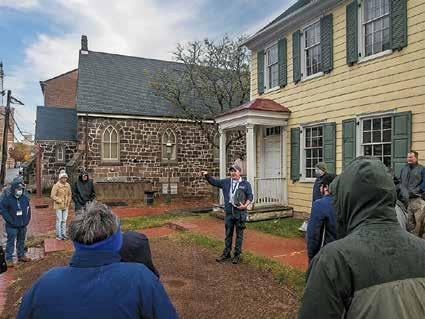

connected with the “Ten Crucial Days,” the Battles and Campaigns of Trenton and Princeton. There was even a sighting of George Washington along the banks of the Delaware River!
Plans are already in place for next year’s bus tour, “The Rise of the American Army: Valley Forge and the Battle of Monmouth.” Head on over to Emerging Revolutionary War’s Facebook or blog for more information and how to secure your ticket. Make sure to follow our blog, emergingrevolutionarywar. org.
You Can Help Support Emerging Civil War
Emerging Civil War is a 501(c)3 not-for-profit organization. If you’re interested in supporting “emerging voices” by making a tax-deductible donation, you can do so by you can do so by clicking here visiting our website: www. emergingcivilwar.com.

What are you working on these days? Too much! Magazine and website articles, essays for various ECW 10th Anniversary books, and trying to keep up with my regular ECW obligations. I’d like to take a step back in the new year and refocus my efforts on my next project. Stay tuned. You just wrapped up work on a manuscript with Kevin Pawlak about John Brown’s raid. Can you tell us a little about that project? Harpers Ferry is my favorite place on this earth, so much so that I proposed to my wife on Maryland Heights. I find myself back there several times each year for work or pleasure, and while Harpers Ferry has many stories to tell, it’s most synonymous with John Brown’s Raid. Brown is a fascinating, often misunderstood or misrepresented character. The goal wasn’t to change any hearts or minds with this book, but rather to offer an accessible introduction to John Brown, what brought him to Harpers Ferry, and what happened there that would ultimately catapult our country towards civil war.
Aside from Harpers Ferry, obviously, are there still places to see associated with Brown’s raid? Even as suburban sprawl
As a West Virginian, what’s your favorite Civil War site in West Virginia? I’ll add a “besides Harpers Ferry” caveat here since we’ve established that as my favorite. There’s something special about Middleway, W.V., in Jefferson County. Walking down Queen Street is like stepping back into the 19th or even 18th centuries, void of almost any modern intrusions. Fighting swirled through town in August 1864, and even today you can line up James E. Taylor’s 1864 sketches as perfectly as the day he drew them.
Lightning Round (short answers with a one-sentence explanation)
Favorite primary source? Though long out of print, the aforementioned With Sheridan Up the Shenandoah Valley— Leaves from a Special Artist, Sketchbook and Diary by James E. Taylor is a nearly-impossibleto-find gem. A publisher should really look at getting that reprinted and into more people’s libraries (Hint, Hint: Ted Savas).
Favorite Civil War-related monument? The U.S. Grant monument at Union Square in Washington, D.C., not so much for Grant himself, but the scenes around him with the cavalry charge and flying caisson are simply stunning.
Favorite unsung hero of
The series has been a lot of fun. Please read along to hear some behind-the-scenes stories from our talented cadre of historians and writers: https:// emergingcivilwar.com/tag/ ecws-series.
The Emerging Civil War Series is at 41 books, with #42 ready to ship from the printer before year’s end.
37 January 2022 37 January 2022 CivilWarNews.com CivilWarNews.com
ECW Secretary Jon-Erik Gilot.
The ERW tour group at Washington’s Crossing with George Washington.
Mark Maloy in a classic tour guide pose at Washington Crossing State Park in Penn.
Mark Maloy and Billy Griffith in action at the Thomas Neely House.
by Jonathan A. Noyalas, Director
Journal Celebrates 5 Years
When I came to Shenandoah University in January 2017 as director of the McCormick Civil War Institute (MCWI), I believed there was a glaring need for an annual publication devoted exclusively to the complexities of the Shenandoah Valley’s Civil War era. With the enthusiastic support of the University’s administration and encouragement from colleagues in the field, Journal of the Shenandoah Valley during the Civil War Era was born.


Over the past five years more than fifty historians, from established scholars such as Edward Ayers, Gary Gallagher, and Caroline Janney to some of my Shenandoah University undergraduate students in Civil War Era Studies, have

contributed to the Journal
Throughout the Journal’s first five years contributions have covered a wide array of topics including personalities, battles and campaigns in the Shenandoah, historical memory, Reconstruction, the experiences of African Americans, and interactions between civilians and soldiers. Additionally, the Journal has published various collections of letters and diaries either from private collections or MCWI’s collections.
As MCWI celebrates five years of publication, we’re already working on volume 6, that will include the excerpted diaries and letters of Privates James and Samuel Smith, 18th Connecticut Infantry.
MCWI is always eager to consider submissions for future volumes. Anyone interested in submitting an essay of original scholarship or an edited primary collection related to the Civil War
era in the Shenandoah Valley that has not before been published to the Journal should reach out to me via email jnoyalas01@su.edu for further details.
All proceeds from the Journal, available at various book retailers and historic sites in the Valley, and on Amazon, support MCWI’s many endeavors including interpretive and educational programs at the University’s portion of the Cool Spring Battlefield, preservation, expansion of our collections, and unique learning opportunities for our students.
Partnership with Fort Collier Civil War Center

On Monday, November 1, MCWI and the Fort Collier Civil War Center in Winchester, Va., established a partnership, or perhaps more accurately resurrected a relationship. More than two decades ago, the site of Fort Collier, an approximately ten-acre site on the wartime farm of Isaac Stine located on the east side of the Martinsburg Pike north of Winchester, came up for sale. The founding director of MCWI, Dr. Brandon Beck, proved an important figure in the preservation and interpretation of the property. Perhaps somewhat interestingly at the time of Fort Collier’s preservation I was an undergraduate student of Dr. Beck’s at Shenandoah University and had an opportunity to work with him on the initial interpretation at the site. Now,
approximately two decades after that work began, MCWI will aid the Fort Collier Civil War Center in expanding the site’s interpretative efforts and in creating educational programs throughout the year. I am appreciative to the Fort Collier Civil War Center for the opportunities this will offer students in Civil War Era Studies at Shenandoah University.
Fort Collier, an earthen fortification constructed in the summer of 1861, is perhaps bestknown as a part of the scene marking the climactic moment of the Third Battle of Winchester. Late on the afternoon of Sept. 19, 1864, five brigades of Union cavalry struck that portion of General Jubal Early’s line facing north. The weight of the Union assault proved too much for Early’s veterans to endure.
“Our cavalry, in deep column, with sabres drawn,” one Union officer wrote, “charged over the Confederate left… This charge was the most stirring and picturesque of the war.”
While MCWI will look to enhance the interpretation of the site’s important connection to the Third Battle of Winchester, it will also explore other aspects of the site including a deeper examination of its construction and its place as one of many earthwork fortifications constructed around Winchester during the conflict. Additionally, interpretive efforts will examine the war’s impact on the Stine family and what that reveals about the broader impact of the conflict on Winchester’s
population. Various programs are being planned for the summer and autumn of 2022. Please follow @ McCormickCWI on twitter for updates about programming. If you are interested in learning more about the Fort Collier Civil War Center or becoming a member please contact the center’s president, John Stevens, at jstevens@su.edu.
Jonathan A. Noyalas is director of Shenandoah University’s McCormick Civil War Institute and a professor in the history department at Shenandoah University. Noyalas is the author or editor of numerous books including most recently Slavery and Freedom in the Shenandoah Valley during the Civil War Era published by the University Press of Florida.
38 CivilWarNews.com January 2022 38 January 2022 CivilWarNews.com
Journal Celebration: MCWI’s director Jonathan A. Noyalas holds a copy of volume 5, Journal of the Shenandoah Valley during the Civil War Era. (Photo by Brandy Noyalas)
View of Fort Collier earthworks on ridge crest. (Photo by Jonathan Noyalas)
Shenandoah University’s McCormick Civil War Institute Celebrating Publication Anniversary & Partnership
By Jack W. Melton Jr.
Hidden Evidence
A Look Inside Civil War Artillery Projectiles
"Through Jack’s superb photography; the collector and professional can now view an extensive exposure to sectioned projectiles. This is new for the average person in that for the first time since radiography; one can examine the internal makeup of a shell."


CWO4 John D. Bartleson Jr., U.S. Navy EOD
Author of Civil War Explosive Ordnance 1861–1865
What do they say?
Jack Melton’s latest endeavor, Civil War Artillery Projectiles – The Half Shell Book, is a remarkable addition to Civil War artillery ammunition literature. For archaeologists and collectors the clearly written text and the excellent photographs provide a wealth of information to properly identify recovered shells and burst fragments. For bomb squad and EOD specialists this book should be on every units’ shelf. The material found in these pages will help EOD personnel identify what has been found, whether or not it is dangerous, and how to inert the round without the necessity of destroying an important historic object. This book takes Civil War artillery ammunition studies to a new level.
Douglas Scott Adjunct Research Faculty, Colorado Mesa University. Author of Uncovering History: Archaeological Investigations of the Little Bighorn.
Theexpedienttriedbytheconfederatesinimitationof

mixingmusketbulletswiththeburstingchargeof
6-PounderSphericalCaseShot
–GeneralHenryL.Abbot
wasentirelyfutilefromwantof weightinthebullets.
Inthisexample,riflebulletswereutilizedasthecaseshotmaterialincluding3-ring.58caliberbullets,3-ring.69caliberbul lets,andU.S.ring-tailSharpsbullets.IthasabrassBormannsupportplug(underplug)thatiscountersunkonbothsidesof
flame’scommunicationchannel.Theblackpowderburstingchargewaspouredinloosearoundthebullets.Thismethoddid notworkverywellandoftenonlysucceededinblowingthefusesout.Projectilesfilledwithbulletsusedascaseshotarerare. Thisspecimenwasrecovered,alongwithotherConfederateandUnionprojectiles,fromthepost-CivilWardumpsitelocated neartheConfederatePowderWorksinAugusta,Georgia.
• 392 pages of full color photographs with descriptions
• Covers projectiles, fuses, canister, grapeshot and more



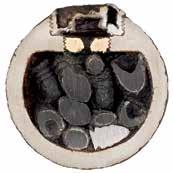
• 850 photos, drawings, radiographs, patents and maps
• A must for every serious artillery enthusiast
left
Wow. I have been reading a lot of different books on ordnance from this era, but this one takes the cake. Most of the other books drift off in directions that are not helpful with the ordnance specific information I am usually looking for. But this book stays on task and topic from start to finish.
Tom Gersbeck MFS, Graduate Faculty, Arson-Explosives Investigation (AEI), School of Forensic Sciences, Oklahoma State University
Jack Melton’s new book Civil War Artillery Projectiles – The Half Shell Book, promises to be one of the most important volumes on Civil War artillery in recent times. Anyone who has studied the wide variety of Civil War projectiles knows that what is inside is just as important, and maybe more so, than what is outside the shell. In this book, cutaway shells are graphically explained with superb color photographs and detailed notes. They reveal important details and differences in a variety of similar projectiles that tell us U.S. from C.S. and between type variations, in a way that no other approach has ever done. It is supremely helpful in explaining to others just how a shell works, whether it is still dangerous or not, and why.
Les Jensen
Former
Curator
of the Museum of the Confederacy
39 January 2022 39 January 2022 CivilWarNews.com CivilWarNews.com
74
ChapterThree –SphericalHalfShells
Diameter: 3.58 inches Bore Diameter: 3.67 inches Gun: 6-pounderSmoothbore Weight:5.2poundsConstruction: Case shot Fusing System:Time,Bormann Fusing Material:LeadandtinalloyFuse Thread Diameter: 1.65 inches Fuse Hole Length:.75 inch Sabot: Cup Sabot Material: Wood Wall Thickness: .31 inch Matrix Material: None Case Shot Material: Lead Case Shot Diameter: Varied calibers Bormann time fuse Brass supportplug Sharpsring tail bullet Horseshoe powdertrain Confederate
the
ourprojectiles,(andoccasionallyusedbyourownmen,)of
smallshells,
259 Civil War Artillery Projectiles – The Half Shell Book Federal 3.8-Inch James Type I Shell Diameter: 3.72 inchesBore Diameter: 3.80 inches Gun: 14-pounder James Rifle Length 6.75 inches Weight: 10.0 pounds Construction: ShellFusing System: Percussion, James Fusing Material: Brass Fuse Thread Diameter: inch Fuse Hole Length: 1.56 inches Sabot: Ring or band, lead (missing) Sabot Height-Width: 2.62 inches Wall Thickness: .62 inch Matrix Material: N/ACase Shot Material: N/A chargeBursting cavity Anvil cap Zinc plunger Iron nipple Fuse powder train Ring base The James percussion fuse consists of bronze anvil cap with a zinc plunger fitted with a nipple. Both are smaller in diameter than the James percussion fuse on the previous page. This sub-pattern is commonly called a tie-ring James due to the visible ring extending below the base of the projectile body. The visible small notches, located in the raised portion of the projectile’s ribbed body, were developed in an attempt to improve the chances of the lead sabot remaining attached to the projectile body during firing. This pattern James projectile is less common than the flat based James projectile. James percussion fuse
Purchase Online at www.ArtillerymanMagazine.com
form and mail to the address below. Name: Mailing Address: City: State: Zip Code: Phone: Email: ☐Standard Edition $89.95 + $8 shipping* = $97.95 ☐Deluxe Edition $175.00 + $8 shipping* = $183.00 (100 limited edition copies) *Shipping via USPS Media Mail. USA Only. International orders email for shipping quote. If you wish to have the author inscribe the book beyond signing and dating it (on the title page) please indicate your preferred text below: Custom Text: U.S. Dollars Only Check or Certified Funds Check# Make checks payable to: Historical Publications LLC ☐ Discover ☐ Mastercard ☐ Visa Card#: Exp. Date: Security Code: Name on Card: Billing Address: City: State: Zip Code: Signature: Historical Publications LLC 520 Folly Road, Suite 25 PMB 379, Charleston, SC 29412 800-777-1862 • mail@artillerymanmagazine.com
than 9 Deluxe Editions
or fill out this
Less
Civil War News book reviews provide our readers with timely analysis of the latest and most significant Civil War research and scholarship. Contact email: BookReviews@CivilWarNews.com.

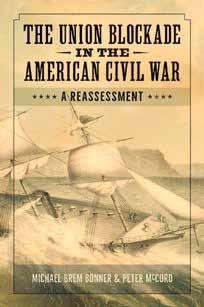

Book Challenges Previous Assumptions


The Union Blockade In The American Civil War: A Reassessment.


 By Michael Brem Bonner and Peter McCord. Bibliography, index, notes, University of Tennessee Press, https://utpress.org, 2021, 217 pp., hardcover. $45.
By Michael Brem Bonner and Peter McCord. Bibliography, index, notes, University of Tennessee Press, https://utpress.org, 2021, 217 pp., hardcover. $45.
Reviewed by Wayne
Wolf
to a halt in those ports.
The Lincoln administration did a commendable job of holding British concerns with the blockade at bay. They walked a delicate diplomatic tightrope to convince European powers that the blockade was effective and that they were thus in compliance with the Declaration of Paris. Simultaneously they accepted the dirty little secret that both sides kept trade channels open for their mutual benefit.
Blockade running was one of the most lucrative enterprises of the Civil War, filling the pockets of not only the blockade runners but commanders, like Matthew Maury and Colin McCrae, crews, shipbuilders, and transfer agents. Thus, while King Cotton Diplomacy failed, the Union blockade did manage to achieve limited success in three distinct areas: the psychological impact on the Southern populace and on those thinking of entering
the lucrative smuggling trade; hampering the arrival of needed supplies that the South could not produce internally thus adding to inflation; and, creating a sense in the South of a daily reminder of the South’s inferior resources.


The authors do an extremely credible job of amassing the data necessary to question previously held historical interpretations, including psycho-historiographic interpretations of blockade running, placing the costweight scholars on the defensive when actual dollar amounts are in question, and shedding doubt on all of the tenets of the contributing-effective historian’s arguments. While many naval historians will never be satisfied with the effect that current data implies, this book at least brings new light to the conclusions of historians with a much-needed impartial viewpoint. For scholars of Civil War maritime history, this volume is a must read. It is packed with raw data, easily readable, and balanced in its conclusions.


Wayne L. Wolf is Professor Emeritus at South Suburban College and past president of the Lincoln-Davis Civil War Roundtable. He is the author of numerous books and articles including The Last Civil War Scout, Heroes and Rogues of the Civil War, and Two Years Before the Paddlewheel.
Buckeyes bled at South Mountain, Antietam
Ohio at Antietam: The Buckeye State’s Sacrifice on America’s Bloodiest Day. By Kevin R. Pawlak and Dan Welch. Photos, notes, index, 158 pp., 2021. The History Press, www. historypress.com. $21.99.

Reviewed by Brian Matthew Jordan

the fierce fighting on South Mountain, just three days before Antietam. Packed into the Kanawha Division, six Ohio infantry regiments forced Fox’s Gap in tense, often hand-to-hand fighting across a low stonewall that rambled through the thickets. Commanding the 23rd Ohio Volunteer Infantry, future president Rutherford B. Hayes was seriously wounded as his troops flanked the tiny Tarheel brigade commanded by Samuel Garland. Hayes recovered from his injuries in nearby Middletown, Maryland.
It has long been accepted historiography that the Union naval blockade of Confederate ports became more effective as the war progressed, crippled the Southern economy, and was a major factor in the Union’s ultimate victory. This book challenges those assumptions with voluminous data from the Official Records, the British admiralty, and anecdotal sources. While the blockade affected Southern morale psychologically, the catand-mouse game of evading the Union blockade actually became more effective as the war entered the 1863–1864 period. The blockade was porous enough to hold the Union capture rate of blockaders to approximately 1 in 6. Combined with internal fiscal mismanagement, contraband only marginally affected the inflation rate in the South. Only when Union forces captured port cities did blockade running come
The American Civil War was the rst war in which both sides widely used entrenchments, repeating ri es, ironclad warships, and telegraphed communications. It was also the rst American War to be extensively photographed. Mathew Brady, Alexander Gardner and Timothy O’Sullivan are famous for having made iconic photographs in the Civil War’s eastern theater. George N. Barnard deserves to be ranked in this top tier for his photographic work in the war’s western theater. A civilian photographer hired by Gen. William T. Sherman’s chief engineer to take pictures of forti cations around Atlanta, Barnard took several hundred of them in and around the city in the fall of 1864. His most famous is the site of Union Maj. Gen. James B. McPherson’s death in the battle of Atlanta, July 22, 1864. Thus far, no comprehensive, de nitive listing has been made of the photographer’s work. For this book we have chosen a hundred images we deem “signi
Between 1861 and 1865, the Buckeye State supplied more than a third of a million soldiers to the Federal war effort. Thirteen Ohio units, ten volunteer infantry regiments, two light artillery batteries, and an unattached cavalry company, saw action on September 17, 1862, the war’s bloodiest day. Veteran authors Kevin R. Pawlak and Dan Welch ably chronicle the participation of these men, and their efforts to memorialize their Antietam sacrifices decades later, with this slender, accessible, and wellillustrated volume. This title is the most recent addition to The History Press’s growing catalog of books that approach the Civil War from local angles.
Mining Ohio newspapers, regimental histories, and the files of the Antietam National Battlefield Library, the authors recovered the voices of ordinary enlisted men who engaged in combat atop the spine of South Mountain, the fingers of the West Woods, along the Sunken Road, and on the Federal left. Pawlak and Welch wring human color from the sources, spicing their narrative with evocative quotes and telling anecdotes. At many points throughout the text, they permit the men themselves to recount the experience in arms and under fire.
The first chapter recalls
The second chapter narrates the battle as waged by the trio of Buckeye regiments in Colonel Hector Tyndale’s XII Corps brigade. After an initial exchange of musketry the morning of September 17, the Fifth, Seventh, and Sixty-Sixth Ohio regiments drove to the high ground around the Dunker Church. From that knob, they pitched into the West Woods and bagged many enemy prisoners.
The Eighth Ohio was the lone Buckeye regiment in the Army of the Potomac’s II Corps at Antietam. Summoned to support a Federal battery in the twilight artillery duel that roared to life on September 16, the regiment suffered few casualties. Yet it managed to find the thick of the killing the next morning, when it advanced on the Sunken Road, a natural farm lane eroded into the earth near the Confederate center. Thomas Gawley, an Irish sergeant and clever wordsmith who left a justly famous account of his regiment, noted that men fell from the ranks “by the hundreds.”
Though physically exhausted from the previous Sunday’s fight at Fox’s Gap, not to mention emotionally depleted by their macabre assignment to South Mountain’s burial detail, the IX Corps troops in Colonel Hugh Ewing’s brigade soldiered on south of Sharpsburg. Flanked by the Confederates, they suffered losses exceeding ten percent of their effective strength. In the space of an hour, the Thirtieth Ohio lost two color bearers. Admirably, the authors extend their narrative beyond the battle. A brief chapter considers how Ohioans experienced the immediate aftermath of combat. They chronicle the search for
40 CivilWarNews.com January 2022 40 January 2022 CivilWarNews.com
“The best little book on Barnard”
128 page Paperb ac k: $19.95 (+$3.50 S & H) Ordering info: $19.95 plus $3.50 s&h South Carolina residents add 9% sales tax Mail a check to: Historical Publications LLC 520 Folly Road, Suite 25 PMB 379 Charleston, SC 29412 or Order online at www.historicalpubs.com Wrecking Atlanta series of the 1880s. When the men the 1st Missouri Engineers (oneofPoe’s thecaption,“theFirstMissouriEngineersdestroyingarailroadshowingtheuseofhooks for Monday, November Freedpeople on the Boxcars thesharpskirmishinginfrontofit.Federaltroops,however,neverassaultedtheConfederate Peachtree Battery–Another View Subscribe online at CivilWarNews.com
cant.”
wounded, the impulse to collect souvenirs, and the first, desperate attempts to coax chaotic scenes into orderly prose. Pawlak and Welch likewise survey the work of the Ohio Antietam Battlefield Commission, which dedicated monuments on the field at the turn of the century. An appendix considers the storied service of commissary sergeant, and later U.S. president, William McKinley. Finally, the authors supply their readers with a handy reference list of Ohio burials in the Antietam National Cemetery. Though not great in number, “Ohio’s soldiers,” Pawlak and Welch conclude, “played a key role in preserving the Union with their actions at South Mountain and Antietam.” This book celebrates that service while also revealing the war’s horrors. The story of Ohio at Antietam was
one of pride and pain, heroism, and heartbreak.

Ohio at Antietam is a narrative history rather than an argumentdriven monograph. As such, the authors do not attempt to fit their work into larger interpretive frameworks; nor do they spend much time building larger contexts. Readers with a working knowledge of the battle of Antietam, however, will welcome this compact, well-written survey of one state’s sacrifices on the war’s bloodiest day.

Brian Matthew Jordan is Associate Professor of Civil War History and Chair of the Department of History at Sam Houston State University. A Pulitzer Prize finalist, he is the author of A Thousand May Fall: Life, Death, and Survival in the Union Army (2021).
A Powerful, Collective Biography
The Bonds of War: A Story of Immigrants and Esprit De Corps in Company C, 96th Illinois Infantry. By Diana L. Dretske. Photos, notes, index, 256 pp., 2021. Southern Illinois University Press, www.siupress. com. $26.50

Reviewed by Jonathan A. Noyalas

1841-1854 and ultimately settled in Lake County, the state’s most northeastern county. Murray immigrated from Ireland, Madden and Lewin from England, Murrie and Taylor from Scotland. Although these five men did not enlist at the war’s outset, they responded to President Abraham Lincoln’s summer of 1862 call for 300,000 volunteers.
The five men served in the 96th Illinois Infantry and the author does an impeccable job of highlighting the regiment’s experiences during the conflict, including performing various labor tasks during the first year of their enlistment and the 96th’s combat experiences in Tennessee and Georgia. This is not, nor was it ever intended to be, a regimental history. Dretske’s superb study is an intimate history experienced by five immigrants who fought for their adopted home.
a result of wounds he received at Chickamauga.
Dretske’s history offers much more than a microcosm of how the conflict impacted these five men, but also analyzes how the war affected loved ones and neighbors left behind. In addition to discussing the roles civilians at home played in lending support to the Soldiers Aid Society or similar organizations, this outstanding study reveals how those on the home front, such as Nancy Murray, John Taylor’s fiancée, too became a battle casualty.
At the conclusion of Virginia’s commemoration of the Civil War Sesquicentennial, Dr. James I. Robertson, Jr. composed a volume as part of the Commonwealth’s Sesquicentennial Commission series. In the preface to Civil War Echoes, Robertson wrote something that he always stressed during my time as his graduate student at Virginia Tech, “history is the story of human beings.” The investigation of individual stories, Robertson wrote, “should be the primary, most exciting avenue in the quest for knowledge” among students of history. Those who share his perspective that history at its core is about individuals will find Diana Dretske’s study engaging, thought-provoking, and powerful.
Dretske, a curator and historian at the Bess Bower Dunn Museum of Lake County, Ill., has employed micro-history to its finest to tell the stories of five soldiers who served in Company C, 96th Illinois Infantry. Initially inspired by a photograph in the museum’s collections of these five men, only one of whom initially, Edward Murray, was identified, Dretske’s investigation into the remaining four not only revealed their names, Loughlin Madden, James Murrie, William Lewin, and John Taylor, but resurrected “their connection as neighbors and immigrants.”
Murray, Madden, Murrie, Lewin, and Taylor immigrated to the United States between
Throughout this study Dretske masterfully uses the lives of these five soldiers to explore what motivated immigrants to fight and explore what they thought about slavery. Additionally, Dretske utilizes the experiences of each soldier to illuminate how soldiers confronted and coped with war’s tragic consequences. While keenly aware of “the risk [of] heading off to war” the author contends that the battlefield’s destructive reality did not hit home for these men until John Taylor, wounded at Chickamauga, died on November 24, 1863.
By examining the lives of these five soldiers, three of whom survived the war; Taylor died in 1863 and Madden died at Andersonville in 1864, Dretske highlights the reality that, although the shooting ceased in the spring of 1865, veterans coped with the war’s physical and emotional legacies until death. For instance, Dretske’s examination of the postwar life of Lewin, who died in 1914, reveals that he suffered for the rest of his life from frequent “dull heavy pains in his head” as
While marvelous studies, including those penned by such talented historians as Brian Matthew Jordan, James McPherson, and Peter Carmichael, offer insight into the myriad ways the conflict impacted soldiers, it is a rare thing to have a volume that traces, in such magnificent detail, the lives of the rank and file from the years prior to the conflict, their military service, and postwar existence. This outstanding volume, carefully researched and cogently argued, is essential to anyone interested in the Civil War’s longterm impact on the rank and file and their families.
Jonathan A. Noyalas is director of Shenandoah University’s McCormick Civil War Institute in Winchester, Va., a professor in Civil War Era Studies at Shenandoah University, and founding editor of Journal of the Shenandoah Valley During the Civil War Era. He is the author or editor of fourteen books. Noyalas’ latest book, Slavery and Freedom in the Shenandoah Valley during the Civil War Era, was published by the University Press of Florida.
41 January 2022 41 January 2022 CivilWarNews.com CivilWarNews.com Subscribe online at CivilWarNews.com Deadlines for Advertising or Editorial Submissions is the 20th of each month. Email to ads@civilwarnews.com
Legion of the Confederacy CSA National Defense Medals & other banned internet items Civil War Recreations WWW.CWMEDALS.COM cwmedals@yahoo.com 1 Smithbridge Rd., Unit 61, Chester Heights, PA 19017
Loyal
Scholarly Essays that Intrigue the Reader
Southern Strategies: Why the Confederacy Failed. By
 Christian B. Keller, ed. U. Press of Kansas, https://kansaspress. ku.edu, 2021. Maps, illus., end notes, index. Hardcover, 296 pp. $34.95.
Reviewed by Ted Savas
Christian B. Keller, ed. U. Press of Kansas, https://kansaspress. ku.edu, 2021. Maps, illus., end notes, index. Hardcover, 296 pp. $34.95.
Reviewed by Ted Savas
campaigns, Jackson’s 1862 Valley Campaign, the 1862 Maryland Campaign, and 1863 Gettysburg Campaign. Two examine various flaws in Confederate financial and diplomatic policy, while the final essay studies how the Davis War Department mishandled the Trans-Mississippi Theater. The contributors adopted a unified process that identifies and analyzes political and strategiclevel mistakes that seriously diminished the prospects of a Southern victory, and by doing so forced army commanders to overcompensate in what they tried to do on the battlefield.
the Fate of the Confederacy
Keller examines two main issues affecting DIME: The timing of the Lee-Jackson partnership and Stonewall’s untimely death, and the strategic implications of transferring Jackson from the Valley to Richmond to confront McClellan in what would be known as the Seven Days’ Battles. The exploration of the latter implications offers an especially interesting set of “what if” circumstances.
but McCall tosses enough spice into the mix to give readers their money’s worth.
This is an interesting book. Much has been written about why the South lost the war, in book and article form, but the six essays in Southern Strategies claim to be the first to analyze Confederate defeat through “the lenses of classical strategic and leadership theory.”
Each contributor brings a level of gravitas to his subject matter not always present in essay collections. Editor Christian B. Keller is a professor of history and the director of the Military History Program at the U.S. Army War College. His other five contributors are retired or active-duty Army officers with a wealth of high-level military and teaching experience.
Three essays focus on specific
These lost advantages, they argue, could and should have been accomplished using diplomatic, economic, and informational (intelligence) strengths at the national level. Military power tossed into the mix coins the acronym DIME (no pun intended), an interesting and potentially useful technique to evaluate how a nation state like the Confederacy or the United States, then or now, managed its influence and power at the strategic level. The essays begin with the assumption that the South, at least in theory, possessed sufficient diplomatic, informational, military, and economic power to win its independence. I have my doubts as to the truth of that assumption, but clearly this is something unknowable.
Keller kicks off the collection with “Robert E. Lee, Stonewall Jackson, and Strategic Contingencies in the 1862 Valley Campaign,” which borrows from and builds upon his 2019 book The Great Partnership: Robert E. Lee, Stonewall Jackson, and
Career Army field artillery officer Eric Johnson, in his “Confederate Economic and Fiscal Policies: Root Causes of Defeat,” argues that actions taken in the economic sphere hamstrung the Confederacy’s ability to win against the United States which, to the surprise of no one, was superior in every aspect of DIME. This road seems well traveled, and Johnson admits to borrowing the insights of others in this regard. The distinction in his essay, he argues, is that few previous writers have linked the strategic weakness of the Confederacy to its failure to integrate its economic and military options.
Next up is “Lee’s Blind Horse: Confederate Intelligence Operations in the 1862 Maryland Campaign,” by Kevin E. McCall, a retired Army officer and former professor at the U.S. Army War College. As suggested by the title, McCall examines a host of issues including a discussion about Lee’s Special Orders 191 I have yet to see raised elsewhere. I did not find it convincing, but I did find it intriguing. Alex Rossino is arguably the leading expert today on the lost orders, the subject of his recent A Tale Untwisted,
Chickamauga Civil War Show

MK Shows presents the Annual Chickamauga Civil War Show and Sale at the Dalton Convention Center, 2211 Dug Gap Battle Road, Dalton, GA 30720. This Civil War show features 500 tables of antique weapons, artifacts and memorabilia from top dealers and collectors around the country. The show encompassing all eras of military history from the Revolutionary War through World War II. Hours are 9-5 on Sat., 9-3 on Sun., parking is free and admission is only $10/adults and children under 12 are free.
Retired U.S. Army infantry officer Erik Anderson, who taught at West Point and is currently an instructor at the War College, penned “For Want of Friends: The Failure of Confederate Diplomacy.” The issues here have been covered elsewhere, the failure of the “King Cotton” strategy, inept and occasionally imbecilic emissaries, and Union diplomatic pushback, among others. Anderson’s nail in the Confederate coffin lid is a deeper dive into the often-overlooked national interests of France and England, which did not coincide with the Confederacy’s. This international failure, of course, threw sand in the South’s already rusty gears comprising DIME.
The penultimate contribution, “Going North in 1863: Balancing Boldness and Risk in the Pursuit of Strategic Imperatives,” by Chris Compton, may be the most interesting to general readers of Civil War history. The career field artillery officer and recent graduate of the U.S. Army War College utilizes a strategy analysis tool taught at his alma mater, too complex to fully make sense in a brief review, to evaluate Lee’s decision to move north. Unlike many writers Compton concludes the plan was conceptually sound, but its execution at the operational and tactical levels was deeply flawed.
The final entry takes us out west to the Civil War’s red-headed stepchild theater. “The Forgotten Trans-Mississippi Theater and Confederate Strategy,” by Michael J. Forsyth will also be of interest to military enthusiasts. The retired field artillery office and current assistant professor at the U.S Army Command and General Staff College in Leavenworth, Kansas, has little good to say about how
the Confederacy managed the sprawling region. After examining everything from theater neglect, poor leadership, and the implementation of weak overall strategies, Forsyth concludes the Davis administration never fully grasped the region’s potential, and that Davis’ failure to implement DIME heavily influenced other aspects of the national war. There is nothing to quibble with here.
The editor makes it clear at the outset that this book builds on earlier studies like David Donald’s Why the North Won the Civil War (1960) and Gabor Borritt’s Why the Confederacy Lost (1992). In fact, it nests comfortably with those important works and adds additional facets of analysis.
Keller’s Southern Strategies is original, crisply written, and uniquely, and in many cases, persuasively, argued. One can disagree with the arguments and conclusions within these pages, but so what? That is the point of scholarly essays. They should make you think and reevaluate what you think you already know.
Theodore P. Savas (Managing Director) graduated from The University of Iowa College of Law in 1986 (With Distinction). He practiced law in Silicon Valley for many years and taught business and history classes at the college level for about 20 years.
In 1990, he co-founded (with David Woodbury) the historical press Savas Woodbury Publishers (later Savas Publishing). The company was sold to an East coast publisher in 2001. Ted and the late Russel H. Beatie together founded Savas Beatie in January 2004. Savas is the author or editor of fourteen books as well as scores of articles in a variety of journals, magazines, and newspapers.
42 CivilWarNews.com January 2022 42 January 2022 CivilWarNews.com
Mike Kent and Associates, LLC • PO Box 685 • Monroe, GA 30655 (770) 630-7296 • Mike@MKShows.com • www.MKShows.com
Publishers/Authors Send your book(s) for review to: Civil War News 520 Folly Road, Suite 25 PMB 379 Charleston, SC 29412 bookreviews@civilwarnews.com
Insights Into the Thoughts of a Forgotten Union Officer
Worthy of a Higher Rank –The 1864 Shenandoah Valley Campaign Journal of Colonel Joseph Thorburn, Commander First Infantry Division, Army of West Virginia. Edited by Scott C. Patchan. 2021, 35th Star Publishing, www.35thstar.com, 163 pp., $17.95.
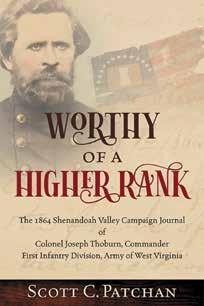
Reviewed by Charles H. Bogart
No Golden Gloves Fight
Colonel Joseph Thorburn was born in Ireland in 1825. Shortly after his birth, his family immigrated to the United States. After a number of moves, the family eventually settled in Ohio. Here, Thorburn became a school teacher and later a doctor. In 1853, he relocated his family to Wheeling, Virginia, now West Virginia. In May 1861, one month after the attack on Fort Sumter, Thorburn joined the 1st Virginia Infantry USA, a threemonth regiment, as it’s surgeon. The regiment saw action at the June 3, 1861, Battle of Philippi, a Union victory. During this battle, Thorburn entered into the thick of battle bearing arms and took command of soldiers around him. During the fighting, Colonel Benjamin F. Kelley, the regiment’s commander, was wounded.
In August 1861, with its three-month enlistment up, the 1st Virginia Infantry USA was mustered out of service. The 1st Virginia Volunteer Infantry USA was then reorganized as a threeyear regiment and its ranks filled with former members of the threemonth regiment. Colonel Kelley at this time was still hospitalized, thus the men of the new regiment elected Joseph Thorburn as their colonel. In 1863, upon the admittance of West Virginia into the United States as a newly formed state, the 1st Virginia Volunteer Infantry USA became
the 1st West Virginia Volunteer Infantry USA. The 1st West Virginia Volunteer Infantry USA took part in various engagements and battles along the West Virginia-Virginia border and in the Shenandoah Valley during 1862 and 1863. The regiment suffered numerous casualties during the 1862 Shenandoah Valley Campaign, which saw the regiment forced to retreat into its home state. In the spring of 1864, following a reorganization of Union forces, Colonel Thorburn took command of the 2nd Brigade, First Division in General Franz Sigel’s Army of West Virginia. A month after the May 15, 1864, defeat of General Sigel at the Battle of New Market, Colonel Thorburn was given command of the Army of West Virginia’s First Infantry Division. At this same time, General Sigel was relieved of command of the Army of West Virginia by General George Crook. Confusingly, during General Philip Sheridan’s Army of the Shenandoah 1864 Valley Campaign, General Crook’s Army of West Virginia is often referred to as VIII Corps.
On October 19, 1864, Colonel Thorburn’s First Division were among the troops caught up in the Battle of Cedar Creek. During this fighting, while leading his men, Colonel Thorburn was mortally wounded during confused fighting in Middletown, Va., and died on the battlefield. Colonel Thorburn’s remains were taken back to Wheeling, West Virginia, where he was laid to rest in the Mt. Wood Cemetery. James E. Taylor, within his sketchbook, has a drawing of the killing of Colonel Thoburn.
Major General George Crook, commanding officer Army of West Virginia, wrote after the battle, “I am pained to report the death of Col. Joseph Thoburn, commanding First Division, and Capt. Philip G. Bier, assistant adjutant-general on my staff. Both fell mortally wounded while rallying the men. Brave, efficient, and ever conspicuous for their gallantry on the field of battle, in them the country sustained a loss not easily repaired.”
The book under review contains diary entries, letters, and reports written by Colonel Thoburn during 1864. The first diary entry is for May 4, 1864, and the last entry was written on August 7, 1864. The letters consist of three the colonel sent home to his wife in August 1864, while the reports consist of two, one submitted in
September and one in October 1864. These diary entries, letters, and reports all provide a keen insight into Colonel Thoburn’s relationship with his family and his observations on the events happening around him. Overall, the letters, diary, and official reports provide an objective look at the U.S. Army in the Shenandoah Valley area during 1864.
The title of the book is based on a portion of a letter Colonel Thoburn wrote on October 4, 1864. “Genl. Crook and Sheridan have I understand portioned for my promotion, but I do not expect anything from it. — Genl. Cooke still retains me in command of a division while quite a number of Brigadiers are here commanding brigades.”
There are three appendixes. The first has reprints of letters containing information on the 1st Virginia Infantry USA during the 1862 Shenandoah Valley Campaign; the second appendix has Colonel Thoburn’s report on the Battle of Piedmont; and the third appendix has eye witness accounts of the death of Colonel Thoburn.
The book is an interesting read that provides insights into the thoughts of a forgotten Union division level officer who is concerned that the war is changing into a hard war and that certain individuals are not qualified for the tasks their position entails. He encounters African Americans in Confederate service, but these are slaves digging entrenchments. It is interesting to speculate if Colonel Thoburn would have received a promotion to Brigadier General or have been awarded a Brevet Brigadier General rank if he had survived to the end of the war. The book is nicely illustrated and contains numerous footnotes. More maps would have helped tell the story. However, if West Virginia Civil War history is of any interest, then by all means purchase this book, as you will gain some greater insight into this conflict.
Charles H. Bogart has a BA from Thomas More University and an MCP from Ohio State University. He is employed as a tour guide at the Fort Boone Civil War Battle Site in Frankfort, Ky., serves as President of the Frankfort Civil War Roundtable, and is a board member of the Kentucky Civil War Roundtable. He has written several books and articles on military and naval history.
Grant’s Left Hook: The Bermuda Hundred Campaign, May 5 - June 7, 1864. By Sean Michael Chick, Photographs, campaign maps and appendices.

171 pp. Savas Beatie (Emerging Civil War Series. www. savasbeatie.com. 2021. $14.95
Reviewed by Richard J. Blumberg
On a brighter note, Mr. Chick’s treatment of the command relationship between Confederate generals Lee and Beauregard is interesting and well written. Unfortunately, there is no comparison between Union generals Grant and Butler. Including this information would help readers understand how command relations and leadership styles impacted campaign outcomes. Although the order of battle is helpful, most readers probably prefer to see the sources used, or receive a more indepth analysis of the campaign. Appendix B offers an interesting story regarding Jefferson Davis’ slave who had an encounter with General Butler after the war. However, this appendix doesn’t directly relate to the Bermuda Hundred campaign.
This is the thirty-ninth book in the Savas Beatie series. The goal of these works is to “offer compelling, easy to read overviews of some of the Civil War’s most important battles and stories.” This reviewer has reviewed several other works in the series and finds the omission of a bibliography and footnotes to be the major drawback. Readers must go online to get this information. In the case of Chick’s work, nothing is loaded to the site, even after the author’s request on May 2021.
In boxing, a left hook is a difficult punch to execute. However, when delivered correctly, it is very powerful.
Mr. Chick’s most recent work is much the same. He scores several misses, some glancing blows, and a few direct hits.
One of the biggest misses is the editing. There are no citations alerting readers where footnotes might be. In the photo credits on page viii, it appears Scott Williams is abbreviated as “(sc)”, yet all other references in the book refer to him as “(sw)”, consistent with the other abbreviations used. Another shortcoming is the lack of analysis. Many tactical and logistical details are missing. This omission prevents readers from fully understanding the consequences of how Union commanders’ missteps impacted Grant’s 1864 three-pronged plan of attack. The lack of analysis is compounded, because each chapter reads like a list of events for a particular set of dates in the campaign.
In spite of the misses and glancing blows, Mr. Chick’s experience as a New Orleans tour guide, helps make his driving tour an excellent resource and a highlight of this work. His research is sound and factually correct. His numerous photographs and maps help the reader understand the various battles of this campaign.
Mr. Chick’s book is an interesting work that offers a good overview of the campaign. The final chapter does a good job explaining the campaign’s purpose but leaves other chapters somewhat disconnected. Editing issues, little in-depth analysis, and limitations presumably imposed by the series editor prevent this from being the great work it could be.
Richard Blumberg has reviewed books for Civil War News for over twenty years. Three of his articles have been published in various issues of Civil War News.
43 January 2022 43 January 2022 CivilWarNews.com CivilWarNews.com
and past digital Issues of CWN are available by subscription alone or with print plus CWN archives at CivilWarNews.com
Current
MILITARY ANTIQUE MAGAZINE


Coming Soon! A brand new full-color 80-page, glossy magazine for the Military Antique Collector. The publication will spotlight rare and unusual military objects, beautiful craftsmanship works, and historical figures dating from early American and European history to limited coverage of the post-1898 artifact. This magazine will not be focused on relic hunting or artifact digging. The sample layout below is only one of the page formats.

Stay tuned for a launch date. Email: mail@militaryantiquecollector.com to signup for the email blast and post notifications.

This seated Union enlisted infantryman in frock coat and forage cap is holding a U.S. Model 1861 .58 caliber rifle musket with sling. His percussion cap box and bayonet in scabbard are on his waistbelt with US plate. His cartridge box is slung from his left shoulder by its belt with an eagle breast plate. He is wearing the accoutrements on this page. For some reason, he has the rifle “backward,” in terms of his cartridge and cap boxes. Liljenquist Family Collection of Civil War Photographs (Library of Congress).

U.S. Pattern 1861 cartridge box (above), and with sling (right). On the front of the leather flap is a US stamped brass cartridge box plate with the back filled with lead. The circular device on the sling is a US Eagle breast plate. These made shinny targets for the Confederates to take aim. Cartridge boxes like these held 40 rounds of ammunition of .58 caliber Minié ball cartridges.


U.S. .58 caliber Minié ball and paper cartridge that contains the .58 caliber lead bullet and black powder.

CivilWarNews.com January 2022 44 January 2022 CivilWarNews.com
April 30 – May 1, Ohio. Civil War Show
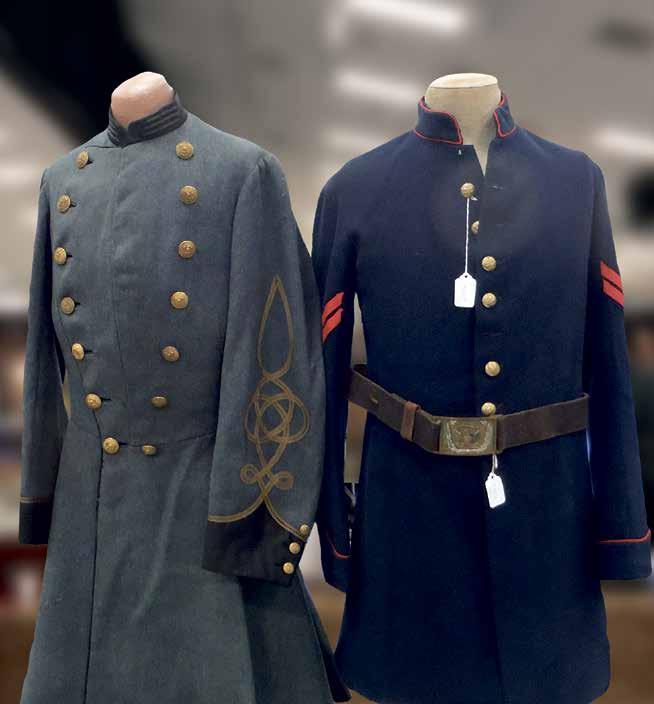
and Sale
The Ohio Civil War & WWI/II Show will be held in Mansfield, OH. This Mansfield military collectors show is held at Richland County Fairgrounds. All federal, state and local firearm ordinances and laws must be obeyed. Civil War and WWI & II Memorabilia for buy, well & trade. Featuring a unique artillery show with 15 cannon on display with firing demonstrations. Added Special Features: Civil War & WWII encampments, Sutlers Row, field hospital scenario, period music, Gettysburg Address by President Lincoln, Marlboro Volunteers Traveling Museum and Military Vehicle. Hours are 9 a.m. - 5 p.m. on Sat., 9 a.m. - 3 p.m. on Sun. Parking is free. For information; contact Wayne Williams: 419-884-2194 or t.drushel@zoominternet.net. http://www.ohiocivilwarshow.com.
Jan. 4-11, Virginia, Online Seminar

Please join Prof. Jonathan A. Noyalas, director of Shenandoah University’s McCormick Civil War Institute, for a three-part online seminar via Zoom examining various aspects of the Civil War Era in the Shenandoah Valley.
January 4, “Kindred Will all be Divided”: The Eastern Panhandle on the Eve of Civil War; January 6, “An Expression of Helplessness”: Sigel, Hunter, and the Lower Valley’s Civilians in May 1864; and January 11, “That this War May Soon Come to an End”: Perspectives on the Meaning of Union Victory in the Shenandoah Valley, Autumn 1864.” All sessions begin at 7 p.m. EST. Although FREE (donations appreciated), registration is required. Email jnoyalas01@su.edu to register.
Jan. 15-16. South Carolina. Civil War Show
Low Country Civil War Show & Sale at Omar Shrine Temple, Mount Pleasant, Sat. 9-5, Sun. 9-3. Sponsored by American Digger Magazine. For information, 770-362-8671, 716-574-0465, americandiggerevents.com.
Jan. 29-30, Georgia. Civil War Show
MK Shows presents the Chickamauga (Dalton) Civil War Show at the Northwest Georgia Trade & Convention Center, Dalton, Ga., for collectors and history enthusiasts. Over 400 sale and display tables. Adults $10, Children under 12 are free. Open Sat. 9-5 and Sunday, 9-3. Friday VIP admission available for early admission. For information; www.MKShows.com, email Mike Kent at mike@mkshows.com.
Feb. 18-20, Florida. Reenactment
Olustee Battlefield Historic State Park will host the weekend long 45th Annual Reenactment commemorating the 158th anniversary of the Battle of Olustee. More than 1,500 living historians will give presentations of both civilian and military life during the Civil War. Events will include educational exhibits and speakers, battle reenactment, a skirmish, medical demonstrations, ladies’ tea, sutlers, artillery night firing, an old-fashioned barn dance! Spectators can visit authentic campsites, view artillery inspections, living history programs, listen to a period music and watch the battle reenactment. Festivities will end with the Battle of Olustee Ball at the Ball Tent. Period attire re-quired. Ball is for participants only. For information; 877-635-3655; battleofolustee.org.
March 19-20, Maryland. Antiques Arms Show and Sale

Sponsored by the Maryland Arms Collectors Association. With over 1,000 tables of the finest in collectible rifles, revolvers (pre-1898) and sporting shot guns, this show attracts thousands of serious collectors from across the globe. Open to the public on Sat. from 9-5, and Sun. from 9-3. Admission is $10. Located at the Maryland State Fairgrounds Cow Palace, 2200 York Road, Timonium, MD 21093. For information visit www.baltimoreshow.com.
Before making plans to attend any event contact the event host. January
March 31 - Apr. 3, Georgia. The Georgia Battlefields Association Annual 2022 Tour
The GBA Annual 2022 Tour is scheduled for March 31st through April 3rd. The tour is based at the Springhill Suites at 4630 Sheraton Drive in Macon, Ga. The $119 per night room rate includes breakfast and tax. Please call The Springhill Suites at 478-803-9100 for room reservations at The GBA Rate. The 2-1/2 day tour will include two dinners, two lunches, maps, and bus transportation. The tour will cover the opening weeks of the March to the Sea, some additional events of the July 1864 Stoneman Raid, Macon defenses, and events relating to the capture of Jefferson Davis. Please mail a check payable to Georgia Battlefields Association for $430 per attendee to P.O. Box 669953, Marietta, GA 30066, or pay online www.georgiabattlefields.org.
April 2, Virginia. Seminar
Shenandoah University’s McCormick Civil War Institute’s annual spring conference on the cam-pus of Shenandoah University, Winchester, Virginia, “Beyond the Mere Routine of Everyday Life”: Encounters & Experiences during the Civil War. Presentations with Jonathan A. Noyalas (Shenandoah University), Lauren K. Thompson (McKendree University), Kathryn J. Shively (Virginia Commonwealth University), and Jonathan W. White (Christopher Newport University). $30 registration fee covers all presentations and lunch at SU. Space is limited, visit www.su.edu/mcwi to register. For information; jnoyalas01@su.edu or phone 540-665-4501.
May 20-22,
Georgia. Reenactment and Living History
The Battle of Resaca Reenactment will be held on over 600 acres of the original battlefield in Resaca, Georgia. This reenactor-friendly event will have main camps located near the original US and CS lines. Campaigners are welcome to camp in or near the breastworks. Amenities include straw, hay and firewood. Modern food and ice vendors on site. Weekend activities will include aggressive battles both days at 2 p.m. – rain or shine, combined US & CS morning colors, period demonstrations, cavalry competition, a civilian refugee camp, reenactor yard sale, sutlers, period music and dance, period church services, and a memorial service at the Confederate Cemetery. Many Civil War historical sites are located on the reenactment site and two major Civil War parks are within minutes of the site. Handicapped parking available with free transport from parking areas to battlefield, vendor and sutler areas. Reenactor pre-registration is $10 if received by April 15th. Artillery bounties of $150 for the first 18 cannons with crew pre-registered by April 15, 2022. A portion of the proceeds to be donated to preservation efforts of the Friends of Resaca Battlefield. For more information; www.georgiadivision.org
May 12-15, Tennessee. 21st Annual Congress: General Barton Stovall History/Heritage Association
The 21st Annual Congress of the General Barton Stovall History/Heritage Association is tentatively set to be held in Nashville. Since 2001, our association has held 19 Congresses across the Southeast. Each Congress is held in a different location near where our soldiers once fought and bivouacked. There are three nights of activities and two days of tours. We often use local guides to educate our members and show us the exact locations of where our soldiers stood and fought. The first night has a welcome reception and silent auction. Our second night is called Historian Night, and it is an open forum where members make 15-minute or less presentations about people, places and things related to our brigade. The third night is a full banquet with a guest speaker. Watch for updates on our 2022 event at: www.generalbartonandstovall.com.
Dec. 3-4, Tennessee. Civil War Show and Sale
MK Shows presents the 34th annual Middle Tennessee Civil War Show and Sale at the Williamson County Ag Expo Park, 4215 Long Lane in Franklin. The nation’s largest Civil War show, featuring 750 tables of antique weapons, artifacts and memorabilia from top dealers and collectors around the country and encompassing all eras of military history from the Revolutionary War through World War II. Appraisers are always on hand to help you identify and value your military collectibles at no cost. Hours are 9-5 on Sat., 9-3 on Sun. Free Parking. Admission is only $10/ adults and children under 12 are free. For information; www.MKShows.com or Mike@MKShows.com.
July 23-24, 2022
Arena 323 Camp Jordan Pkwy. East Ridge, TN
American Digger® magazine now has TWO great shows each year! For
45 January 2022 45 January 2022 CivilWarNews.com CivilWarNews.com
Shrine Temple 176 Patriots Point Rd. Mt Pleasant, SC LOWCOUNTRY ANTIQUE MILITARIA & AMERICANA SHOW Note date change!
Jordan
15-16, 2022* Omar
Camp
CHATTANOOGA ANTIQUE MILITARIA & AMERICANA
SHOW
Call (770)
(716)
Email: anita@
Both shows Open to Public: Saturday: 9-5 Sunday: 9-3 Dealer Setup: Friday 1-7 PM Sat 7-9 AM americandigger.com/american-digger-events/ • Swords & Knives • Antique Firearms • Dug & Non-dug Relics • Civilian Items & Jewelry • Bottles & Stone Artifacts • Art, Photos, & Books • Militaria & Americana • All Eras to WWII • Metal Detectors • Awards & Prizes this and more: Display!Trade! Buy!Sell! *Temporary date change to avoid New Years Eve conflict.
information:
362-8671 or
574-0465
americandigger.com

























































































































































































46 CivilWarNews.com January 2022 46 January 2022 CivilWarNews.com ACE Pyro & Fire Art – Black Powder ACE Pyro Saline, MI 48176 Phone: 877-223-3552 Website: http://www.acepyro.com Fire Art Clearfield, PA 16830 Phone: 814-765-5918 Website: http://www.fireartcorp.com Master Distributors of Schuetzen/Wano Black Powder 1FA, 2FA, 3FA, 4FA and Meal-D. B. M. Green Civil War Paper Memorabilia, Inc. B. M. Green PO Box 1816 Kernersville, NC 27285 Phone: 336-993-5100 Email: bmgcivilwar@triad.rr.com Website: http://shop.bmgcivilwar.net Confederate & Union autographs, letters, documents, diaries, Confederate currency, Confederate postal history, UCV & GAR encampment & first day covers. Our long time experience as dealers and collectors of Civil War material assures you a service second to none. Bowling Green Drummer Herman Kinder 14 Clayridge Court Bowling Green, KY 42103 Phone: 270-842-8058 or 270-779-3104 Email: cwbgdlr@twc.com Website: http://www.bowlinggreendrummer.com Bowling Green Drummer buys, sells & trades on quality, original Civil War, Indian Wars, Old West, WWI & WWII artifacts & militaria. This site has quality Civil War & other era militaria including WWI & WWII items. Regular high quality Union & Confederate artifacts are listed as well as items that are not normally seen on most Civil War websites. David S. LaSlavic 530 E. McDowell Rd. Suite 107-160 Phoenix, AZ 85004 Phone: 602-245-4721 Email: DAVEL@azswords.com Website: http://azswords.com Dedicated to Civil War Edge Weapons! Swords – Sabers – D-Guards – Bowies – Muskets – Rifles – Pistols – Revolvers Best time to call: 9AM – 7PM – Arizona time. ARIZONA SWORDS Mid West Civil War Relics Museum Quality Civil War Union & Confederate Artifacts! We handle the Best Antique Bowie Knifes, Civil War Swords, Confederate D-guards, Antique Firearms, Dug Relics, Buckles & Belts, Identified Relics, Letters, Documents, Images, Currency, Uniforms, Head Gear & Flags. 3500 Shacklett Rd • Murfreesboro, TN 37129 tom@stonesrivertrading.com (615) 336-2188 StonesRiverTrading.com Tom Hays Proprietor We carry all types of relics, dug & non-dug, Confederate & Federal. 100% Guaranteed. A strong emphasis on dug relics, but also a full line of non-dug relics of all types. Over 30 years experience with a full time, online store since 1997. We also have a shop located five miles from Battlefield that is open by appointment. The Maryland Arms Collectors Assoc., Inc. presents The “Original Baltimore” Antique Arms Show Since 1955 Maryland State Fairgrounds Timonium, MD North of Baltimore, York Road, MD. - Rt. 45 1,000 8-Foot Tables March 20-21, 2021 Public Hours: Sat. 9 to 5, Sun. 9 to 3. Admission: $10.00 – Modern Handguns are Prohibited –Complete information on web site: www.baltimoreshow.com Or Call 443-497-9253 Known as the “CROWN JEWEL” of Collector’s Shows! BrentsAntiques.com Specializing in Civil War and World War II Militaria Cell: 336-580-3330 • Email: Bsmith1181@aol.com Website updated Daily! Civil War Buttons William Leigh PO Box 145 Hamilton, VA 20159 Phone: 703-777-8549 Email: wmleigh@msn.com Website: http://www.civilwarbuttons.com Collector & Purveyor of American Military Buttons. Our business is founded on the fundamental principle that our customers are our most important resource. Buy with confidence and be assured that the items you order are authentic & accurately represented. Also, interested in purchasing all types of buttons, uniforms, other historical & military items that you may have to offer. Steve & Melody Strickland PO Box 17 Cumming, GA 30028 Phone: 770-633-5034 Email: 66thgeorgia@bellsouth.net Website: http://www.dixierelicsonline.com eBay ID: Dixierelics Civil War Firearms, Edged Weapons including excavated and non-excavated relics. Our specialty is American Civil War but we do deal in World War and World War II militaria. Burnt Hickory Relics David Baity & Jeff Cash Dallas, GA (Atlanta area) David’s Phone: 770-871-8753 Email: csa1864dab@comcast.net Jeff’s Phone: 678-471-4014 Email: RelicDealer67@gmail.com Looking to buy one piece or entire Civil War collections. Buy, sell and trade. Specializing in quality dug relics such as artillery, bullets, cartridges, Confederate and Union belt buckles, plates and buttons. Will travel to buy collections. J h J H y Q G t b g PA j yHayes Otoupalik Militaria PO Box 8423 Missoula, MT 59808 Phone: 406-549-4817 Email: hayesotoupalik@aol.com Website: http://www.hayesotoupalik.com We have been collecting and dealing in American Militaria from 1830 to 1960 for over 45 years. We Buy, Sell, Trade, Appraise. Your satisfaction is always assured. See our website for over 5,000 American Militaria GET SERIOUS ABOUT COLLECTING! “LET’S CHARGE TO VICTORY!” in JOSHUA’S ATTIC website. Specializing in Photos, Insignia, Weapons, Shells, Plates, Accoutrements and Anything Cool. Visit: www.JoshuasAttic.com HMS Productions, Inc. Charles Mauro & Don Hakenson 2508 Iron Forge Road Herndon, VA 20171 Email: cmauro10@aol.com or dhakenson@verizon.net Website: http://www.hmshistory.com HMS Productions covers the Civil War in Northern Virginia. Our products include three tour guides and DVD on Colonel John S. Mosby’s Combat Operations in Fairfax, Loudoun and Fauquier counties. We have a book and DVD on the Battle of Chantilly. We also have books on the Civil War in Alexandria and Fairfax County; and on civilians and spies. John S. Mosby MidTenRelics/YesterYear Larry Hicklen 3511 Old Nashville Hwy. Murfreesboro, TN 37129 Phone: 615-893-3470 Email: larryhicklen@comcast.net Website: http://www.midtenrelics.com Since 1977! Our specialty is museum quality Civil War artifacts for sale, both Union and Confederate items including artillery, swords, rifles, muskets, belt buckles, buttons, currency, images, and documents. Visit us online, at shows and by appointment only. North MS Civil War Relics Tony & Lydia Moore 248 Hwy. 72 E, PO Box 83 Burnsville, MS 38833 Phone: 662-802-0041, 662-665-2290 Email: Tony@nmsrelics.com Website: http://www.nmsrelics.com We offer wide range of Civil War relics – always having plenty of excavated items. We are always looking to purchase “New” items. Come by our shop or call/email us and be sure to look for us at most major shows. A 50 YEAR COLLECTION Soldiers Letters & Artifacts Will buy letter collections, ID discs & slave tags Call: Cal Packard @ 419-565-4100 http://www.mqamericana.com Email: cal@mqamericana.com WWW.PECARD.COM MADE IN THE USA SINCE 1902 Green Bay, WI 54311 Info@pecard.com 1-920-468-5056 DEALER INQUIRES WELCOME Whether genuine relic or an authentic reproduction, valuable leather needs care. Pecard Antique Leather Dressing has time tested, proven results for the care and treatment of oil tanned leather. 14 Rick Burton’s Civil War Antiques 931-B S. Main St. #110 Kernersville NC 27284 Phone: 336-830-1203 Email: ccrelics@ccrelics.com Website: http://www.ccrelics.com Authentic Civil War Military Items with emphasis on Confederate. Revolvers, muskets, carbines, swords, knives, pistols, buttons, bullets, belt plates, cannon and artillery projectiles. We sell both non-dug and dug relics, Union and Confederate. We also offer military objects from the American Revolution, War of 1812, Mexican War, Indian War, World War and World War II. Regimental Headquarters Karen Eubanks Falmouth, VA 22403 Email: regimentalhq@cox.net Website: http://www.regimentalheadquarters.com Ebay User Id: Regimentalheadquarters Authentic American Civil War Artifacts. Dug & non-dug. Specializing in Buttons and ID tags. setup at many shows and also sell on eBay. Over 30+ years experience. Contact me if there is something you are looking for. RegimentalHeadquarters.com 1,000’s of Civil War Treasures! Plus! Revolutionary War Spanish-American War Indian Wars • Mountain Men Bowie Knife Collector Arms Fur Traders World Wars I & II April 24 Sept. 25 2021 • CHICAGOLAND’S NATIONAL OSMA LLC Hickory Hill Mansion • 9222 Wickham Manor Way Ashland, VA 23005 • 804-543-4597 • oldsouthantiques@gmail.com Buying & Selling only the Highest Quality Original Confederate Antiques in the World OldSouthAntiques.com CivilWarGuru.com Civil War Shot and Shell Relics CivilWarShotandShellRelics.com P.O. Box 362 East Petersburg, PA 17520 Ph: 717-449-6302 or 717-380-4685 Email: ShotandShellRelics@yahoo.com CivilWarGuru.com Steve Munson 151 Atkinson Hill Ave Bardstown, KY 40004 Phone: 502-349-0910 • Email: stevemnsn@yahoo.com Rev-War thru WWII Artwork Cannons Airplanes Classic Corvettes Free Verbal Appraisals 50+ Years of Collecting l l l l l l l Special Interest in Civil War Watch the Civil War Guru on youtube.com Civil War Shot and Shell Relics Specializing in Artillery Items, Buckles and Plates, Bullets, Confederate and Union Buttons, Insignia, Military Items and Misc. Dug Relics. CivilWarShotandShellRelics.com P.O. Box 362 East Petersburg, PA 17520 Ph: 717-449-6302 or 717-380-4685 Email: ShotandShellRelics@yahoo.com Christopher & Carrie Harwick Buying and Selling The Finest in Americana 11311 S. Indian River Dr. • Fort Pierce, Florida 770-329-4985 • gwjuno@aol.com George Weller Juno John & Nikki Walsh Fort Donelson Relics FortDonelsonRelics.com Full Line Civil War Artifact Dealer Email: john@fortdonelsonrelics.com Promoters of Quality Shows for Shooters, Collectors, Civil War and Militaria Enthusiasts Mike Kent and Associates, LLC PO Box 685 Monroe, GA 30655 (770) 630-7296 Mike@MKShows.com • www.MKShows.com January 30 & 31, 2021 Chickamauga (Dalton) Civil War Show November 13 & 14, 2021 Capital of the Confederacy Civil War Show Get your tickets online! 401 Baltimore Street Gettysburg, PA 17325 717-334-8838 www.farnsworthhouseinn.com The Historic FARNSWORTH HOUSE INN “The Showplace of the Civil War” Fine Antiques & Militaria Military Items 1650-1945 Armor Swords Firearms Bayonets Equipment Accoutrements www.csarms.com PO Box 602 9150 John S. Mosby Hwy. Upperville, Virginia 20185 Shop Phone: 540-592-7273 Email: sophiacsarms@aol.com C.S. Arms, Inc. Specialize in U.S. & British Militaria American Digger Magazine has TWO great annual shows! Call (770) 362-8671 or (716) 574-0465 Email: anita@ americandigger.com Both shows americandigger.com/american-digger-events/ Camp Jordan Arena 323 Camp Jordan Pkwy. East Ridge, TN July 24-25, 2021 CHATTANOOGA ANTIQUE MILITARIA & AMERICANA SHOW Swiftly becoming one of the southeast’s biggest shows! January 1-2, 2022 LOWCOUNTRY ANTIQUE MILITARIA & AMERICANA SHOW Don’t miss the first show of a brand new year! Bigger & better than ever! Swords & Knives Antique Firearms Dug & Non-dug Relics Civilian Items & Jewelry Bottles & Stone Artifacts Art, Photos, & Books Militaria & Americana All Eras to WWII Metal Detectors Awards & Prizes Both shows feature all this and more: Display!Trade! Buy!Sell! 43rd Annual Ohio Civil War Show Including WWI & II 28th Annual Artillery Show Military Material From 1775 Through 1945 Saturday May1st – Sunday May 2nd 2021 Sat. 9:00 – 5:00 Sun. 9:00 – 3:00 Richland County Fairgrounds, Mansfield, Ohio Location: US-30 and Trimble Road 800 Tables of Military Items, Books, Prints and More For Buy, Sell, Trade & Display SPECIAL FEATURES Artillery Demonstrations & Cannon Firing Demonstrations Civil War & WWII Encampments Sutler’s Row Field Hospital Scenario Period Church Service Camp Chase Fife & Drum & 73 OVI Regimental Band Gettysburg Address Presented by President Lincoln Marlboro Volunteers Traveling Museum & Military Vehicles $7 Admission (includes parking) – Under 12 FREE Handicap Facilities, Food and Door Prizes www.ohiocivilwarshow.com For Information Call: 419 Facebook: Ohio Civil War Show FOR VALUABLE AMERICAN HISTORIC ITEMS OF ANY GENRE AUTHENTICATIONS & APPRAISALS International Society of Appraisers Appraisers Association of America Senior Accredited Appraiser (ASA) John Sexton ASA, ISA-CAPP 770-329-4984 CivilWarAppraiser@gmail.com www.civilwarappraiser.com CONFIDENTIAL CONSULTATIONS Over 40 years experience • AUTHENTICATION SERVICES FOR COLLECTORS & MUSEUMS • APPRAISALS FOR ANY INTENDED USE • I attend most major trade shows and auctions nationwide. • Available as a Buyers Agent when purchasing rare & expensive items. • Consultations as to best monetize valuable objects or collections in current markets. The Historical Shop Margaret & Cary Delery Box 73244 Metairie, LA 70033 Phone: 504-467-2532 c.j.delery@att.net www.historicalshop.com Since 1978 selling rare Americana Historical Shop The Early American items through the Civil War artifacts, autographs, photography, currency, bonds, historical displays, military items, “Reproduction Antique Spectacles to suit all sights” Authentic reproduction Civil War era eyeglasses to fit your lifestyle. Historically accurate, ophthalmic quality eyeglass frames suitable for reading, distance, bifocals, progressive lenses, sunglasses & nonprescription tinted lenses. Made for full time wear. “Spectacles are most overlooked, most obvious way to spoil an otherwise fine impression.” Thomas Valenza, Optician When you are ready to complete your impression, visit us online for detailed information about our spectacles: www.HistoricEyeWearCompany.com Prices start at $139.95 862.812.4737 Left: Unidentified Union soldier wearing oblong spectacles (Library of Congress) Above Right: First Lieutenant Adam J. Slemmer, defender of Fort Pickens (U.S. Army Heritage & Education Center) The Best Civil War Era Spectacles Civil War Military Longarms a Specialty ConfederateArmsCompany.com 1209 Victor II Blvd., Morgan City, La. 70380 Cell: 985-518-1802 • Email: leegray@LHprinting.com Lee Gray Confederate Arms Company P.O. Box 160 • Kingston, TN 37763 Phone: 803-431-1798 Email: vann@veteransattic.com www.VeteransAttic.com Vann Martin United Confederate Veterans, Grand Army of the Republic, Civil War Photographs and other Civil War items. David K. Parks Military Antiques PO Box 180674 Utica, MI 48318-0674 Phone: 586-871-6462 Email: dkpma@comcast.net Offering a large selection of Civil War and Historical Memorabilia ranging from the Revolutionary War to World War (emphasis on the American Civil War). On line catalog regularly offers over 700 items from nearly every category of collecting. www.RelicsOfHistory.com SELLING CIVIL WAR MILITARIA Journey’s End Antiques Antiques • Collectibles Furniture • Glassware Old Toys, Dolls & Trains Paul Brill apbrill@earthlink.net Home: 910.725.0466 | Cell: 910.638.4542 Southern Pines, NC 28387 journeysendantiques.com Antique Flag Conservation Services Save your family heirlooms and valuable textiles Specialist in Civil War flag Restoration and Conservation Custom affordable rates free estimates/fully insured email heritageconservationva@gmail.com Or call Josh Phillips at 540-320-6588 Heritage Conservation, LLC Robert Jones • 119 Frances Ave. • Stanhope, NJ 07874 Phone: 973-810-2976 • Email: Bob33rd@optonline.net We sell original Civil War artifacts, There is also a selection of mid-19th century antiques. www.YankeeRebelAntiques.com Proprietor, Robert Jones, is the author of seven books on Civil War subjects: The Civil War Canteen Civil War Artillery A Pictorial Introduction Children at the Battle of Gettysburg –Their Unforgettable Summer The Civil War Canteen Second Edition, Battle of Gettysburg –The Relics, Artifacts & Souvenirs, The Civil War Soldier His Personal Items, magazine. Order his books online at http://www.lulu.com/spotlight/civilwarbooks alabamaCavalry@gmail.com 615 306 2364 1stAlabamaCavalry.com 1st Alabama Cavalry Southeastern Civil War & Antique Gun Show 43rd Annual Cobb County Civic Center 548 S. Marietta Parkway, S.E., Marietta, Georgia 30060 Free Parking Admission: $6 for Adults Veterans & Children under 10 Free Aug. 14 & 15, 2021 Saturday 9–5 Sunday 9–3 Over 230 8 Foot Tables of: Dug Relics Guns and Swords Books Frameable Prints Metal Detectors Artillery Items Currency Inquires: NGRHA Attn: Show Chairman P.O. Box 503, Marietta, GA 30061 terryraymac@hotmail.comCompetitors shoot original or approved reproduction muskets, carbines and revolvers at breakable targets in a timed match. Some units even compete with cannons and mortars. Each team represents a specific Civil War regiment or unit and wears the uniform they wore over 150 years ago. Dedicated to preserving our history, period firearms competition and the camaraderie of team sports with friends and family, theFor more information visit us online at -ssa.orgCompetitors shoot original or approved reproduction muskets, carbines and revolvers at breakable targets in a timed match. Some units even compete with cannons and mortars. Each team represents a specific Civil War regiment or unit and wears the uniform they wore over 150 years ago. Dedicated to preserving our history, period firearms competition and the camaraderie of team sports with friends and family, the N-SSA may be just right for you. For more information visit us online at -ssa.org Sold $23,500 Morse Breech Loading Carbine (Est. $15,000-20,000) Firearms & Militaria Auctioneers Or Better! Expensive Items and Valuable Collections %0 Premier Firearms 5 Day Auction Event December 11-15, 2020 | Fairfield ME 199 Skowhegan Rd Fairfield, ME 04937 207-453-2114 civilwar@poulinauctions.com poulinauctions.com Stephen Poulin, ME Lic 1115 auction world records set in june 2020 auction SOLD $230,000 SOLD $63,250 SOLD $57,500 SOLD $92,000 SOLD $64,400 below are a few more of the past successes we have had for our consignors Sold $36,425 Breech Loading Percussion Carbine (Est. $20,000-30,000) Confederate Bilharz Muzzleloading Carbine (Est. $15,000-20,000) Sold $38,185 Hand Sewn Civil War Era 13 Star Flag (Est. $3,000-5,000) Sold $41,710 Antiques Buying Selling Rev WWII Swords, Molds, Tools and Accoutrements. in Union www.jjmilitaryantiques.com 610-599-0766 THE FINEST HISTORICAL ANTIQUE MILITARIA Wallace Markert info@csacquisitions.com 16905 Nash Road • Dewitt, Virginia 23840 804-536-6413 • 804-469-7362 www.csacquisitions.com The 2022 Civil War Dealers Directory is out. To view or download a free copy visit: civilwardealers.com/dealers.htm The 2022 Civil War Dealers Directory is out. To view or download a free copy visit: civilwardealers.com/dealers.htm 11311 S. Indian 770-329-49 George ■12m Annual Corinth Civil War Reliu Show and Sale Sponsored y: Camp# 321, P.O. Box 1591, Corinth, ississippi 38835 Daily Door Prizes! At the CROSSROADS ARENA 2800 S. Harper Road Corinth, MS 38834 (Located at the Harper Road Exit on Hwy. 4-5 - just mile south of Hwy. 72 in Corinth, MS) SHOWHOURS: Saturday,April10 9:00a.mto500p.m. Sunday,April11 9:00a.mto3:00p.m. Show&SaleTABLES:$65.00,afterJan15th$70.00 Day Sh $80 ADMISSION: $5.00 Children Under 2: Free Dennis Brown 662-212-4621 ducksu@frontiernct.net) Buddy Ellis 662-66S-1419 @ ) visit ww"\-v.battleofcorinth.com (Nearby) Sponsored by: COB.INTI-I �-N Corinth Civil War Show Corinth Civil War Show www.AmericanRelics.net Allen Phillips 1014 Reservoir St., Suite B Harrisonburg, VA 22801 Phone: 540-476-1969 Email: americanrelicsnet@gmail.com American Relics Specializing in Buttons, Buckles, Currency, Hat Devices and other Military Artifacts. P.O. Box 342 Thompsons Station, TN 37179 615-585-0115 Email: brubon2@bellsouth.net Franklin Relics Specializing in Accoutrements, Edged Weapons, Firearms and Uniforms FranklinRelics.com Bruce Hohler Proprietor alabamaCavalry@gmail.com 615 306 2364 1stAlabamaCavalry.com 1st Alabama Cavalry All Hands on Deck! Support Our Mission to Bring You the Naval History “This is the magazine for all things Civil War Navy. From ‘Uncle Sam’s web-feet’ to the ‘grey jacket navy’ raised by Jeff Davis! It is all here thoroughly researched and illustrated by beautiful contemporary navy images.” Ron Field, military historian and author of over 45 books, including Bluejackets: Uniforms of the United States Navy in the Civil War Period, 1852-1865. 1 Year—4 Issues: $37.95 Subscribe Now at civilwarnavy.com Or send a check to: CSA Media, 808 Drayton St., Savannah, GA 31401 International subscriptions subject to postage surcharge. Sailors and Marines on the deck of the U.S. gunboat Mendota 1864. National Archives (Identifier 524548).
Trivia Answers
c c c c c
$41 - 1 year USA Print
$51 - 1 year USA Print & Digital
$71 - 2 year USA Print
$91 - 2 year USA Print & Digital
Charge my: Discover MasterCard Visa
c
$29.95 - 1 year Digital only
Payment Enclosed Check # Card # Exp.
Terms and Conditions
The following terms and conditions shall be incorporated by reference into all placement and order for placement of any advertisements in Civil War News by Advertiser and any Agency acting on Advertiser’s behalf. By submitting an order for placement of an advertisement and/or by placing an advertisement, Advertiser and Agency, and each of them, agree to be bound by all of the following terms and conditions:
1. All advertisements and articles are subject to acceptance by Publisher who has the right to refuse any ad submitted for any reason. Mailed articles and photos will not be returned.
2. The advertiser and/or their agency warrant that they have permission and rights to anything contained within the advertisement as to copyrights, trademarks or registrations. Any infringement will be the responsibility of the advertiser or their agency and the advertiser will hold harmless the Publisher for any claims or damages from publishing their advertisement. This includes all attorney fees and judgments.
3. The Publisher will not be held responsible for incorrect placement of the advertisement and will not be responsible for any loss of income or potential profit lost.
4. All orders to place advertisements in the publication are subject to the rate card charges, space units and specifications then in effect, all of which are subject to change and shall be made a part of these terms and conditions.
5. Photographs or images sent for publication must be high resolution, unedited and full size. Phone photographs are discouraged.
6. At the discretion of Civil War News any and all articles will be edited for accuracy, clarity, grammar and punctuation per our style guide.
7. Articles can be emailed as a Word Doc attachment or emailed in the body of the message. Microsoft Word format is preferred. Email articles and photographs: mail@civilwarnews.com
8. Articles and photographs mailed to Civil War News will not be returned unless a return envelope with postage is included.
47 January 2022 47 January 2022 CivilWarNews.com CivilWarNews.com Publishers/Authors: Please send your book(s) for review to: Civil War News 520 Folly Road, Suite 25 PMB 379 Charleston, SC 29412 Advertisers In This Issue: 100 Significant Civil War Photographs: Atlanta 31 100 Significant Civil War Photographs: Charleston 18 American Battlefield Trust 29 Ace Pyro LLC 34 American Digger Magazine 44 Artillery Trailer For Sale 34 B.M. Green Civil War Paper Memorabilia, Inc. 2 C.S. Acquisitions – Wallace Markert 15 CS Arms – Cliff Sophia 13 CWMedals.com, Civil War Recreations 11 Civil War Artillery Projectiles: Half Shell Book 39 Civil War Navy Magazine 20 College Hill Arsenal – Tim Prince 9 Dell’s Leather Works 24 Dixie Gun Works Inc. 26 Georgia’s Confederate Monuments – Book 16 Gettysburg Foundation 21 Greg Ton Currency 19 Gunsight Antiques 44 Harpers Ferry Civil War Guns 18 The Horse Soldier 5 James Country Mercantile 15 Jeweler’s Daughter 15 Le Juneau Gallery 9 Mike McCauley – Wanted Fort Fisher Artifacts 13 National Museum of Civil War Medicine 15 N-SSA 24 Panther Lodges 24 The Regimental Quartermaster 13 Richard LaPosta Civil War Books 41 Suppliers to the Confederacy – Book, Craig Barry 8 Ulysses S. Grant impersonator – Curt Fields 14 University of Tennessee Press 22 Events: American Digger Events 45 Baltimore Antique Arms Show 13 Battle of Aiken 6 Battle of Cedar Mountain, Culpeper, Va. 11 Civil War Symposium - Western Theater 26 McCormick Civil War Institute Spring Conference 11 MKShows, Mike Kent 3, 42 Olustee Reenactment 41 Poulin Auctions 48 South Carolina Confederate Relic Room and –Military Museum 27
NAME ADDRESS ADDRESS CITY STATE ZIP CODE EMAIL
Security Code
c
Date
Name on Card New Renewal
Make checks payable to Historical Publications LLC. c c c c Civil War News – 12 Issues Per Year Subscription/Renewal Form
USA Subscriptions
Canada
International Mail to: Historical Publications LLC 520 Folly Road, Suite 25 PMB 379, Charleston, SC 29412 Civil War News is now in a secure polybag with plain cover sheet for privacy. Subscribe online CivilWarNews.com PHONE Required 800-777-1862
(required for digital subscription)
Only No
or
1. George Thomas
2. CSS Tennessee
3. USS Tecumseh
4. Gen Isaac R. Trimble
5. Tullahoma
6. Texas Brigade, 1, 4, 5 Texas, 3rd Ark 7. CSS Teaser 8. Texas 9. Torpedoes 10.
Roger B. Taney




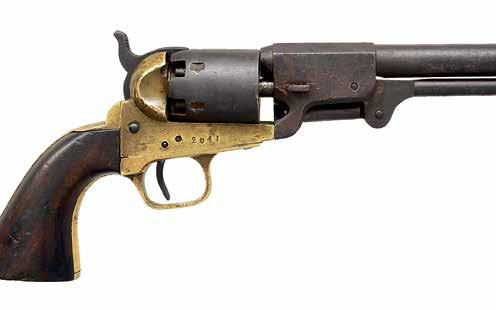



civilwar@poulinauctions.com | poulinauctions.com | 199 Skowhegan Rd, Fairfield, ME 04937 | 207-453-2114 Stephen Poulin, ME Lic # 1115 Accepting Consignments May 2022 Premier Auction May 6, 7, & 8, 2022 | Fairfield, ME Firearms & Militaria Auctioneers Visit poulinauctions.com to view the full prices realized of our Fall 2021 Premier Firearms & Militaria Auction 0% Or Better! Seller’s Commission On Expensive Items And Valuable Collections Newly Discovered Griswold Brass Frame Confederate Revolver, Possible Early Battlefield Recovery From Saylor’s Creek. (Est. $20,000 - $30,000) SOLD: $37,600 Rare Early Greensboro Georgia Confederate Government Contract Leech & Rigdon Revolver. (Est. $20,000 - $25,000) SOLD: $36,425 Confederate 2nd Model Griswold Revolver, Ex-Bill Gary Collection. (Est. $25,000 - $30,000) Very Fine 1864 Dated Confederate Fayetteville Rifle. (Est. $15,000 - $18,000) SOLD: $39,350 SOLD: $28,200 SOLD: $19,375 Massive And Well Known Highest Quality Confederate D-Guard Bowie Ex-Flayderman Collection. (Est. $8,000 - $12,000) SOLD: $16,450 Fine Civil War Henry Rifle Carried By Jacob Guseman, 6th West Virginia Cavalry. (Est. $22,500 - $32,500) Rare & Historic Civil War 35 Star Guidon For 2nd Mass Cavalry Made By A.W. Pollard, Boston, Mass. (Est. $10,000 - $20,000) SOLD: $24,675 Very Rare Confederate Used Mississippi Rifle “Gate City Guards” Atlanta, Ga. (Est. $4,000 - $6,000) SOLD: $18,800












































































































































 by Joan Wenner, J.D.
by Joan Wenner, J.D.






















 by Gregory L. Wade
by Gregory L. Wade

















































































































































 By Michael Brem Bonner and Peter McCord. Bibliography, index, notes, University of Tennessee Press, https://utpress.org, 2021, 217 pp., hardcover. $45.
By Michael Brem Bonner and Peter McCord. Bibliography, index, notes, University of Tennessee Press, https://utpress.org, 2021, 217 pp., hardcover. $45.








 Christian B. Keller, ed. U. Press of Kansas, https://kansaspress. ku.edu, 2021. Maps, illus., end notes, index. Hardcover, 296 pp. $34.95.
Reviewed by Ted Savas
Christian B. Keller, ed. U. Press of Kansas, https://kansaspress. ku.edu, 2021. Maps, illus., end notes, index. Hardcover, 296 pp. $34.95.
Reviewed by Ted Savas























































































